Quick filters:
Mao china 1967 Stock Photos and Images
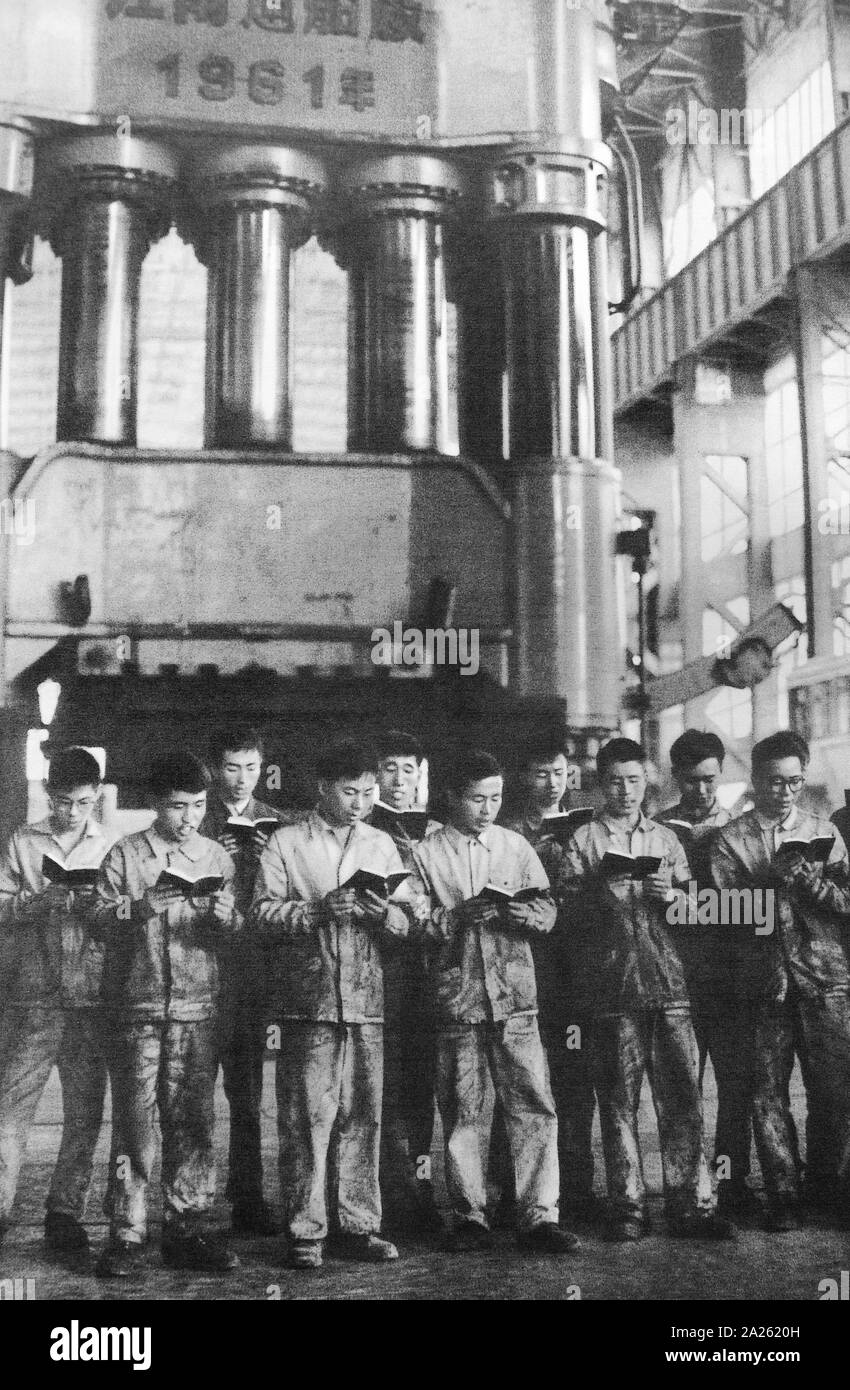 Factory workers read from the 'thoughts of chairman Mao', during the Cultural Revolution. China 1967 Stock Photohttps://www.alamy.com/image-license-details/?v=1https://www.alamy.com/factory-workers-read-from-the-thoughts-of-chairman-mao-during-the-cultural-revolution-china-1967-image328359601.html
Factory workers read from the 'thoughts of chairman Mao', during the Cultural Revolution. China 1967 Stock Photohttps://www.alamy.com/image-license-details/?v=1https://www.alamy.com/factory-workers-read-from-the-thoughts-of-chairman-mao-during-the-cultural-revolution-china-1967-image328359601.htmlRM2A2620H–Factory workers read from the 'thoughts of chairman Mao', during the Cultural Revolution. China 1967
 China: Persecution of a 'Capitalist Roader', Cultural Revolution (1966-1976), 1967. The Great Proletarian Cultural Revolution, commonly known as the Cultural Revolution (Chinese: 文化大革命), was a socio-political movement that took place in the People's Republic of China from 1966 through 1976. Set into motion by Mao Zedong, then Chairman of the Communist Party of China, its stated goal was to enforce socialism in the country by removing capitalist, traditional and cultural elements from Chinese society, and impose Maoist orthodoxy within the Party. Stock Photohttps://www.alamy.com/image-license-details/?v=1https://www.alamy.com/china-persecution-of-a-capitalist-roader-cultural-revolution-1966-1976-1967-the-great-proletarian-cultural-revolution-commonly-known-as-the-cultural-revolution-chinese-was-a-socio-political-movement-that-took-place-in-the-peoples-republic-of-china-from-1966-through-1976-set-into-motion-by-mao-zedong-then-chairman-of-the-communist-party-of-china-its-stated-goal-was-to-enforce-socialism-in-the-country-by-removing-capitalist-traditional-and-cultural-elements-from-chinese-society-and-impose-maoist-orthodoxy-within-the-party-image344240698.html
China: Persecution of a 'Capitalist Roader', Cultural Revolution (1966-1976), 1967. The Great Proletarian Cultural Revolution, commonly known as the Cultural Revolution (Chinese: 文化大革命), was a socio-political movement that took place in the People's Republic of China from 1966 through 1976. Set into motion by Mao Zedong, then Chairman of the Communist Party of China, its stated goal was to enforce socialism in the country by removing capitalist, traditional and cultural elements from Chinese society, and impose Maoist orthodoxy within the Party. Stock Photohttps://www.alamy.com/image-license-details/?v=1https://www.alamy.com/china-persecution-of-a-capitalist-roader-cultural-revolution-1966-1976-1967-the-great-proletarian-cultural-revolution-commonly-known-as-the-cultural-revolution-chinese-was-a-socio-political-movement-that-took-place-in-the-peoples-republic-of-china-from-1966-through-1976-set-into-motion-by-mao-zedong-then-chairman-of-the-communist-party-of-china-its-stated-goal-was-to-enforce-socialism-in-the-country-by-removing-capitalist-traditional-and-cultural-elements-from-chinese-society-and-impose-maoist-orthodoxy-within-the-party-image344240698.htmlRM2B01EEJ–China: Persecution of a 'Capitalist Roader', Cultural Revolution (1966-1976), 1967. The Great Proletarian Cultural Revolution, commonly known as the Cultural Revolution (Chinese: 文化大革命), was a socio-political movement that took place in the People's Republic of China from 1966 through 1976. Set into motion by Mao Zedong, then Chairman of the Communist Party of China, its stated goal was to enforce socialism in the country by removing capitalist, traditional and cultural elements from Chinese society, and impose Maoist orthodoxy within the Party.
 CHINA POSTER MAO 1967 Vintage Chinese Propaganda Poster, Chairman Mao Zedong 'Vast World of Accomplishments', Communist China Vintage Propaganda Poster Stock Photohttps://www.alamy.com/image-license-details/?v=1https://www.alamy.com/china-poster-mao-1967-vintage-chinese-propaganda-poster-chairman-mao-zedong-vast-world-of-accomplishments-communist-china-vintage-propaganda-poster-image260990132.html
CHINA POSTER MAO 1967 Vintage Chinese Propaganda Poster, Chairman Mao Zedong 'Vast World of Accomplishments', Communist China Vintage Propaganda Poster Stock Photohttps://www.alamy.com/image-license-details/?v=1https://www.alamy.com/china-poster-mao-1967-vintage-chinese-propaganda-poster-chairman-mao-zedong-vast-world-of-accomplishments-communist-china-vintage-propaganda-poster-image260990132.htmlRMW4H3G4–CHINA POSTER MAO 1967 Vintage Chinese Propaganda Poster, Chairman Mao Zedong 'Vast World of Accomplishments', Communist China Vintage Propaganda Poster
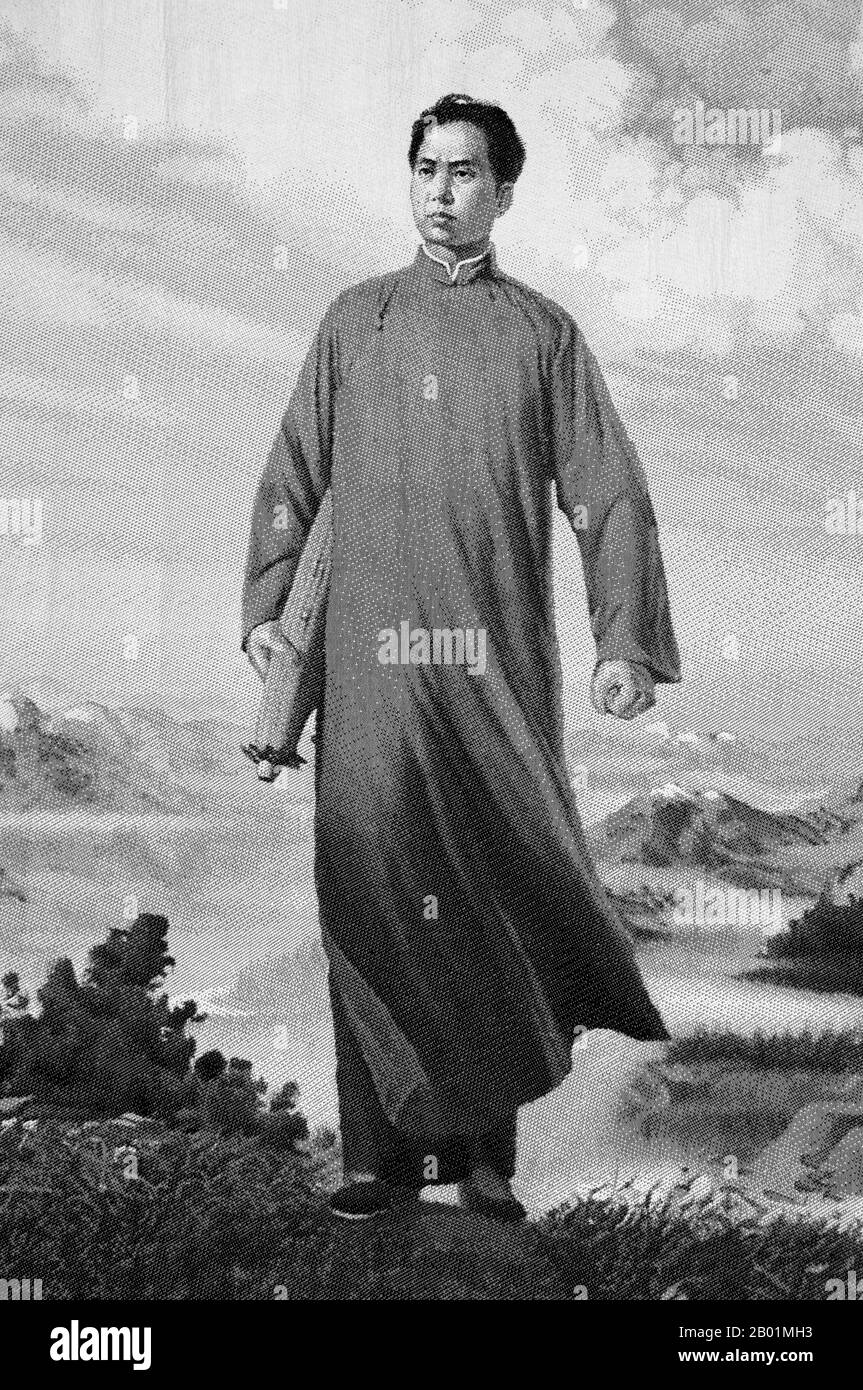 China: 'Chairman Mao en Route to Anyuan'. Copy of an oil on canvas painting by Liu Chunhua (1944-), Zunyi Conference Hall Revolutionary Museum, Zunyi, Guizhou Province, 1967. This oil painting depicts a young Mao during the Anyuan Miners' Strike of 1922, a defining moment for the nascent Chinese Communist Party. Mao helped to organise a nonviolent strike of thirteen thousand workers, a majority of which subsequently enlisted in the Red Army as soldiers. Mao Zedong (26 December 1893 - 9 September 1976), also transliterated as Mao Tse-tung, was a Chinese communist revolutionary and leader. Stock Photohttps://www.alamy.com/image-license-details/?v=1https://www.alamy.com/china-chairman-mao-en-route-to-anyuan-copy-of-an-oil-on-canvas-painting-by-liu-chunhua-1944-zunyi-conference-hall-revolutionary-museum-zunyi-guizhou-province-1967-this-oil-painting-depicts-a-young-mao-during-the-anyuan-miners-strike-of-1922-a-defining-moment-for-the-nascent-chinese-communist-party-mao-helped-to-organise-a-nonviolent-strike-of-thirteen-thousand-workers-a-majority-of-which-subsequently-enlisted-in-the-red-army-as-soldiers-mao-zedong-26-december-1893-9-september-1976-also-transliterated-as-mao-tse-tung-was-a-chinese-communist-revolutionary-and-leader-image344245471.html
China: 'Chairman Mao en Route to Anyuan'. Copy of an oil on canvas painting by Liu Chunhua (1944-), Zunyi Conference Hall Revolutionary Museum, Zunyi, Guizhou Province, 1967. This oil painting depicts a young Mao during the Anyuan Miners' Strike of 1922, a defining moment for the nascent Chinese Communist Party. Mao helped to organise a nonviolent strike of thirteen thousand workers, a majority of which subsequently enlisted in the Red Army as soldiers. Mao Zedong (26 December 1893 - 9 September 1976), also transliterated as Mao Tse-tung, was a Chinese communist revolutionary and leader. Stock Photohttps://www.alamy.com/image-license-details/?v=1https://www.alamy.com/china-chairman-mao-en-route-to-anyuan-copy-of-an-oil-on-canvas-painting-by-liu-chunhua-1944-zunyi-conference-hall-revolutionary-museum-zunyi-guizhou-province-1967-this-oil-painting-depicts-a-young-mao-during-the-anyuan-miners-strike-of-1922-a-defining-moment-for-the-nascent-chinese-communist-party-mao-helped-to-organise-a-nonviolent-strike-of-thirteen-thousand-workers-a-majority-of-which-subsequently-enlisted-in-the-red-army-as-soldiers-mao-zedong-26-december-1893-9-september-1976-also-transliterated-as-mao-tse-tung-was-a-chinese-communist-revolutionary-and-leader-image344245471.htmlRM2B01MH3–China: 'Chairman Mao en Route to Anyuan'. Copy of an oil on canvas painting by Liu Chunhua (1944-), Zunyi Conference Hall Revolutionary Museum, Zunyi, Guizhou Province, 1967. This oil painting depicts a young Mao during the Anyuan Miners' Strike of 1922, a defining moment for the nascent Chinese Communist Party. Mao helped to organise a nonviolent strike of thirteen thousand workers, a majority of which subsequently enlisted in the Red Army as soldiers. Mao Zedong (26 December 1893 - 9 September 1976), also transliterated as Mao Tse-tung, was a Chinese communist revolutionary and leader.
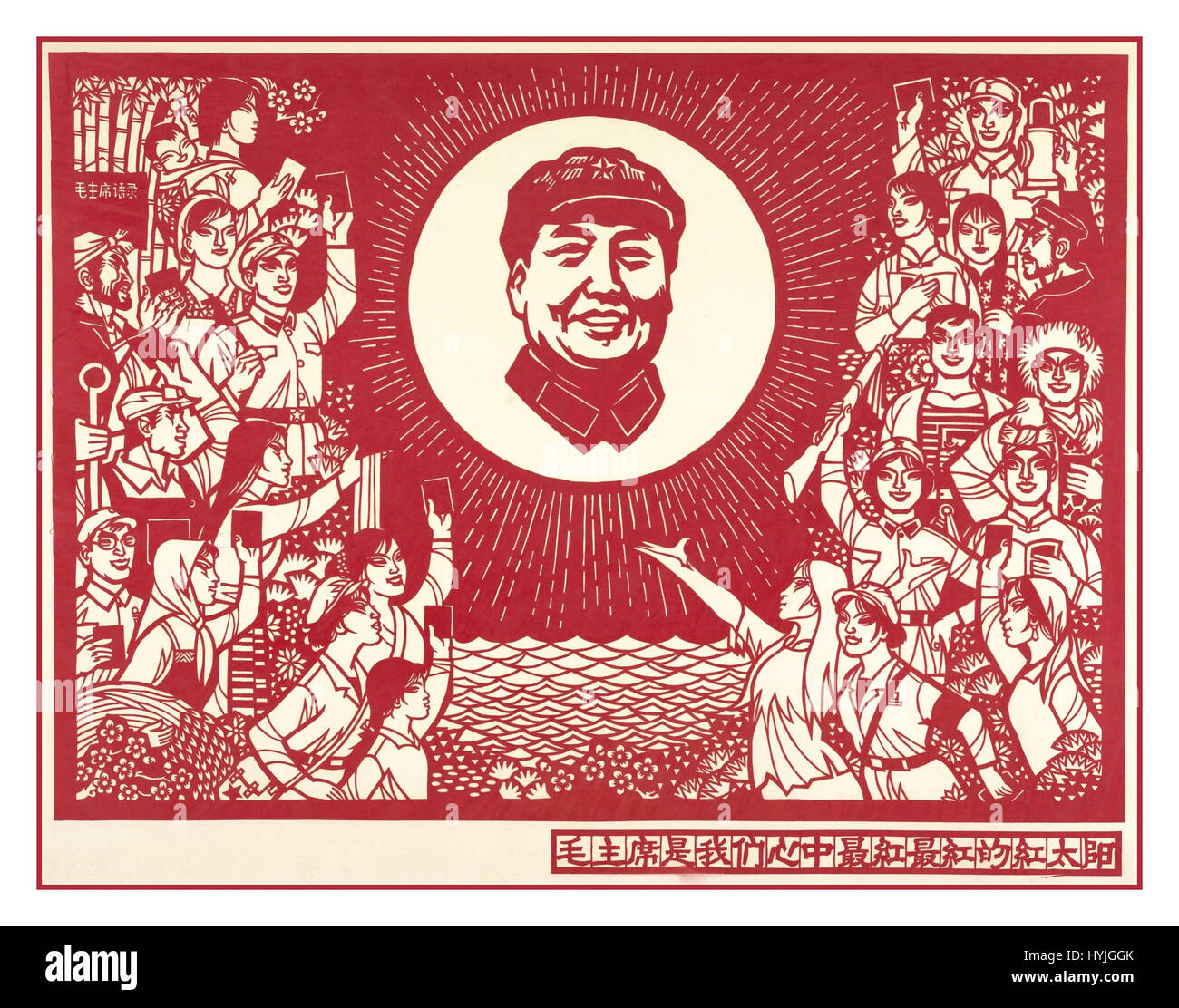 Classic vintage Chinese propaganda poster titled 'Chairman Mao is the Reddest, Reddest Sun in Our Heart' 1967. Stock Photohttps://www.alamy.com/image-license-details/?v=1https://www.alamy.com/stock-photo-classic-vintage-chinese-propaganda-poster-titled-chairman-mao-is-the-137476435.html
Classic vintage Chinese propaganda poster titled 'Chairman Mao is the Reddest, Reddest Sun in Our Heart' 1967. Stock Photohttps://www.alamy.com/image-license-details/?v=1https://www.alamy.com/stock-photo-classic-vintage-chinese-propaganda-poster-titled-chairman-mao-is-the-137476435.htmlRMHYJGGK–Classic vintage Chinese propaganda poster titled 'Chairman Mao is the Reddest, Reddest Sun in Our Heart' 1967.
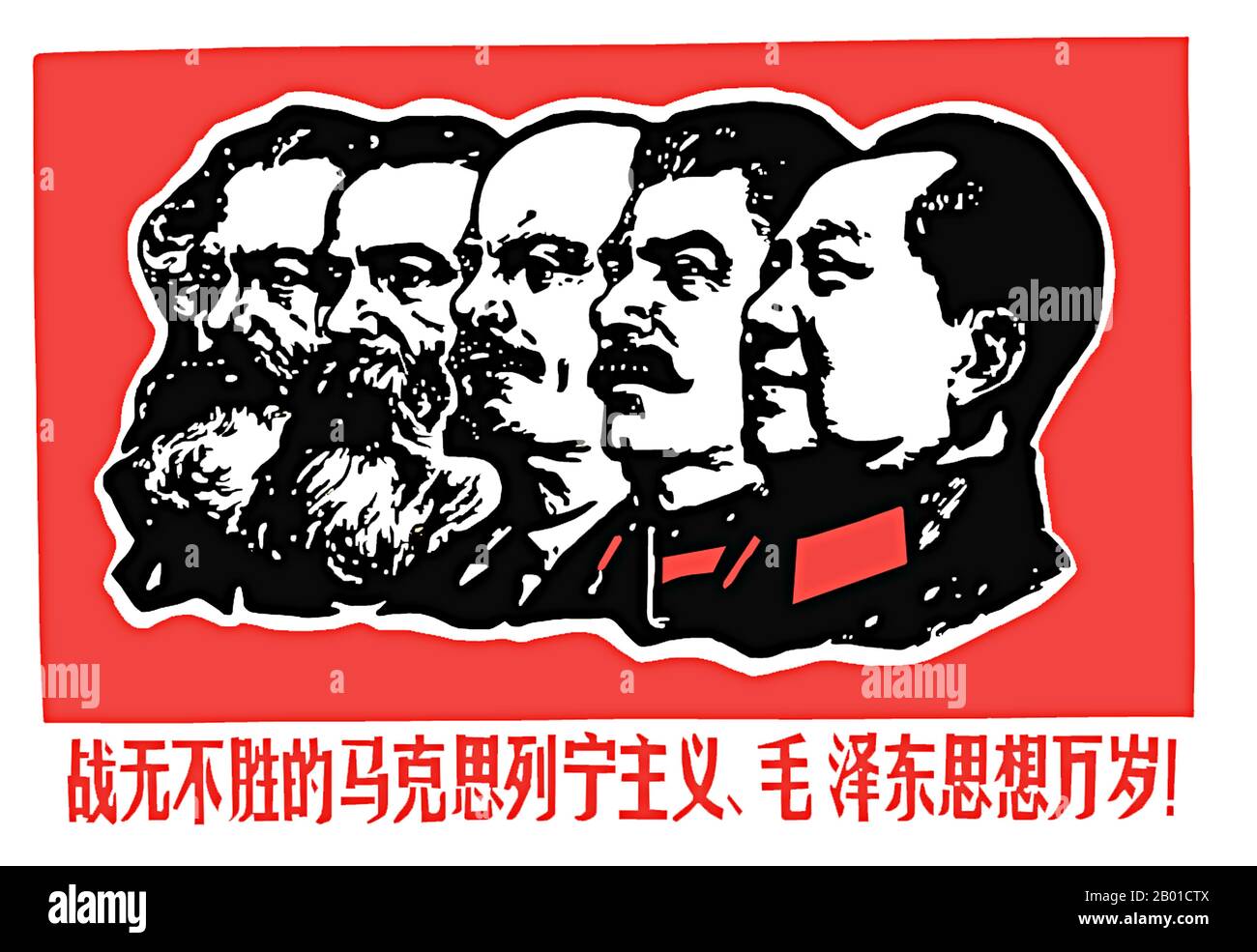 China: Revolutionary Poster 'Long Live the Invincible Marxism, Leninism and Mao Zedong Thought!', 1967. A revolutionary poster from communist China near the start of the Cultural Revolution (1966-1976) featuring (left to right): Karl Marx, Friedrich Engels, Vladimir Ilych Lenin, Joseph Stalin and Mao Zedong. 'Mao Zedong Thought', generally shortened to 'Maoism', played a central part in the politics of the 'Great Proletarian Cultural Revolution' and is most famously reflected in the 'Little Red Book'. Stock Photohttps://www.alamy.com/image-license-details/?v=1https://www.alamy.com/china-revolutionary-poster-long-live-the-invincible-marxism-leninism-and-mao-zedong-thought!-1967-a-revolutionary-poster-from-communist-china-near-the-start-of-the-cultural-revolution-1966-1976-featuring-left-to-right-karl-marx-friedrich-engels-vladimir-ilych-lenin-joseph-stalin-and-mao-zedong-mao-zedong-thought-generally-shortened-to-maoism-played-a-central-part-in-the-politics-of-the-great-proletarian-cultural-revolution-and-is-most-famously-reflected-in-the-little-red-book-image344239418.html
China: Revolutionary Poster 'Long Live the Invincible Marxism, Leninism and Mao Zedong Thought!', 1967. A revolutionary poster from communist China near the start of the Cultural Revolution (1966-1976) featuring (left to right): Karl Marx, Friedrich Engels, Vladimir Ilych Lenin, Joseph Stalin and Mao Zedong. 'Mao Zedong Thought', generally shortened to 'Maoism', played a central part in the politics of the 'Great Proletarian Cultural Revolution' and is most famously reflected in the 'Little Red Book'. Stock Photohttps://www.alamy.com/image-license-details/?v=1https://www.alamy.com/china-revolutionary-poster-long-live-the-invincible-marxism-leninism-and-mao-zedong-thought!-1967-a-revolutionary-poster-from-communist-china-near-the-start-of-the-cultural-revolution-1966-1976-featuring-left-to-right-karl-marx-friedrich-engels-vladimir-ilych-lenin-joseph-stalin-and-mao-zedong-mao-zedong-thought-generally-shortened-to-maoism-played-a-central-part-in-the-politics-of-the-great-proletarian-cultural-revolution-and-is-most-famously-reflected-in-the-little-red-book-image344239418.htmlRM2B01CTX–China: Revolutionary Poster 'Long Live the Invincible Marxism, Leninism and Mao Zedong Thought!', 1967. A revolutionary poster from communist China near the start of the Cultural Revolution (1966-1976) featuring (left to right): Karl Marx, Friedrich Engels, Vladimir Ilych Lenin, Joseph Stalin and Mao Zedong. 'Mao Zedong Thought', generally shortened to 'Maoism', played a central part in the politics of the 'Great Proletarian Cultural Revolution' and is most famously reflected in the 'Little Red Book'.
 Vintage Chinese Propaganda Poster with an imposing profile graphic of Chairman Mao ‘The force at the core leading our cause forward is the Chinese Communist Party. The theoretical basis guiding our thinking is Marxism-Leninism’ CHINESE COMMUNIST POSTER. Chinese poster, 1967, honouring Mao Tse-Tung (1898-1976) and his 'Little Red Book' ('Quotations and thoughts from Chairman Mao'). Stock Photohttps://www.alamy.com/image-license-details/?v=1https://www.alamy.com/vintage-chinese-propaganda-poster-with-an-imposing-profile-graphic-of-chairman-mao-the-force-at-the-core-leading-our-cause-forward-is-the-chinese-communist-party-the-theoretical-basis-guiding-our-thinking-is-marxism-leninism-chinese-communist-poster-chinese-poster-1967-honouring-mao-tse-tung-1898-1976-and-his-little-red-book-quotations-and-thoughts-from-chairman-mao-image402524443.html
Vintage Chinese Propaganda Poster with an imposing profile graphic of Chairman Mao ‘The force at the core leading our cause forward is the Chinese Communist Party. The theoretical basis guiding our thinking is Marxism-Leninism’ CHINESE COMMUNIST POSTER. Chinese poster, 1967, honouring Mao Tse-Tung (1898-1976) and his 'Little Red Book' ('Quotations and thoughts from Chairman Mao'). Stock Photohttps://www.alamy.com/image-license-details/?v=1https://www.alamy.com/vintage-chinese-propaganda-poster-with-an-imposing-profile-graphic-of-chairman-mao-the-force-at-the-core-leading-our-cause-forward-is-the-chinese-communist-party-the-theoretical-basis-guiding-our-thinking-is-marxism-leninism-chinese-communist-poster-chinese-poster-1967-honouring-mao-tse-tung-1898-1976-and-his-little-red-book-quotations-and-thoughts-from-chairman-mao-image402524443.htmlRM2EATG0Y–Vintage Chinese Propaganda Poster with an imposing profile graphic of Chairman Mao ‘The force at the core leading our cause forward is the Chinese Communist Party. The theoretical basis guiding our thinking is Marxism-Leninism’ CHINESE COMMUNIST POSTER. Chinese poster, 1967, honouring Mao Tse-Tung (1898-1976) and his 'Little Red Book' ('Quotations and thoughts from Chairman Mao').
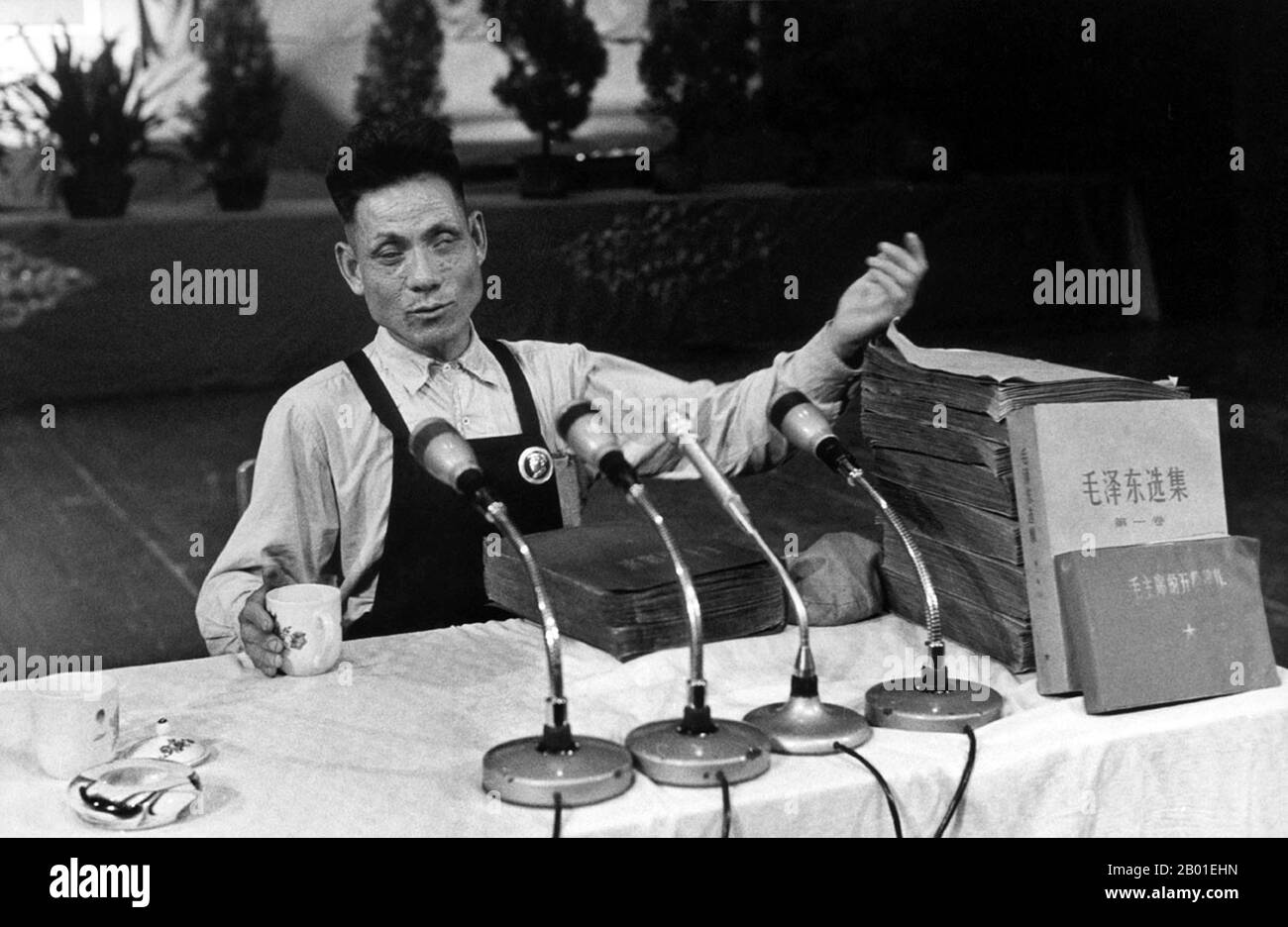 China: Scene from the Cultural Revolution (1966-1976), captioned 'Blind activist learning and using Mao Zedong Thought', 1967. The Great Proletarian Cultural Revolution, commonly known as the Cultural Revolution (Chinese: 文化大革命), was a socio-political movement that took place in the People's Republic of China from 1966 through 1976. Set into motion by Mao Zedong, then Chairman of the Communist Party of China, its stated goal was to enforce socialism in the country by removing capitalist, traditional and cultural elements from Chinese society, and impose Maoist orthodoxy within the Party. Stock Photohttps://www.alamy.com/image-license-details/?v=1https://www.alamy.com/china-scene-from-the-cultural-revolution-1966-1976-captioned-blind-activist-learning-and-using-mao-zedong-thought-1967-the-great-proletarian-cultural-revolution-commonly-known-as-the-cultural-revolution-chinese-was-a-socio-political-movement-that-took-place-in-the-peoples-republic-of-china-from-1966-through-1976-set-into-motion-by-mao-zedong-then-chairman-of-the-communist-party-of-china-its-stated-goal-was-to-enforce-socialism-in-the-country-by-removing-capitalist-traditional-and-cultural-elements-from-chinese-society-and-impose-maoist-orthodoxy-within-the-party-image344240785.html
China: Scene from the Cultural Revolution (1966-1976), captioned 'Blind activist learning and using Mao Zedong Thought', 1967. The Great Proletarian Cultural Revolution, commonly known as the Cultural Revolution (Chinese: 文化大革命), was a socio-political movement that took place in the People's Republic of China from 1966 through 1976. Set into motion by Mao Zedong, then Chairman of the Communist Party of China, its stated goal was to enforce socialism in the country by removing capitalist, traditional and cultural elements from Chinese society, and impose Maoist orthodoxy within the Party. Stock Photohttps://www.alamy.com/image-license-details/?v=1https://www.alamy.com/china-scene-from-the-cultural-revolution-1966-1976-captioned-blind-activist-learning-and-using-mao-zedong-thought-1967-the-great-proletarian-cultural-revolution-commonly-known-as-the-cultural-revolution-chinese-was-a-socio-political-movement-that-took-place-in-the-peoples-republic-of-china-from-1966-through-1976-set-into-motion-by-mao-zedong-then-chairman-of-the-communist-party-of-china-its-stated-goal-was-to-enforce-socialism-in-the-country-by-removing-capitalist-traditional-and-cultural-elements-from-chinese-society-and-impose-maoist-orthodoxy-within-the-party-image344240785.htmlRM2B01EHN–China: Scene from the Cultural Revolution (1966-1976), captioned 'Blind activist learning and using Mao Zedong Thought', 1967. The Great Proletarian Cultural Revolution, commonly known as the Cultural Revolution (Chinese: 文化大革命), was a socio-political movement that took place in the People's Republic of China from 1966 through 1976. Set into motion by Mao Zedong, then Chairman of the Communist Party of China, its stated goal was to enforce socialism in the country by removing capitalist, traditional and cultural elements from Chinese society, and impose Maoist orthodoxy within the Party.
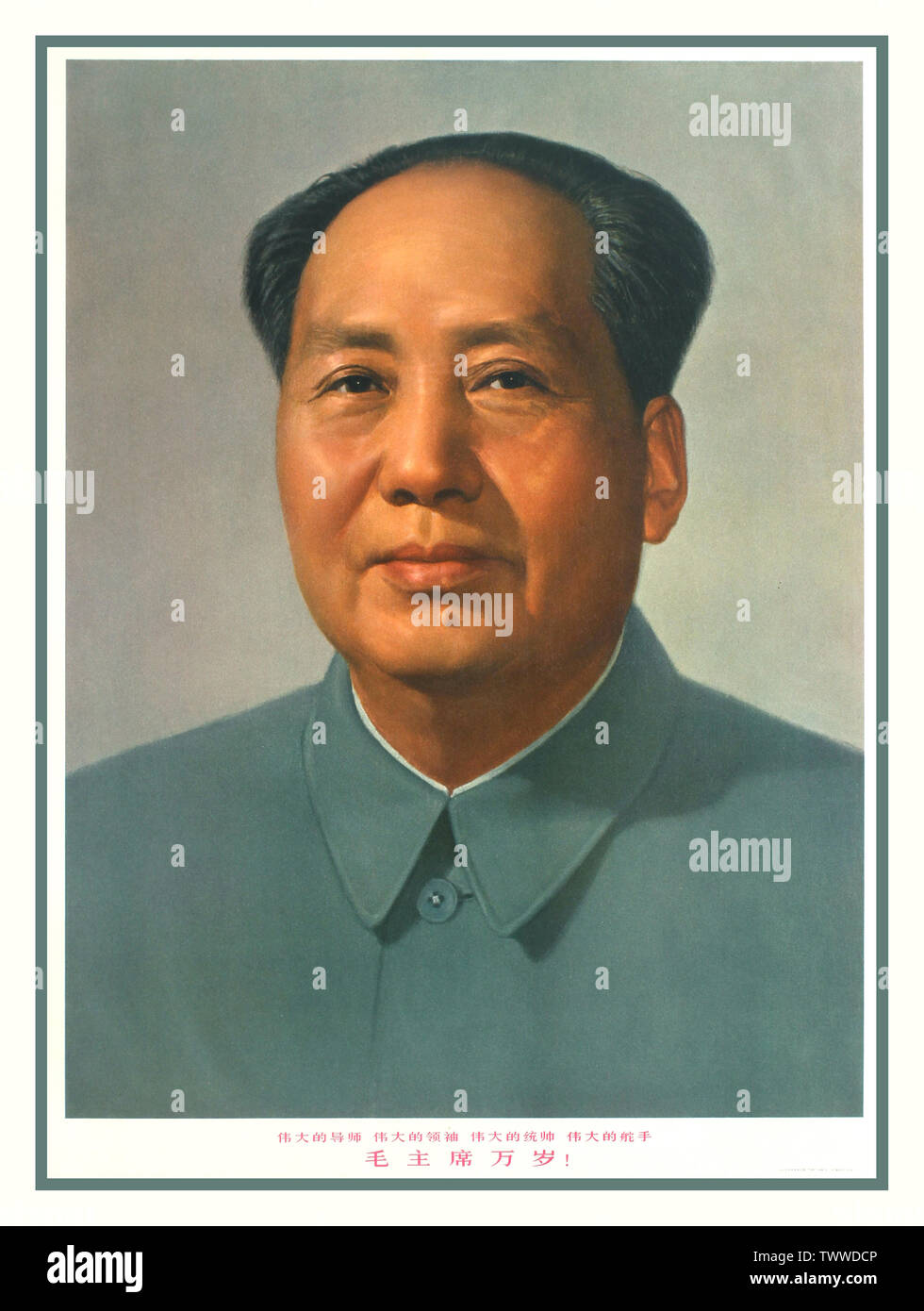 Chairman Mao Chinese Propaganda poster published in 1969 featuring an official portrait of Mao Zedong, Great Mentor, Great Leader, Great Commander, Great Statesman. China, 1967, Mao Zedong (December 26, 1893 – September 9, 1976), also known as Chairman Mao, was a Chinese communist revolutionary who became the founding father of the People's Republic of China, which he ruled as the Chairman of the Communist Party of China from its establishment in 1949 until his death in 1976. His theories, military strategies, and political policies are collectively known as Maoism. Stock Photohttps://www.alamy.com/image-license-details/?v=1https://www.alamy.com/chairman-mao-chinese-propaganda-poster-published-in-1969-featuring-an-official-portrait-of-mao-zedong-great-mentor-great-leader-great-commander-great-statesman-china-1967-mao-zedong-december-26-1893-september-9-1976-also-known-as-chairman-mao-was-a-chinese-communist-revolutionary-who-became-the-founding-father-of-the-peoples-republic-of-china-which-he-ruled-as-the-chairman-of-the-communist-party-of-china-from-its-establishment-in-1949-until-his-death-in-1976-his-theories-military-strategies-and-political-policies-are-collectively-known-as-maoism-image256870902.html
Chairman Mao Chinese Propaganda poster published in 1969 featuring an official portrait of Mao Zedong, Great Mentor, Great Leader, Great Commander, Great Statesman. China, 1967, Mao Zedong (December 26, 1893 – September 9, 1976), also known as Chairman Mao, was a Chinese communist revolutionary who became the founding father of the People's Republic of China, which he ruled as the Chairman of the Communist Party of China from its establishment in 1949 until his death in 1976. His theories, military strategies, and political policies are collectively known as Maoism. Stock Photohttps://www.alamy.com/image-license-details/?v=1https://www.alamy.com/chairman-mao-chinese-propaganda-poster-published-in-1969-featuring-an-official-portrait-of-mao-zedong-great-mentor-great-leader-great-commander-great-statesman-china-1967-mao-zedong-december-26-1893-september-9-1976-also-known-as-chairman-mao-was-a-chinese-communist-revolutionary-who-became-the-founding-father-of-the-peoples-republic-of-china-which-he-ruled-as-the-chairman-of-the-communist-party-of-china-from-its-establishment-in-1949-until-his-death-in-1976-his-theories-military-strategies-and-political-policies-are-collectively-known-as-maoism-image256870902.htmlRMTWWDCP–Chairman Mao Chinese Propaganda poster published in 1969 featuring an official portrait of Mao Zedong, Great Mentor, Great Leader, Great Commander, Great Statesman. China, 1967, Mao Zedong (December 26, 1893 – September 9, 1976), also known as Chairman Mao, was a Chinese communist revolutionary who became the founding father of the People's Republic of China, which he ruled as the Chairman of the Communist Party of China from its establishment in 1949 until his death in 1976. His theories, military strategies, and political policies are collectively known as Maoism.
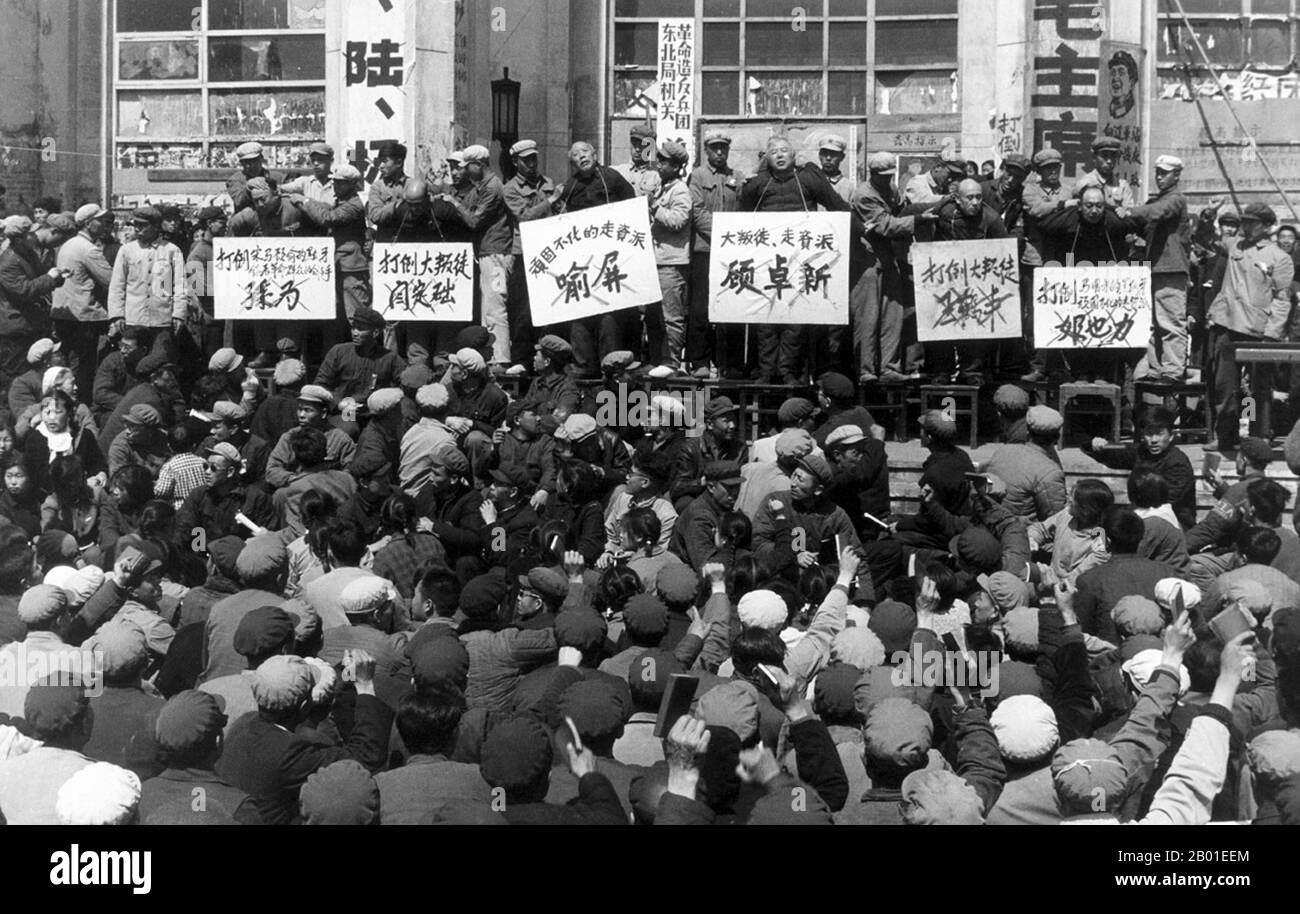 China: A meeting to denounce 'Rightists' and 'Capitalist Roaders', scene from the Cultural Revolution (1966-1967), c. 1968. The Great Proletarian Cultural Revolution, commonly known as the Cultural Revolution (Chinese: 文化大革命), was a socio-political movement that took place in the People's Republic of China from 1966 through 1976. Set into motion by Mao Zedong, then Chairman of the Communist Party of China, its stated goal was to enforce socialism in the country by removing capitalist, traditional and cultural elements from Chinese society, and impose Maoist orthodoxy within the Party. Stock Photohttps://www.alamy.com/image-license-details/?v=1https://www.alamy.com/china-a-meeting-to-denounce-rightists-and-capitalist-roaders-scene-from-the-cultural-revolution-1966-1967-c-1968-the-great-proletarian-cultural-revolution-commonly-known-as-the-cultural-revolution-chinese-was-a-socio-political-movement-that-took-place-in-the-peoples-republic-of-china-from-1966-through-1976-set-into-motion-by-mao-zedong-then-chairman-of-the-communist-party-of-china-its-stated-goal-was-to-enforce-socialism-in-the-country-by-removing-capitalist-traditional-and-cultural-elements-from-chinese-society-and-impose-maoist-orthodoxy-within-the-party-image344240700.html
China: A meeting to denounce 'Rightists' and 'Capitalist Roaders', scene from the Cultural Revolution (1966-1967), c. 1968. The Great Proletarian Cultural Revolution, commonly known as the Cultural Revolution (Chinese: 文化大革命), was a socio-political movement that took place in the People's Republic of China from 1966 through 1976. Set into motion by Mao Zedong, then Chairman of the Communist Party of China, its stated goal was to enforce socialism in the country by removing capitalist, traditional and cultural elements from Chinese society, and impose Maoist orthodoxy within the Party. Stock Photohttps://www.alamy.com/image-license-details/?v=1https://www.alamy.com/china-a-meeting-to-denounce-rightists-and-capitalist-roaders-scene-from-the-cultural-revolution-1966-1967-c-1968-the-great-proletarian-cultural-revolution-commonly-known-as-the-cultural-revolution-chinese-was-a-socio-political-movement-that-took-place-in-the-peoples-republic-of-china-from-1966-through-1976-set-into-motion-by-mao-zedong-then-chairman-of-the-communist-party-of-china-its-stated-goal-was-to-enforce-socialism-in-the-country-by-removing-capitalist-traditional-and-cultural-elements-from-chinese-society-and-impose-maoist-orthodoxy-within-the-party-image344240700.htmlRM2B01EEM–China: A meeting to denounce 'Rightists' and 'Capitalist Roaders', scene from the Cultural Revolution (1966-1967), c. 1968. The Great Proletarian Cultural Revolution, commonly known as the Cultural Revolution (Chinese: 文化大革命), was a socio-political movement that took place in the People's Republic of China from 1966 through 1976. Set into motion by Mao Zedong, then Chairman of the Communist Party of China, its stated goal was to enforce socialism in the country by removing capitalist, traditional and cultural elements from Chinese society, and impose Maoist orthodoxy within the Party.
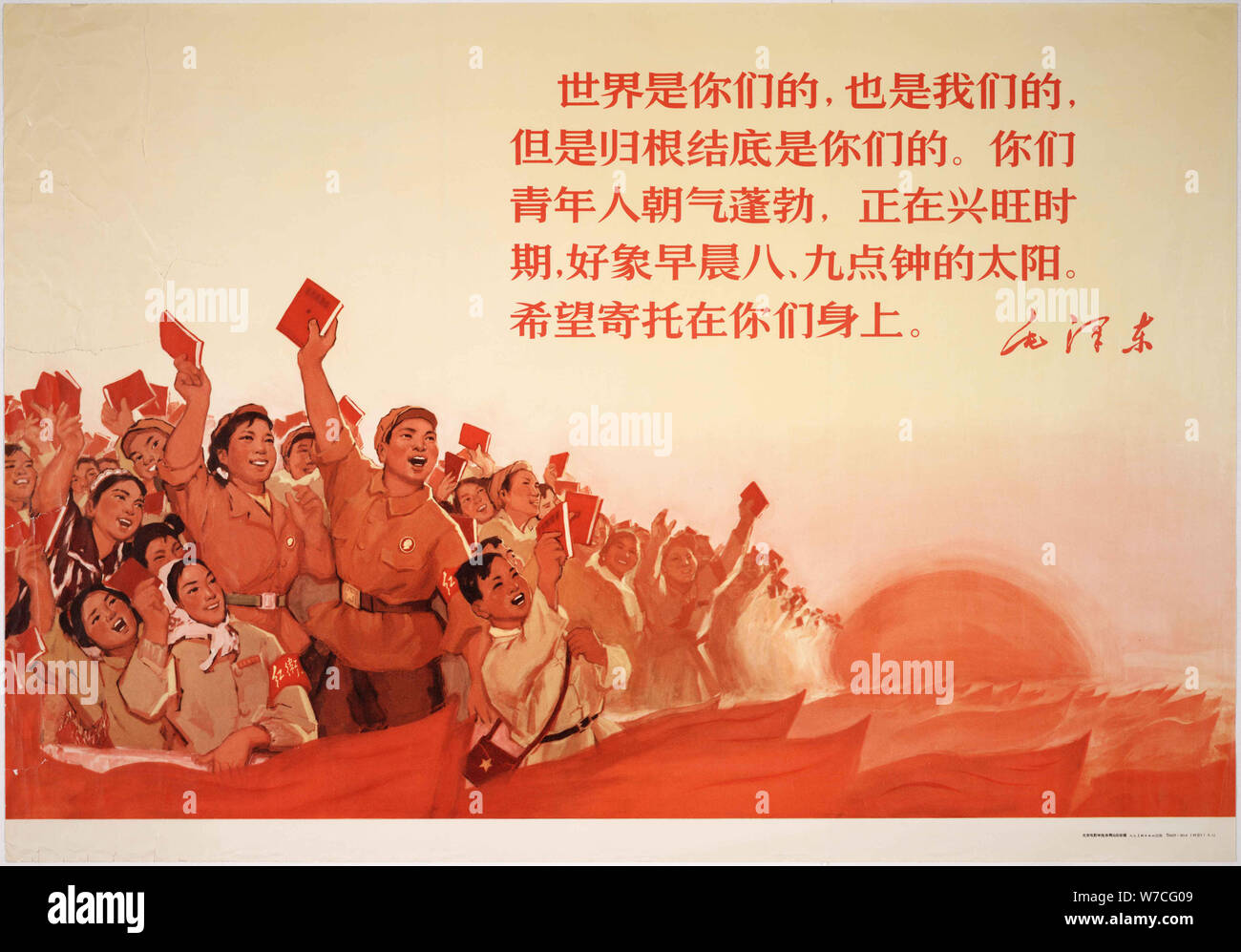 Mao Zedong: The world is yours, as well as ours, 1967. Stock Photohttps://www.alamy.com/image-license-details/?v=1https://www.alamy.com/mao-zedong-the-world-is-yours-as-well-as-ours-1967-image262734089.html
Mao Zedong: The world is yours, as well as ours, 1967. Stock Photohttps://www.alamy.com/image-license-details/?v=1https://www.alamy.com/mao-zedong-the-world-is-yours-as-well-as-ours-1967-image262734089.htmlRMW7CG09–Mao Zedong: The world is yours, as well as ours, 1967.
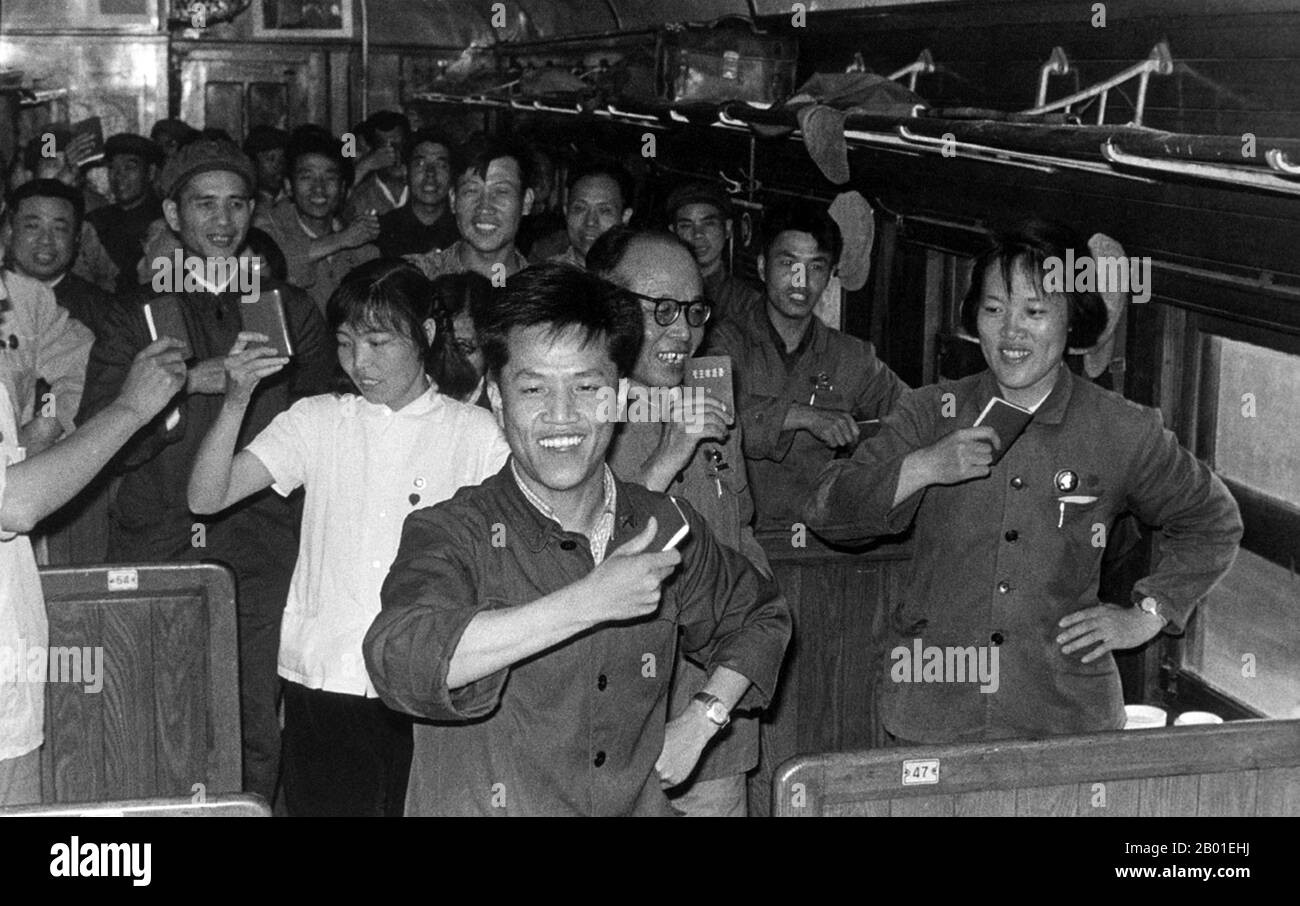 China: Scene from the Cultural Revolution (1966-1976), passengers on a train wave their copies of the 'Little Red Book' containing the selected thoughts of Chairman Mao Zedong, 1967. The Great Proletarian Cultural Revolution, commonly known as the Cultural Revolution (Chinese: 文化大革命), was a socio-political movement that took place in the People's Republic of China from 1966 through 1976. Set into motion by Mao Zedong, then Chairman of the Communist Party of China, its stated goal was to enforce socialism in the country by removing capitalist, traditional and cultural elements from society. Stock Photohttps://www.alamy.com/image-license-details/?v=1https://www.alamy.com/china-scene-from-the-cultural-revolution-1966-1976-passengers-on-a-train-wave-their-copies-of-the-little-red-book-containing-the-selected-thoughts-of-chairman-mao-zedong-1967-the-great-proletarian-cultural-revolution-commonly-known-as-the-cultural-revolution-chinese-was-a-socio-political-movement-that-took-place-in-the-peoples-republic-of-china-from-1966-through-1976-set-into-motion-by-mao-zedong-then-chairman-of-the-communist-party-of-china-its-stated-goal-was-to-enforce-socialism-in-the-country-by-removing-capitalist-traditional-and-cultural-elements-from-society-image344240782.html
China: Scene from the Cultural Revolution (1966-1976), passengers on a train wave their copies of the 'Little Red Book' containing the selected thoughts of Chairman Mao Zedong, 1967. The Great Proletarian Cultural Revolution, commonly known as the Cultural Revolution (Chinese: 文化大革命), was a socio-political movement that took place in the People's Republic of China from 1966 through 1976. Set into motion by Mao Zedong, then Chairman of the Communist Party of China, its stated goal was to enforce socialism in the country by removing capitalist, traditional and cultural elements from society. Stock Photohttps://www.alamy.com/image-license-details/?v=1https://www.alamy.com/china-scene-from-the-cultural-revolution-1966-1976-passengers-on-a-train-wave-their-copies-of-the-little-red-book-containing-the-selected-thoughts-of-chairman-mao-zedong-1967-the-great-proletarian-cultural-revolution-commonly-known-as-the-cultural-revolution-chinese-was-a-socio-political-movement-that-took-place-in-the-peoples-republic-of-china-from-1966-through-1976-set-into-motion-by-mao-zedong-then-chairman-of-the-communist-party-of-china-its-stated-goal-was-to-enforce-socialism-in-the-country-by-removing-capitalist-traditional-and-cultural-elements-from-society-image344240782.htmlRM2B01EHJ–China: Scene from the Cultural Revolution (1966-1976), passengers on a train wave their copies of the 'Little Red Book' containing the selected thoughts of Chairman Mao Zedong, 1967. The Great Proletarian Cultural Revolution, commonly known as the Cultural Revolution (Chinese: 文化大革命), was a socio-political movement that took place in the People's Republic of China from 1966 through 1976. Set into motion by Mao Zedong, then Chairman of the Communist Party of China, its stated goal was to enforce socialism in the country by removing capitalist, traditional and cultural elements from society.
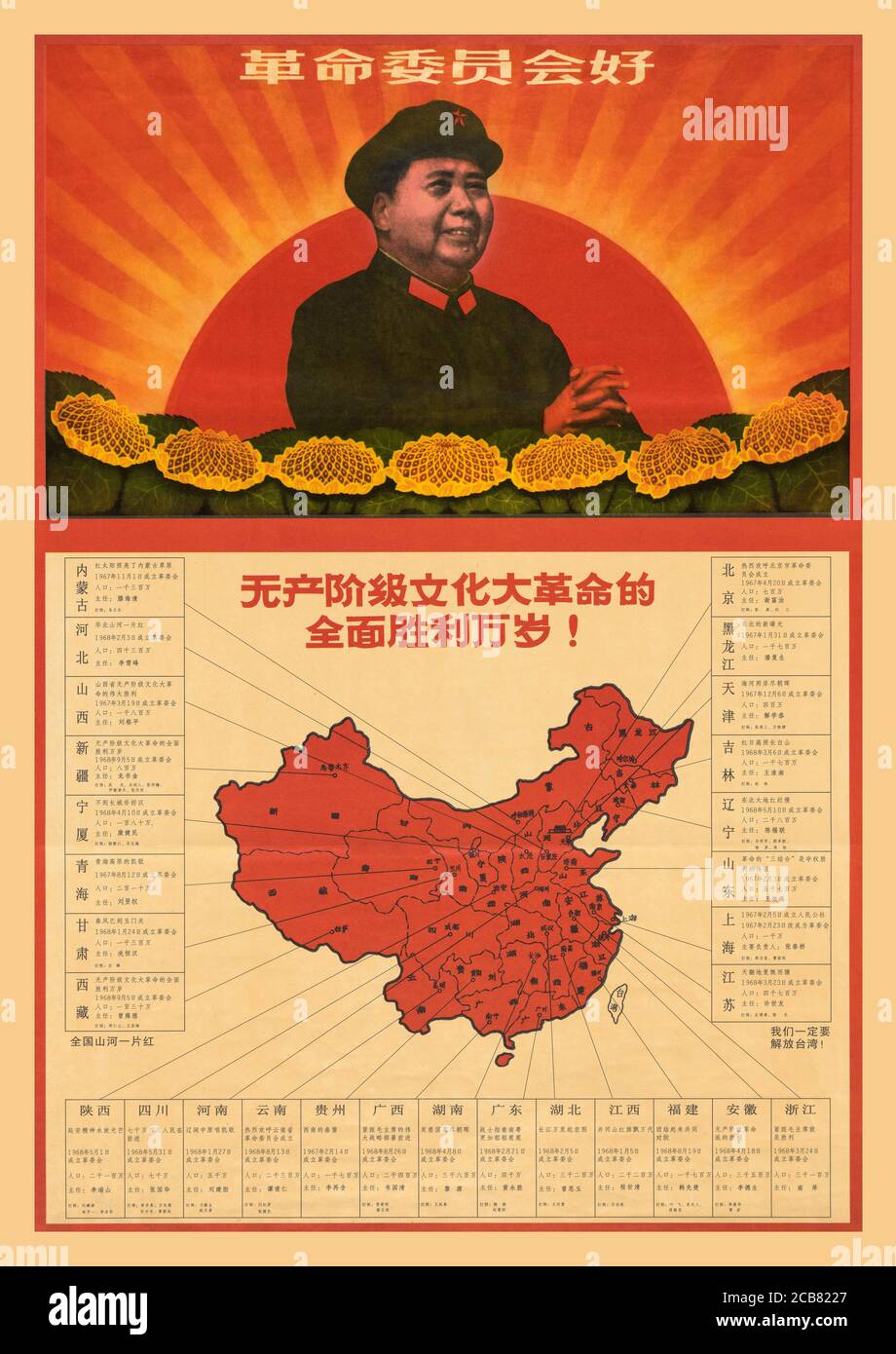 Vintage 1960’s China Chinese Cultural Revolution Propaganda poster map celebrating September 5, 1968, when mass 'Seize Power' movement of the Cultural Revolution succeeded replacing of established governments by 'Revolutionary Committees' in the last two of China's 29 administrative regions, the provinces of Tibet and Xinjiang. In the 'January Storm' of 1967, forces of the Cultural Revolution overthrew the Shanghai government replacing with a 'People's Commune.' Chairman Mao's subsequent endorsement of the overthrow began a violent movement of mass revolutionary organizations to 'Seize Power' Stock Photohttps://www.alamy.com/image-license-details/?v=1https://www.alamy.com/vintage-1960s-china-chinese-cultural-revolution-propaganda-poster-map-celebrating-september-5-1968-when-mass-seize-power-movement-of-the-cultural-revolution-succeeded-replacing-of-established-governments-by-revolutionary-committees-in-the-last-two-of-chinas-29-administrative-regions-the-provinces-of-tibet-and-xinjiang-in-the-january-storm-of-1967-forces-of-the-cultural-revolution-overthrew-the-shanghai-government-replacing-with-a-peoples-commune-chairman-maos-subsequent-endorsement-of-the-overthrow-began-a-violent-movement-of-mass-revolutionary-organizations-to-seize-power-image368356191.html
Vintage 1960’s China Chinese Cultural Revolution Propaganda poster map celebrating September 5, 1968, when mass 'Seize Power' movement of the Cultural Revolution succeeded replacing of established governments by 'Revolutionary Committees' in the last two of China's 29 administrative regions, the provinces of Tibet and Xinjiang. In the 'January Storm' of 1967, forces of the Cultural Revolution overthrew the Shanghai government replacing with a 'People's Commune.' Chairman Mao's subsequent endorsement of the overthrow began a violent movement of mass revolutionary organizations to 'Seize Power' Stock Photohttps://www.alamy.com/image-license-details/?v=1https://www.alamy.com/vintage-1960s-china-chinese-cultural-revolution-propaganda-poster-map-celebrating-september-5-1968-when-mass-seize-power-movement-of-the-cultural-revolution-succeeded-replacing-of-established-governments-by-revolutionary-committees-in-the-last-two-of-chinas-29-administrative-regions-the-provinces-of-tibet-and-xinjiang-in-the-january-storm-of-1967-forces-of-the-cultural-revolution-overthrew-the-shanghai-government-replacing-with-a-peoples-commune-chairman-maos-subsequent-endorsement-of-the-overthrow-began-a-violent-movement-of-mass-revolutionary-organizations-to-seize-power-image368356191.htmlRM2CB8227–Vintage 1960’s China Chinese Cultural Revolution Propaganda poster map celebrating September 5, 1968, when mass 'Seize Power' movement of the Cultural Revolution succeeded replacing of established governments by 'Revolutionary Committees' in the last two of China's 29 administrative regions, the provinces of Tibet and Xinjiang. In the 'January Storm' of 1967, forces of the Cultural Revolution overthrew the Shanghai government replacing with a 'People's Commune.' Chairman Mao's subsequent endorsement of the overthrow began a violent movement of mass revolutionary organizations to 'Seize Power'
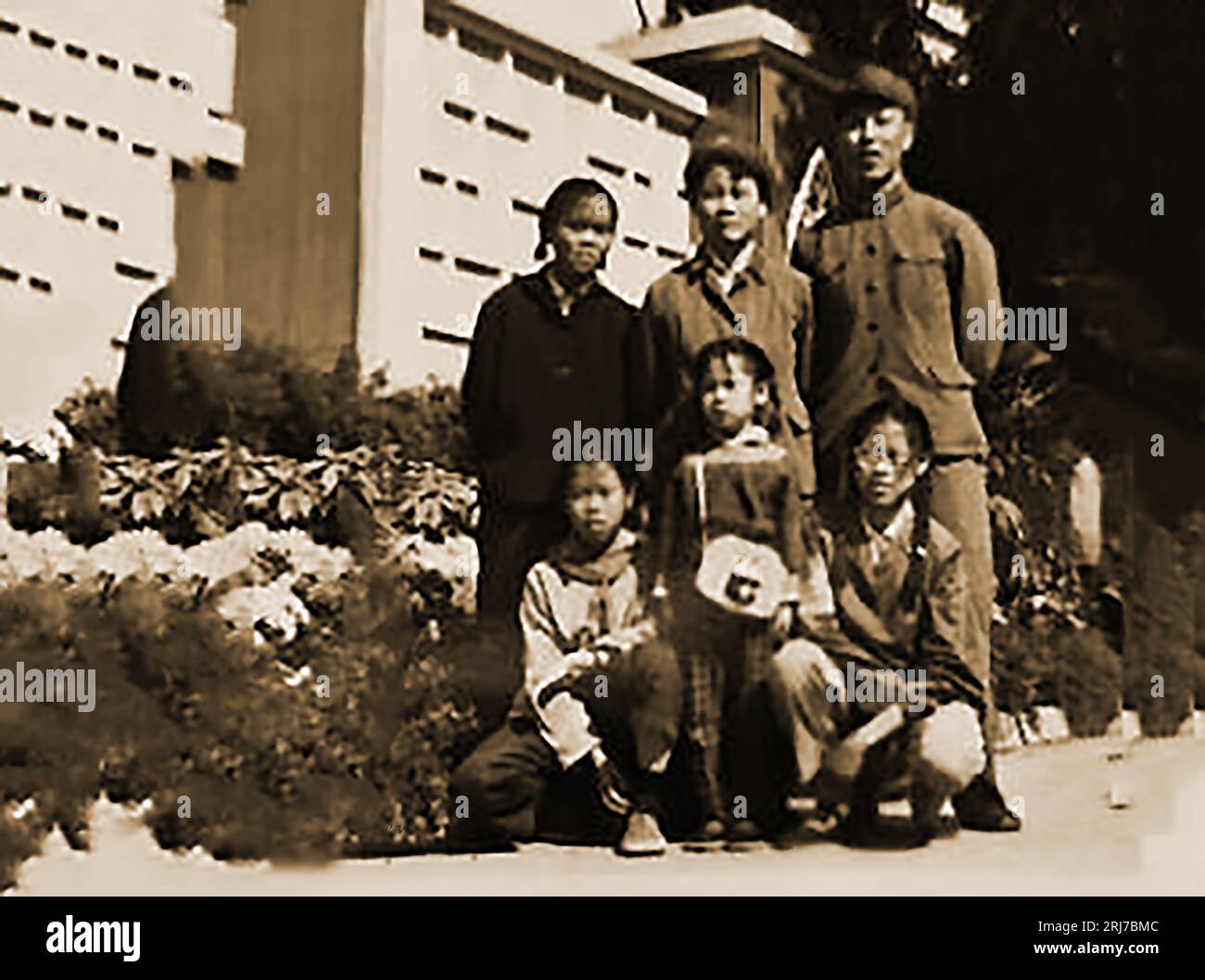 China Cultural Revolution 1967- A snapshot of a red guard and his family. - 1967年中國文化大革命——紅衛兵和他的家人的快照 - 1967年中国文化大革命——红卫兵和他的家人的快照 Stock Photohttps://www.alamy.com/image-license-details/?v=1https://www.alamy.com/china-cultural-revolution-1967-a-snapshot-of-a-red-guard-and-his-family-1967-1967-image561958444.html
China Cultural Revolution 1967- A snapshot of a red guard and his family. - 1967年中國文化大革命——紅衛兵和他的家人的快照 - 1967年中国文化大革命——红卫兵和他的家人的快照 Stock Photohttps://www.alamy.com/image-license-details/?v=1https://www.alamy.com/china-cultural-revolution-1967-a-snapshot-of-a-red-guard-and-his-family-1967-1967-image561958444.htmlRM2RJ7BMC–China Cultural Revolution 1967- A snapshot of a red guard and his family. - 1967年中國文化大革命——紅衛兵和他的家人的快照 - 1967年中国文化大革命——红卫兵和他的家人的快照
 Vintage historic political propaganda poster for Chairman Mao 'LONG LIVE THE GREAT PROLETARIAN CULTURAL REVOLUTION IN CHINA' Stock Photohttps://www.alamy.com/image-license-details/?v=1https://www.alamy.com/stock-image-vintage-historic-political-propaganda-poster-for-chairman-mao-long-166430985.html
Vintage historic political propaganda poster for Chairman Mao 'LONG LIVE THE GREAT PROLETARIAN CULTURAL REVOLUTION IN CHINA' Stock Photohttps://www.alamy.com/image-license-details/?v=1https://www.alamy.com/stock-image-vintage-historic-political-propaganda-poster-for-chairman-mao-long-166430985.htmlRMKJNGBN–Vintage historic political propaganda poster for Chairman Mao 'LONG LIVE THE GREAT PROLETARIAN CULTURAL REVOLUTION IN CHINA'
 A less than enthusiastic government-organized demonstration in Tiananmen Square, Beijing, China, spring of 1967. Stock Photohttps://www.alamy.com/image-license-details/?v=1https://www.alamy.com/a-less-than-enthusiastic-government-organized-demonstration-in-tiananmen-square-beijing-china-spring-of-1967-image458812610.html
A less than enthusiastic government-organized demonstration in Tiananmen Square, Beijing, China, spring of 1967. Stock Photohttps://www.alamy.com/image-license-details/?v=1https://www.alamy.com/a-less-than-enthusiastic-government-organized-demonstration-in-tiananmen-square-beijing-china-spring-of-1967-image458812610.htmlRM2HJCM4J–A less than enthusiastic government-organized demonstration in Tiananmen Square, Beijing, China, spring of 1967.
 Vintage historic political propaganda poster for Chairman Mao 'LONG LIVE THE GREAT PROLETARIAN CULTURAL REVOLUTION IN CHINA' Stock Photohttps://www.alamy.com/image-license-details/?v=1https://www.alamy.com/stock-photo-vintage-historic-political-propaganda-poster-for-chairman-mao-long-137476377.html
Vintage historic political propaganda poster for Chairman Mao 'LONG LIVE THE GREAT PROLETARIAN CULTURAL REVOLUTION IN CHINA' Stock Photohttps://www.alamy.com/image-license-details/?v=1https://www.alamy.com/stock-photo-vintage-historic-political-propaganda-poster-for-chairman-mao-long-137476377.htmlRMHYJGEH–Vintage historic political propaganda poster for Chairman Mao 'LONG LIVE THE GREAT PROLETARIAN CULTURAL REVOLUTION IN CHINA'
 Hail The Defeat Of Revisionism in Our China 1967 poster from the period of the Chinese Cultural Revolution Stock Photohttps://www.alamy.com/image-license-details/?v=1https://www.alamy.com/stock-photo-hail-the-defeat-of-revisionism-in-our-china-1967-poster-from-the-period-12239299.html
Hail The Defeat Of Revisionism in Our China 1967 poster from the period of the Chinese Cultural Revolution Stock Photohttps://www.alamy.com/image-license-details/?v=1https://www.alamy.com/stock-photo-hail-the-defeat-of-revisionism-in-our-china-1967-poster-from-the-period-12239299.htmlRMA93H4M–Hail The Defeat Of Revisionism in Our China 1967 poster from the period of the Chinese Cultural Revolution
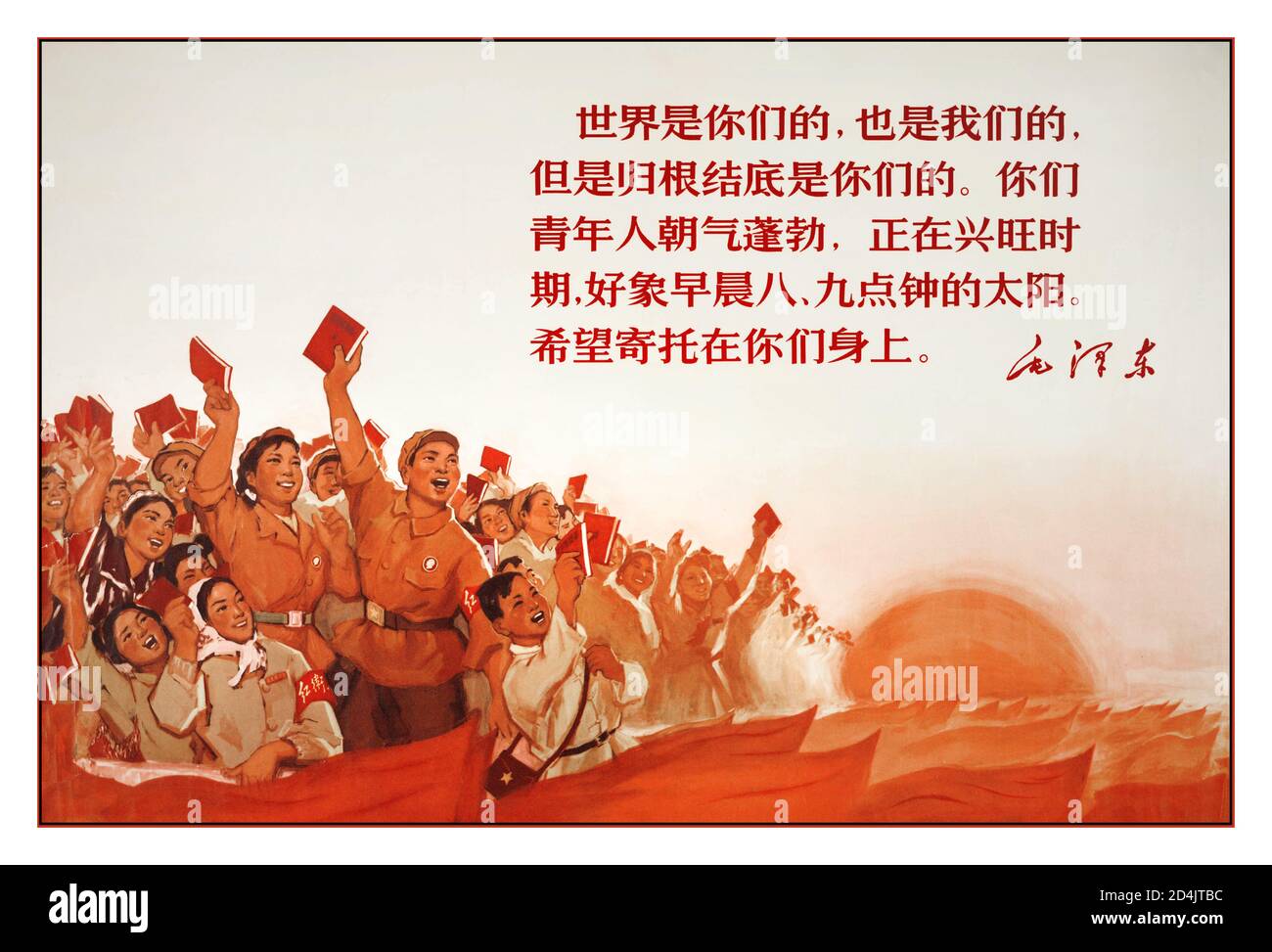 Vintage 1960's Chinese Revolution Poster Chairman Mao Zedong: 'The world is yours, as well as ours, but in the last analysis, it is yours, you young people, full of vigor and vitality ' 1967. Mao’s Fighters are the Closest Followers of the Party. Beijing Film Academy Jinggangshan Commune Stock Photohttps://www.alamy.com/image-license-details/?v=1https://www.alamy.com/vintage-1960s-chinese-revolution-poster-chairman-mao-zedong-the-world-is-yours-as-well-as-ours-but-in-the-last-analysis-it-is-yours-you-young-people-full-of-vigor-and-vitality-1967-maos-fighters-are-the-closest-followers-of-the-party-beijing-film-academy-jinggangshan-commune-image381500992.html
Vintage 1960's Chinese Revolution Poster Chairman Mao Zedong: 'The world is yours, as well as ours, but in the last analysis, it is yours, you young people, full of vigor and vitality ' 1967. Mao’s Fighters are the Closest Followers of the Party. Beijing Film Academy Jinggangshan Commune Stock Photohttps://www.alamy.com/image-license-details/?v=1https://www.alamy.com/vintage-1960s-chinese-revolution-poster-chairman-mao-zedong-the-world-is-yours-as-well-as-ours-but-in-the-last-analysis-it-is-yours-you-young-people-full-of-vigor-and-vitality-1967-maos-fighters-are-the-closest-followers-of-the-party-beijing-film-academy-jinggangshan-commune-image381500992.htmlRM2D4JTBC–Vintage 1960's Chinese Revolution Poster Chairman Mao Zedong: 'The world is yours, as well as ours, but in the last analysis, it is yours, you young people, full of vigor and vitality ' 1967. Mao’s Fighters are the Closest Followers of the Party. Beijing Film Academy Jinggangshan Commune
 Chinese navy cadet studies the quotations of Chairman Mao, during the Cultural Revolution. China 1967 Stock Photohttps://www.alamy.com/image-license-details/?v=1https://www.alamy.com/chinese-navy-cadet-studies-the-quotations-of-chairman-mao-during-the-cultural-revolution-china-1967-image328359561.html
Chinese navy cadet studies the quotations of Chairman Mao, during the Cultural Revolution. China 1967 Stock Photohttps://www.alamy.com/image-license-details/?v=1https://www.alamy.com/chinese-navy-cadet-studies-the-quotations-of-chairman-mao-during-the-cultural-revolution-china-1967-image328359561.htmlRM2A261Y5–Chinese navy cadet studies the quotations of Chairman Mao, during the Cultural Revolution. China 1967
 Members of Mao Tse-tung's Red Guard pause at the Great Wall on their way to Peking from rural areas, 1967. Courtesy: CSU Stock Photohttps://www.alamy.com/image-license-details/?v=1https://www.alamy.com/stock-photo-members-of-mao-tse-tungs-red-guard-pause-at-the-great-wall-on-their-50011301.html
Members of Mao Tse-tung's Red Guard pause at the Great Wall on their way to Peking from rural areas, 1967. Courtesy: CSU Stock Photohttps://www.alamy.com/image-license-details/?v=1https://www.alamy.com/stock-photo-members-of-mao-tse-tungs-red-guard-pause-at-the-great-wall-on-their-50011301.htmlRMCWA5WW–Members of Mao Tse-tung's Red Guard pause at the Great Wall on their way to Peking from rural areas, 1967. Courtesy: CSU
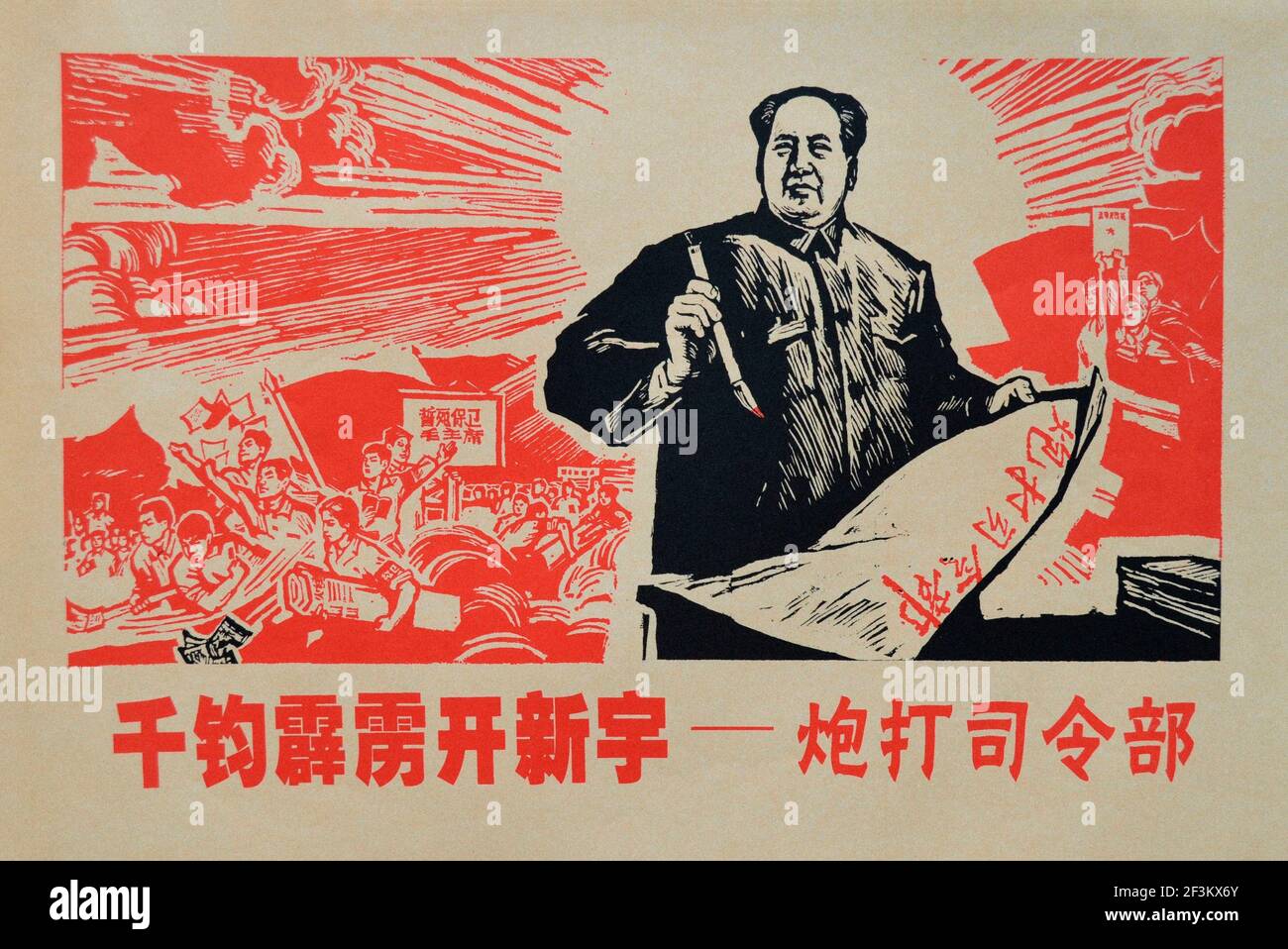 Chinese communist propaganda poster. Chairman Mao Zedongt. China, 1967 Stock Photohttps://www.alamy.com/image-license-details/?v=1https://www.alamy.com/chinese-communist-propaganda-poster-chairman-mao-zedongt-china-1967-image415330467.html
Chinese communist propaganda poster. Chairman Mao Zedongt. China, 1967 Stock Photohttps://www.alamy.com/image-license-details/?v=1https://www.alamy.com/chinese-communist-propaganda-poster-chairman-mao-zedongt-china-1967-image415330467.htmlRM2F3KX6Y–Chinese communist propaganda poster. Chairman Mao Zedongt. China, 1967
 Photograph taken of posters of Mao and quotations along the Nanking Road during the Cultural Revolution in 1967, Shanghai, China Stock Photohttps://www.alamy.com/image-license-details/?v=1https://www.alamy.com/stock-photo-photograph-taken-of-posters-of-mao-and-quotations-along-the-nanking-20477242.html
Photograph taken of posters of Mao and quotations along the Nanking Road during the Cultural Revolution in 1967, Shanghai, China Stock Photohttps://www.alamy.com/image-license-details/?v=1https://www.alamy.com/stock-photo-photograph-taken-of-posters-of-mao-and-quotations-along-the-nanking-20477242.htmlRMB58PX2–Photograph taken of posters of Mao and quotations along the Nanking Road during the Cultural Revolution in 1967, Shanghai, China
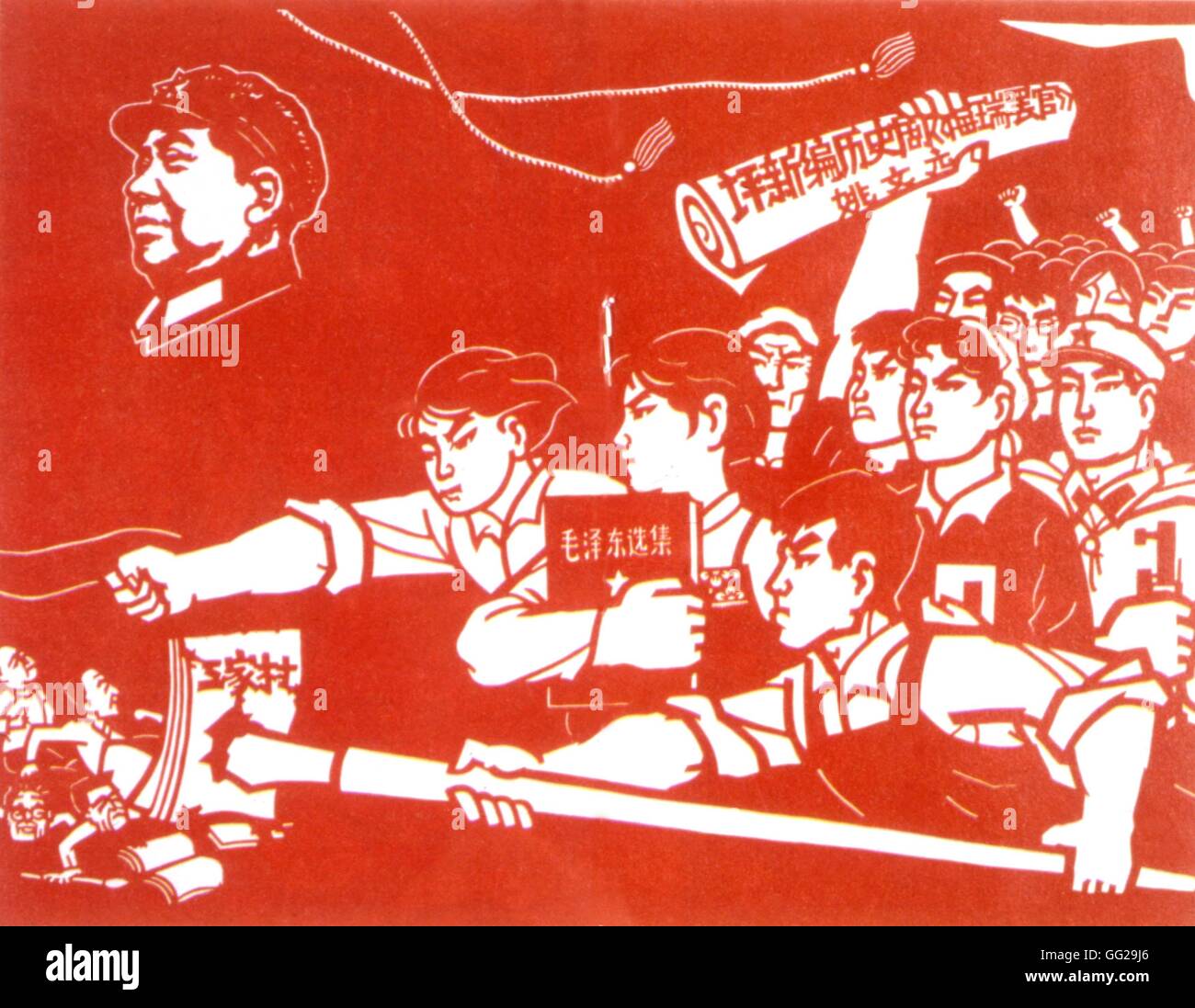 Propaganda poster, during the Cultural Revolution. The Red Guards protest by brandishing an anti Maoist book by Hai Jui. c.1967 China Stock Photohttps://www.alamy.com/image-license-details/?v=1https://www.alamy.com/stock-photo-propaganda-poster-during-the-cultural-revolution-the-red-guards-protest-113148174.html
Propaganda poster, during the Cultural Revolution. The Red Guards protest by brandishing an anti Maoist book by Hai Jui. c.1967 China Stock Photohttps://www.alamy.com/image-license-details/?v=1https://www.alamy.com/stock-photo-propaganda-poster-during-the-cultural-revolution-the-red-guards-protest-113148174.htmlRMGG29J6–Propaganda poster, during the Cultural Revolution. The Red Guards protest by brandishing an anti Maoist book by Hai Jui. c.1967 China
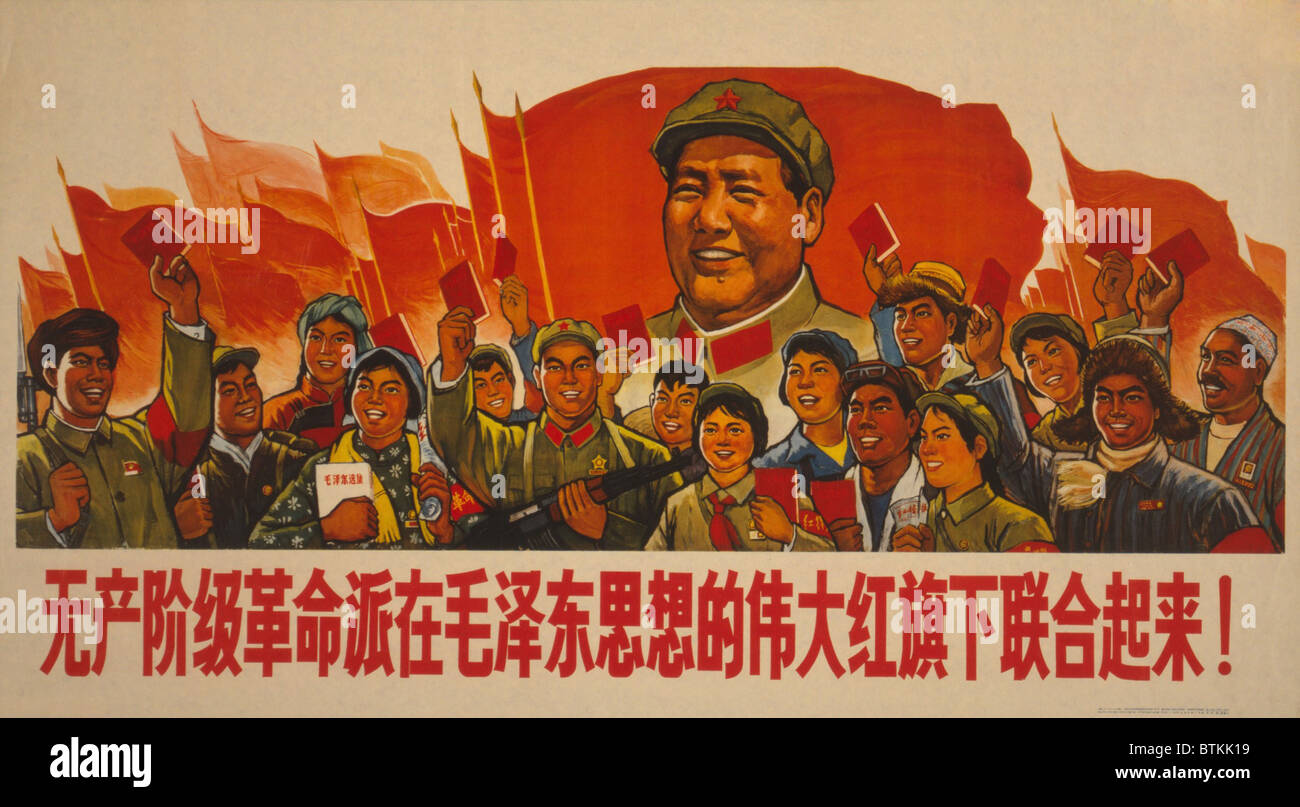 'Proletarian revolutionaries unite under the great red banner of the thoughts of Mao Tse-tung' is the title of this 1967 Cultural Revolution propaganda poster depicting people of different professions and ethnic groups waving books of quotations from the works of Mao Tse-tung. Stock Photohttps://www.alamy.com/image-license-details/?v=1https://www.alamy.com/stock-photo-proletarian-revolutionaries-unite-under-the-great-red-banner-of-the-32394133.html
'Proletarian revolutionaries unite under the great red banner of the thoughts of Mao Tse-tung' is the title of this 1967 Cultural Revolution propaganda poster depicting people of different professions and ethnic groups waving books of quotations from the works of Mao Tse-tung. Stock Photohttps://www.alamy.com/image-license-details/?v=1https://www.alamy.com/stock-photo-proletarian-revolutionaries-unite-under-the-great-red-banner-of-the-32394133.htmlRMBTKK19–'Proletarian revolutionaries unite under the great red banner of the thoughts of Mao Tse-tung' is the title of this 1967 Cultural Revolution propaganda poster depicting people of different professions and ethnic groups waving books of quotations from the works of Mao Tse-tung.
 Peking, China: in the final of 'The Whitehead girl,' a ballet on ' class struggle,' the heroine His-Erh dances with her betrothed, Ta Chun, soldier of the eighth route army. Peking extols this drama as a triumph for Mao Tse-Tung’s thoughts in China’s' great proletarian Cultural revolution.'. 24th January, 1967 Stock Photohttps://www.alamy.com/image-license-details/?v=1https://www.alamy.com/peking-china-in-the-final-of-the-whitehead-girl-a-ballet-on-class-struggle-the-heroine-his-erh-dances-with-her-betrothed-ta-chun-soldier-of-the-eighth-route-army-peking-extols-this-drama-as-a-triumph-for-mao-tse-tungs-thoughts-in-chinas-great-proletarian-cultural-revolution-24th-january-1967-image623718893.html
Peking, China: in the final of 'The Whitehead girl,' a ballet on ' class struggle,' the heroine His-Erh dances with her betrothed, Ta Chun, soldier of the eighth route army. Peking extols this drama as a triumph for Mao Tse-Tung’s thoughts in China’s' great proletarian Cultural revolution.'. 24th January, 1967 Stock Photohttps://www.alamy.com/image-license-details/?v=1https://www.alamy.com/peking-china-in-the-final-of-the-whitehead-girl-a-ballet-on-class-struggle-the-heroine-his-erh-dances-with-her-betrothed-ta-chun-soldier-of-the-eighth-route-army-peking-extols-this-drama-as-a-triumph-for-mao-tse-tungs-thoughts-in-chinas-great-proletarian-cultural-revolution-24th-january-1967-image623718893.htmlRM2Y6MRPN–Peking, China: in the final of 'The Whitehead girl,' a ballet on ' class struggle,' the heroine His-Erh dances with her betrothed, Ta Chun, soldier of the eighth route army. Peking extols this drama as a triumph for Mao Tse-Tung’s thoughts in China’s' great proletarian Cultural revolution.'. 24th January, 1967
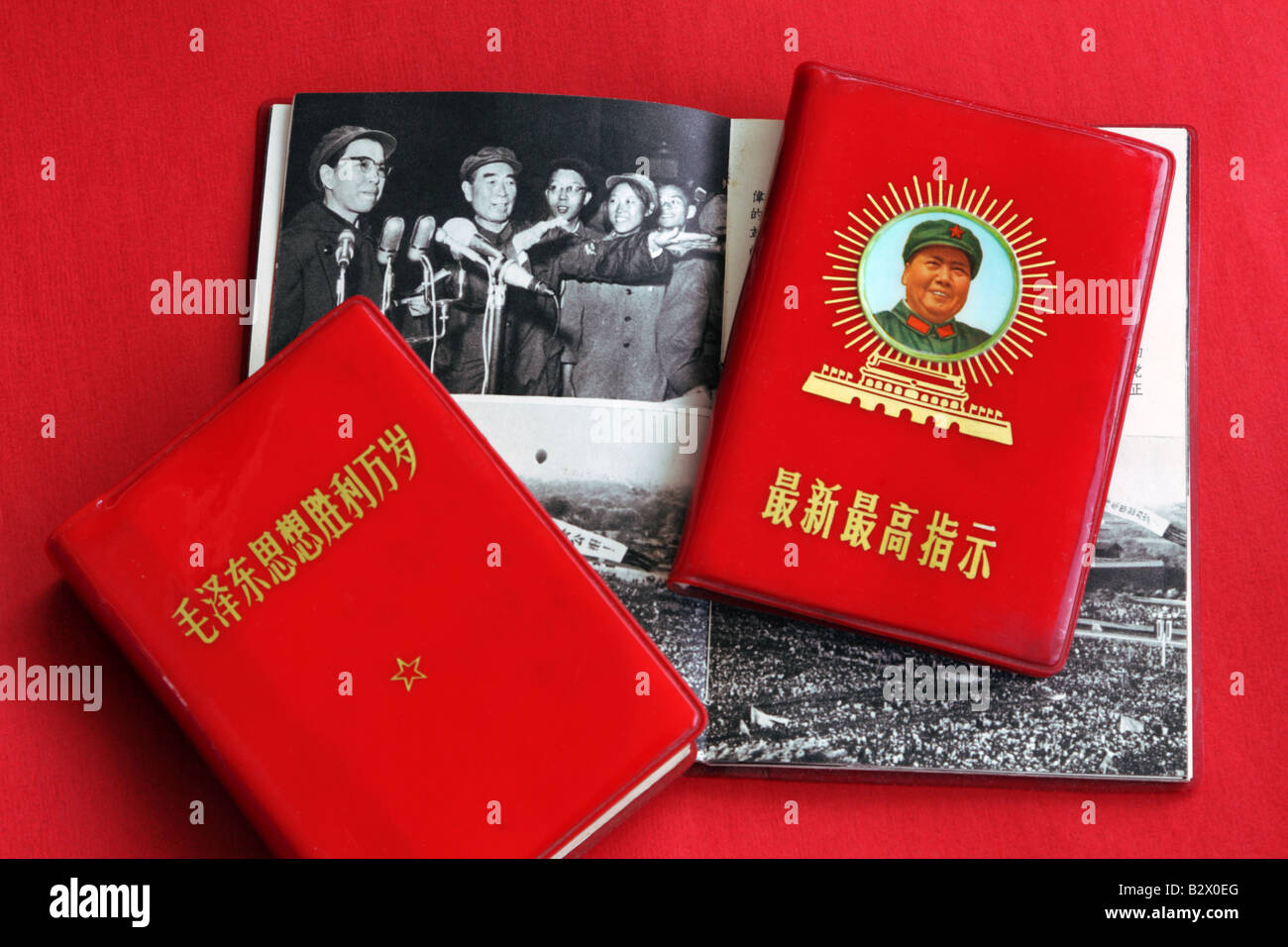 Mao books with wife Jiang Qing and then political ally Lin Bao during Cultural Revolution Stock Photohttps://www.alamy.com/image-license-details/?v=1https://www.alamy.com/stock-photo-mao-books-with-wife-jiang-qing-and-then-political-ally-lin-bao-during-19010840.html
Mao books with wife Jiang Qing and then political ally Lin Bao during Cultural Revolution Stock Photohttps://www.alamy.com/image-license-details/?v=1https://www.alamy.com/stock-photo-mao-books-with-wife-jiang-qing-and-then-political-ally-lin-bao-during-19010840.htmlRMB2X0EG–Mao books with wife Jiang Qing and then political ally Lin Bao during Cultural Revolution
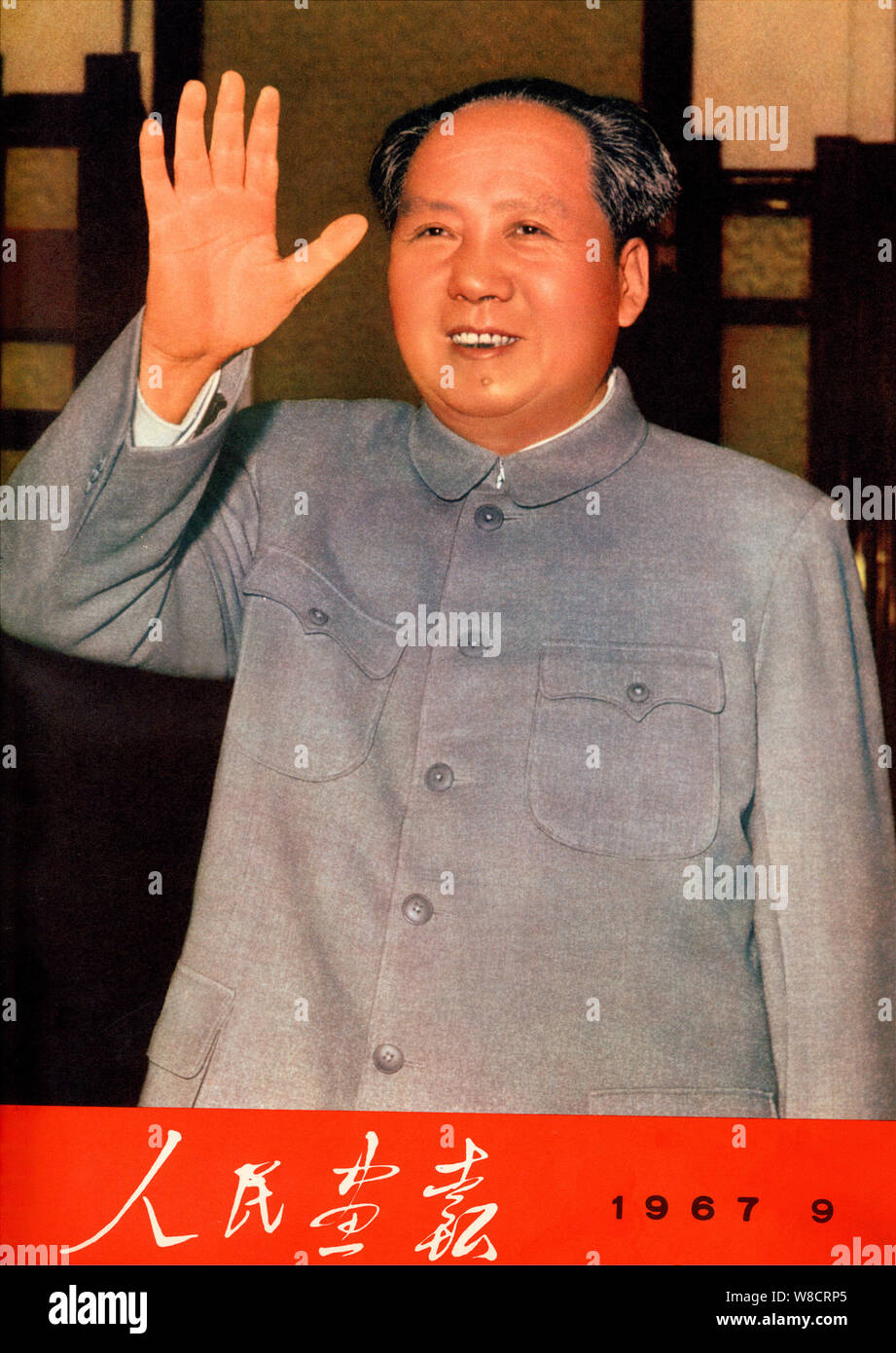 This cover of the China Pictorial 9th issue in 1967 features Chinese leader Chairman Mao Zedong. Stock Photohttps://www.alamy.com/image-license-details/?v=1https://www.alamy.com/this-cover-of-the-china-pictorial-9th-issue-in-1967-features-chinese-leader-chairman-mao-zedong-image263354845.html
This cover of the China Pictorial 9th issue in 1967 features Chinese leader Chairman Mao Zedong. Stock Photohttps://www.alamy.com/image-license-details/?v=1https://www.alamy.com/this-cover-of-the-china-pictorial-9th-issue-in-1967-features-chinese-leader-chairman-mao-zedong-image263354845.htmlRMW8CRP5–This cover of the China Pictorial 9th issue in 1967 features Chinese leader Chairman Mao Zedong.
 Bildnummer: 53367425 Datum: 16.09.2009 Copyright: imago/Xinhua Yuan Shu (R) speaks as Mao Feiyi standing on the side during the awarding ceremony of the Braun Prize 2009 International Design Contest in Frankfurt, Germany, Sept. 16, 2009. A mine accident life-saving equipment, designed by Yuan Shu and Mao Feiyi, students of China s Huazhong University of Science and Technology, won the award of the Chinese division of the Braun Prize 2009. The biennial internatioanlly recognized design competition, founded in 1967, is open to young industrial designers. (Xinhua/Luo Huanhuan) (gxr) (2)GERMANY Stock Photohttps://www.alamy.com/image-license-details/?v=1https://www.alamy.com/bildnummer-53367425-datum-16092009-copyright-imagoxinhua-yuan-shu-r-speaks-as-mao-feiyi-standing-on-the-side-during-the-awarding-ceremony-of-the-braun-prize-2009-international-design-contest-in-frankfurt-germany-sept-16-2009-a-mine-accident-life-saving-equipment-designed-by-yuan-shu-and-mao-feiyi-students-of-china-s-huazhong-university-of-science-and-technology-won-the-award-of-the-chinese-division-of-the-braun-prize-2009-the-biennial-internatioanlly-recognized-design-competition-founded-in-1967-is-open-to-young-industrial-designers-xinhualuo-huanhuan-gxr-2germany-image562483344.html
Bildnummer: 53367425 Datum: 16.09.2009 Copyright: imago/Xinhua Yuan Shu (R) speaks as Mao Feiyi standing on the side during the awarding ceremony of the Braun Prize 2009 International Design Contest in Frankfurt, Germany, Sept. 16, 2009. A mine accident life-saving equipment, designed by Yuan Shu and Mao Feiyi, students of China s Huazhong University of Science and Technology, won the award of the Chinese division of the Braun Prize 2009. The biennial internatioanlly recognized design competition, founded in 1967, is open to young industrial designers. (Xinhua/Luo Huanhuan) (gxr) (2)GERMANY Stock Photohttps://www.alamy.com/image-license-details/?v=1https://www.alamy.com/bildnummer-53367425-datum-16092009-copyright-imagoxinhua-yuan-shu-r-speaks-as-mao-feiyi-standing-on-the-side-during-the-awarding-ceremony-of-the-braun-prize-2009-international-design-contest-in-frankfurt-germany-sept-16-2009-a-mine-accident-life-saving-equipment-designed-by-yuan-shu-and-mao-feiyi-students-of-china-s-huazhong-university-of-science-and-technology-won-the-award-of-the-chinese-division-of-the-braun-prize-2009-the-biennial-internatioanlly-recognized-design-competition-founded-in-1967-is-open-to-young-industrial-designers-xinhualuo-huanhuan-gxr-2germany-image562483344.htmlRM2RK396T–Bildnummer: 53367425 Datum: 16.09.2009 Copyright: imago/Xinhua Yuan Shu (R) speaks as Mao Feiyi standing on the side during the awarding ceremony of the Braun Prize 2009 International Design Contest in Frankfurt, Germany, Sept. 16, 2009. A mine accident life-saving equipment, designed by Yuan Shu and Mao Feiyi, students of China s Huazhong University of Science and Technology, won the award of the Chinese division of the Braun Prize 2009. The biennial internatioanlly recognized design competition, founded in 1967, is open to young industrial designers. (Xinhua/Luo Huanhuan) (gxr) (2)GERMANY
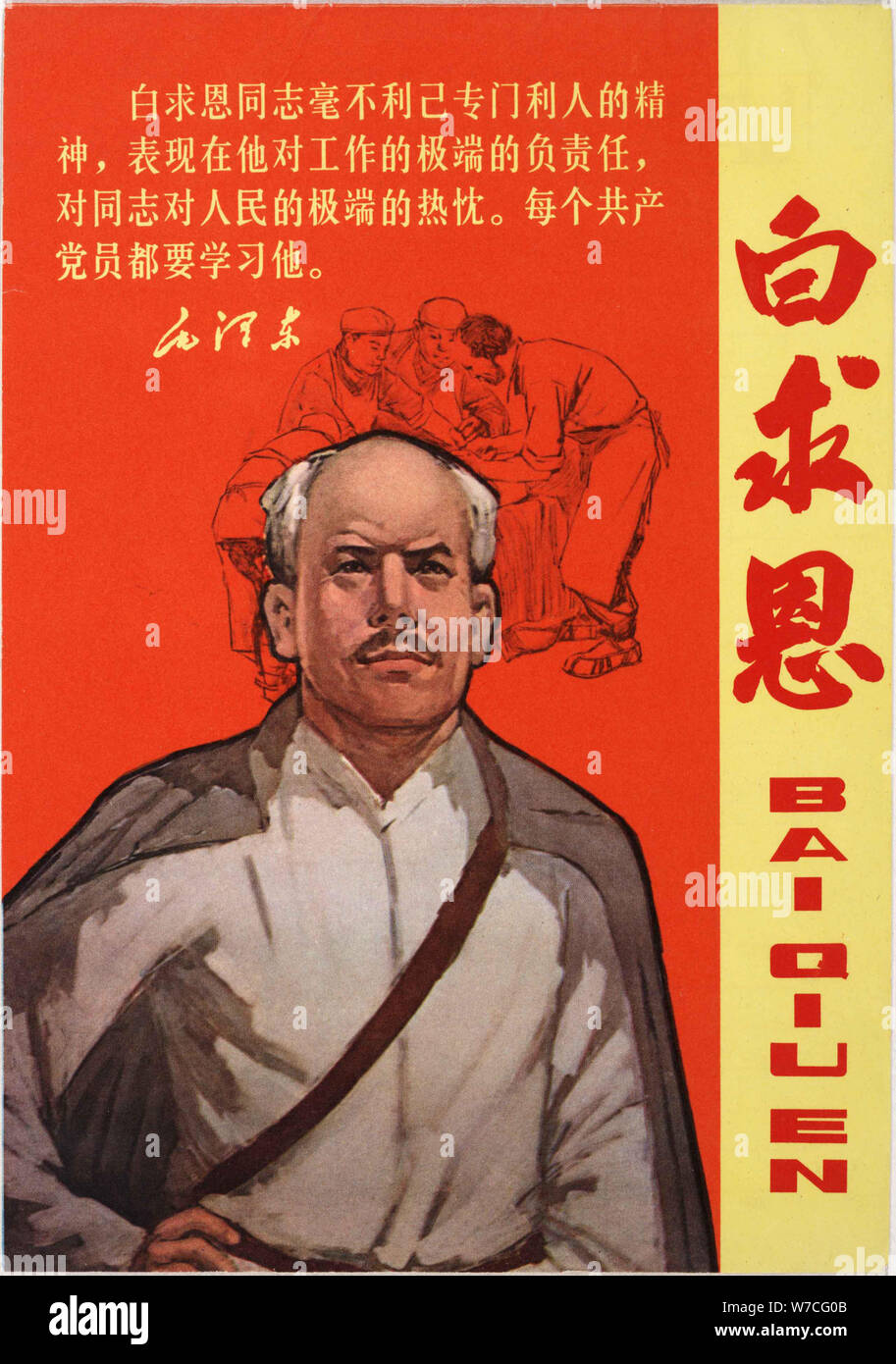 Norman Bethune, 1967. Stock Photohttps://www.alamy.com/image-license-details/?v=1https://www.alamy.com/norman-bethune-1967-image262734091.html
Norman Bethune, 1967. Stock Photohttps://www.alamy.com/image-license-details/?v=1https://www.alamy.com/norman-bethune-1967-image262734091.htmlRMW7CG0B–Norman Bethune, 1967.
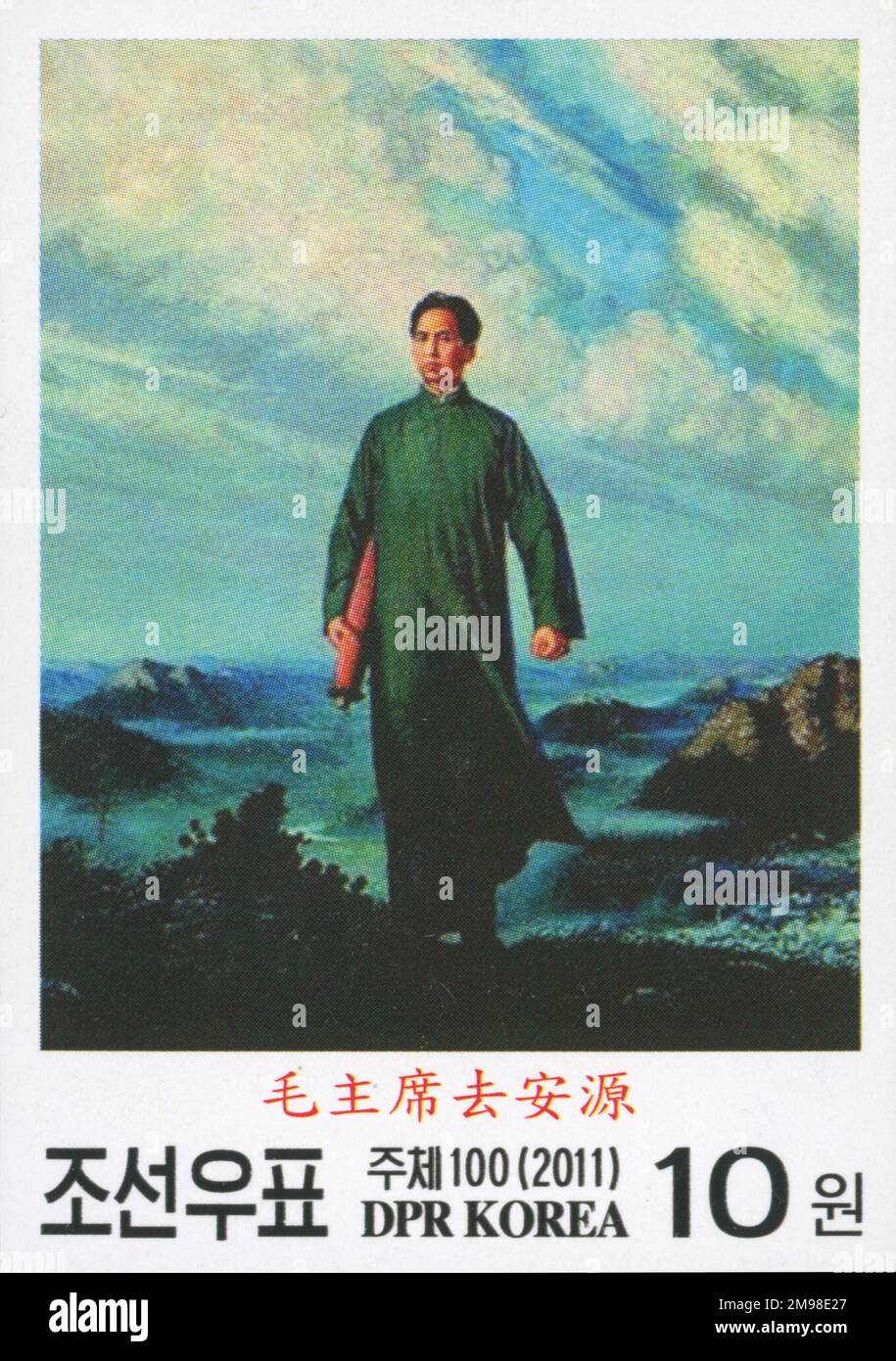 2011 North Korea stamp. Chairman Mao en Route to Anyuan. 1967 oil painting by Liu Chunhua. Stock Photohttps://www.alamy.com/image-license-details/?v=1https://www.alamy.com/2011-north-korea-stamp-chairman-mao-en-route-to-anyuan-1967-oil-painting-by-liu-chunhua-image504819231.html
2011 North Korea stamp. Chairman Mao en Route to Anyuan. 1967 oil painting by Liu Chunhua. Stock Photohttps://www.alamy.com/image-license-details/?v=1https://www.alamy.com/2011-north-korea-stamp-chairman-mao-en-route-to-anyuan-1967-oil-painting-by-liu-chunhua-image504819231.htmlRM2M98E27–2011 North Korea stamp. Chairman Mao en Route to Anyuan. 1967 oil painting by Liu Chunhua.
 Chinese navy cadets study the quotations of Chairman Mao, during the Cultural Revolution. China 1967 Stock Photohttps://www.alamy.com/image-license-details/?v=1https://www.alamy.com/chinese-navy-cadets-study-the-quotations-of-chairman-mao-during-the-cultural-revolution-china-1967-image328359562.html
Chinese navy cadets study the quotations of Chairman Mao, during the Cultural Revolution. China 1967 Stock Photohttps://www.alamy.com/image-license-details/?v=1https://www.alamy.com/chinese-navy-cadets-study-the-quotations-of-chairman-mao-during-the-cultural-revolution-china-1967-image328359562.htmlRM2A261Y6–Chinese navy cadets study the quotations of Chairman Mao, during the Cultural Revolution. China 1967
 'Proletarian revolutionaries unite under the great red banner of the thoughts of Mao Tse-tung' is the title of this 1967 Stock Photohttps://www.alamy.com/image-license-details/?v=1https://www.alamy.com/stock-photo-proletarian-revolutionaries-unite-under-the-great-red-banner-of-the-50049946.html
'Proletarian revolutionaries unite under the great red banner of the thoughts of Mao Tse-tung' is the title of this 1967 Stock Photohttps://www.alamy.com/image-license-details/?v=1https://www.alamy.com/stock-photo-proletarian-revolutionaries-unite-under-the-great-red-banner-of-the-50049946.htmlRMCWBY62–'Proletarian revolutionaries unite under the great red banner of the thoughts of Mao Tse-tung' is the title of this 1967
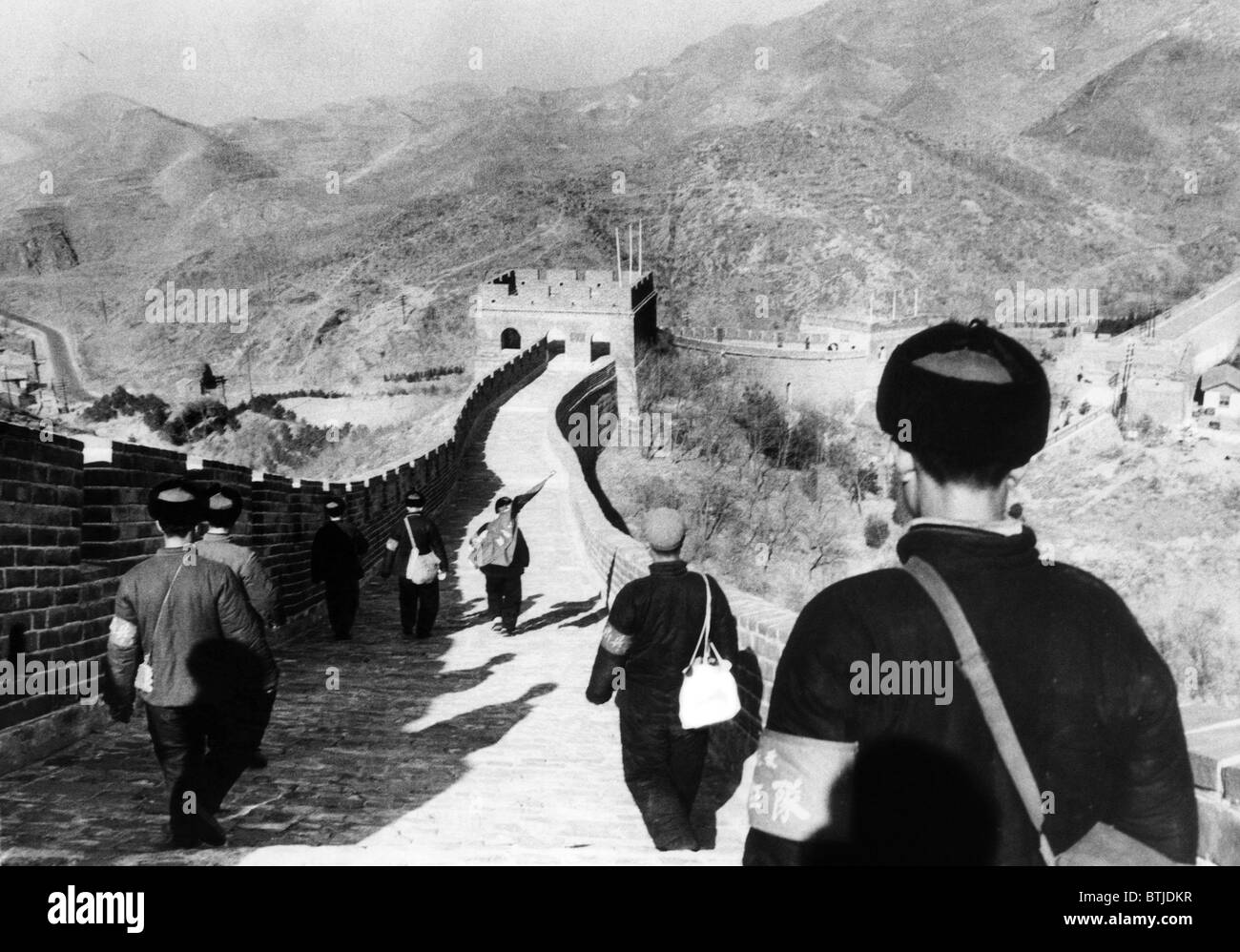 Members of Mao Tse-tung's Red Guard pause at the Great Wall on their way to Peking from rural areas, 1967. Courtesy: CSU Archive Stock Photohttps://www.alamy.com/image-license-details/?v=1https://www.alamy.com/stock-photo-members-of-mao-tse-tungs-red-guard-pause-at-the-great-wall-on-their-32367995.html
Members of Mao Tse-tung's Red Guard pause at the Great Wall on their way to Peking from rural areas, 1967. Courtesy: CSU Archive Stock Photohttps://www.alamy.com/image-license-details/?v=1https://www.alamy.com/stock-photo-members-of-mao-tse-tungs-red-guard-pause-at-the-great-wall-on-their-32367995.htmlRMBTJDKR–Members of Mao Tse-tung's Red Guard pause at the Great Wall on their way to Peking from rural areas, 1967. Courtesy: CSU Archive
 Red Guards put up signs and posters supporting Communist Chinese Chairman Mao Tse Tung (Zedong0 in Canton . A portrait of Mao is seen in centre and everywhere in Canton one can see postes put up by Red Guards in support of the Communist Leader. January 1967 Stock Photohttps://www.alamy.com/image-license-details/?v=1https://www.alamy.com/red-guards-put-up-signs-and-posters-supporting-communist-chinese-chairman-mao-tse-tung-zedong0-in-canton-a-portrait-of-mao-is-seen-in-centre-and-everywhere-in-canton-one-can-see-postes-put-up-by-red-guards-in-support-of-the-communist-leader-january-1967-image623719624.html
Red Guards put up signs and posters supporting Communist Chinese Chairman Mao Tse Tung (Zedong0 in Canton . A portrait of Mao is seen in centre and everywhere in Canton one can see postes put up by Red Guards in support of the Communist Leader. January 1967 Stock Photohttps://www.alamy.com/image-license-details/?v=1https://www.alamy.com/red-guards-put-up-signs-and-posters-supporting-communist-chinese-chairman-mao-tse-tung-zedong0-in-canton-a-portrait-of-mao-is-seen-in-centre-and-everywhere-in-canton-one-can-see-postes-put-up-by-red-guards-in-support-of-the-communist-leader-january-1967-image623719624.htmlRM2Y6MTMT–Red Guards put up signs and posters supporting Communist Chinese Chairman Mao Tse Tung (Zedong0 in Canton . A portrait of Mao is seen in centre and everywhere in Canton one can see postes put up by Red Guards in support of the Communist Leader. January 1967
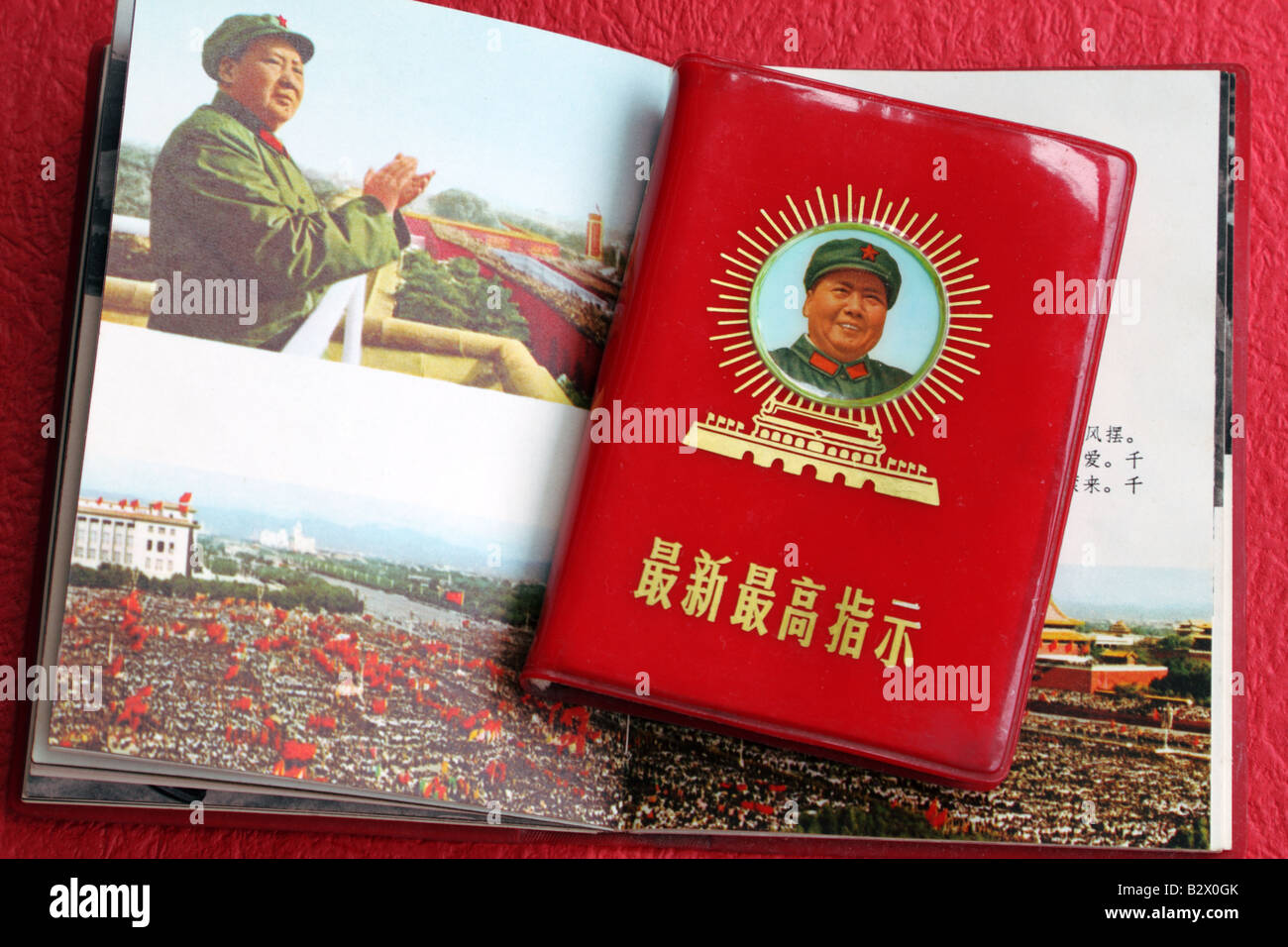 Chairman Mao applauding with seas of Red Guards on balcony of Tiananmen in China's Cultural Revolution and his famous red book Stock Photohttps://www.alamy.com/image-license-details/?v=1https://www.alamy.com/stock-photo-chairman-mao-applauding-with-seas-of-red-guards-on-balcony-of-tiananmen-19010899.html
Chairman Mao applauding with seas of Red Guards on balcony of Tiananmen in China's Cultural Revolution and his famous red book Stock Photohttps://www.alamy.com/image-license-details/?v=1https://www.alamy.com/stock-photo-chairman-mao-applauding-with-seas-of-red-guards-on-balcony-of-tiananmen-19010899.htmlRMB2X0GK–Chairman Mao applauding with seas of Red Guards on balcony of Tiananmen in China's Cultural Revolution and his famous red book
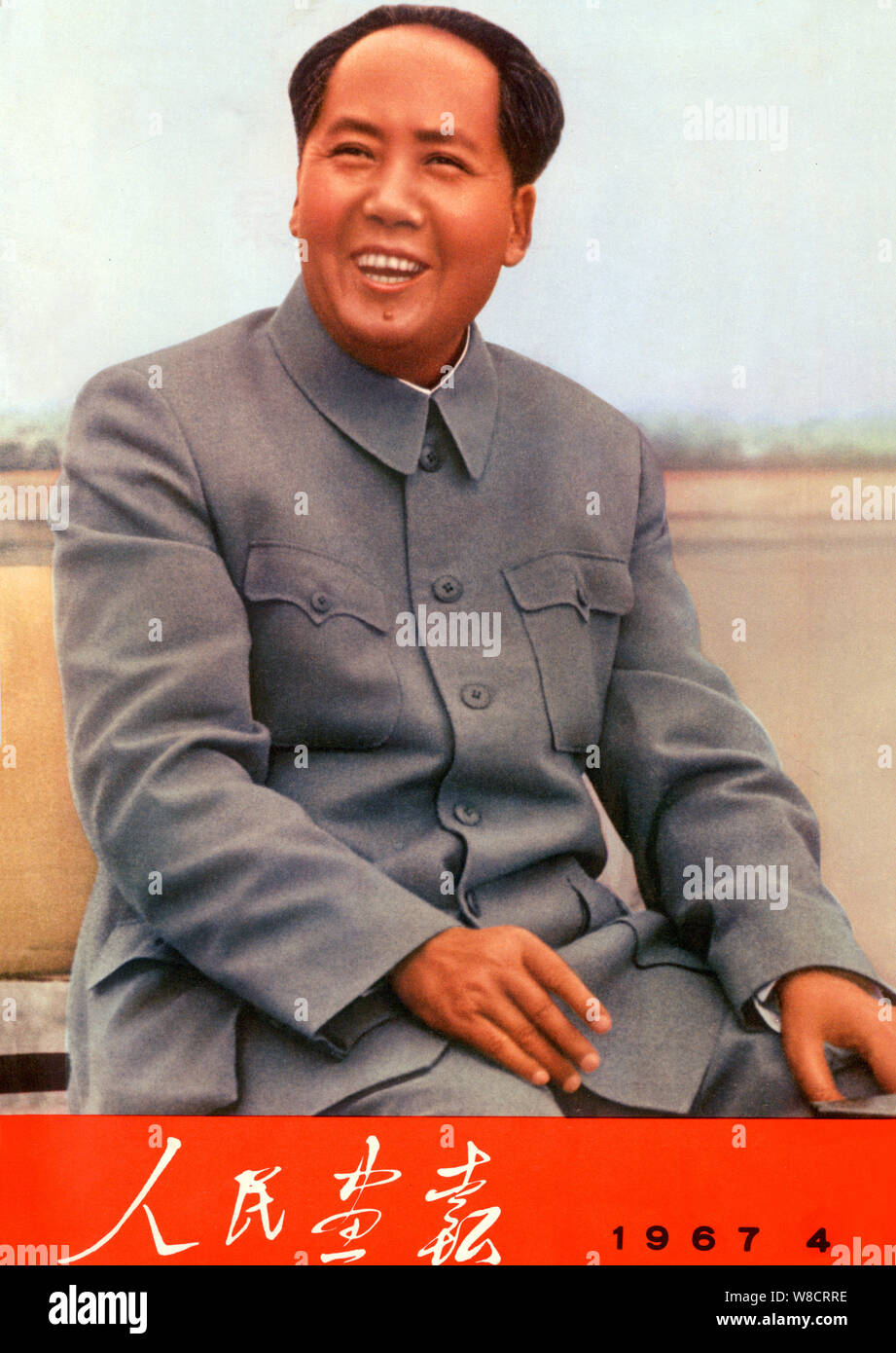 This cover of the China Pictorial 4th issue in 1967 features Chinese leader Chairman Mao Zedong. Stock Photohttps://www.alamy.com/image-license-details/?v=1https://www.alamy.com/this-cover-of-the-china-pictorial-4th-issue-in-1967-features-chinese-leader-chairman-mao-zedong-image263354882.html
This cover of the China Pictorial 4th issue in 1967 features Chinese leader Chairman Mao Zedong. Stock Photohttps://www.alamy.com/image-license-details/?v=1https://www.alamy.com/this-cover-of-the-china-pictorial-4th-issue-in-1967-features-chinese-leader-chairman-mao-zedong-image263354882.htmlRMW8CRRE–This cover of the China Pictorial 4th issue in 1967 features Chinese leader Chairman Mao Zedong.
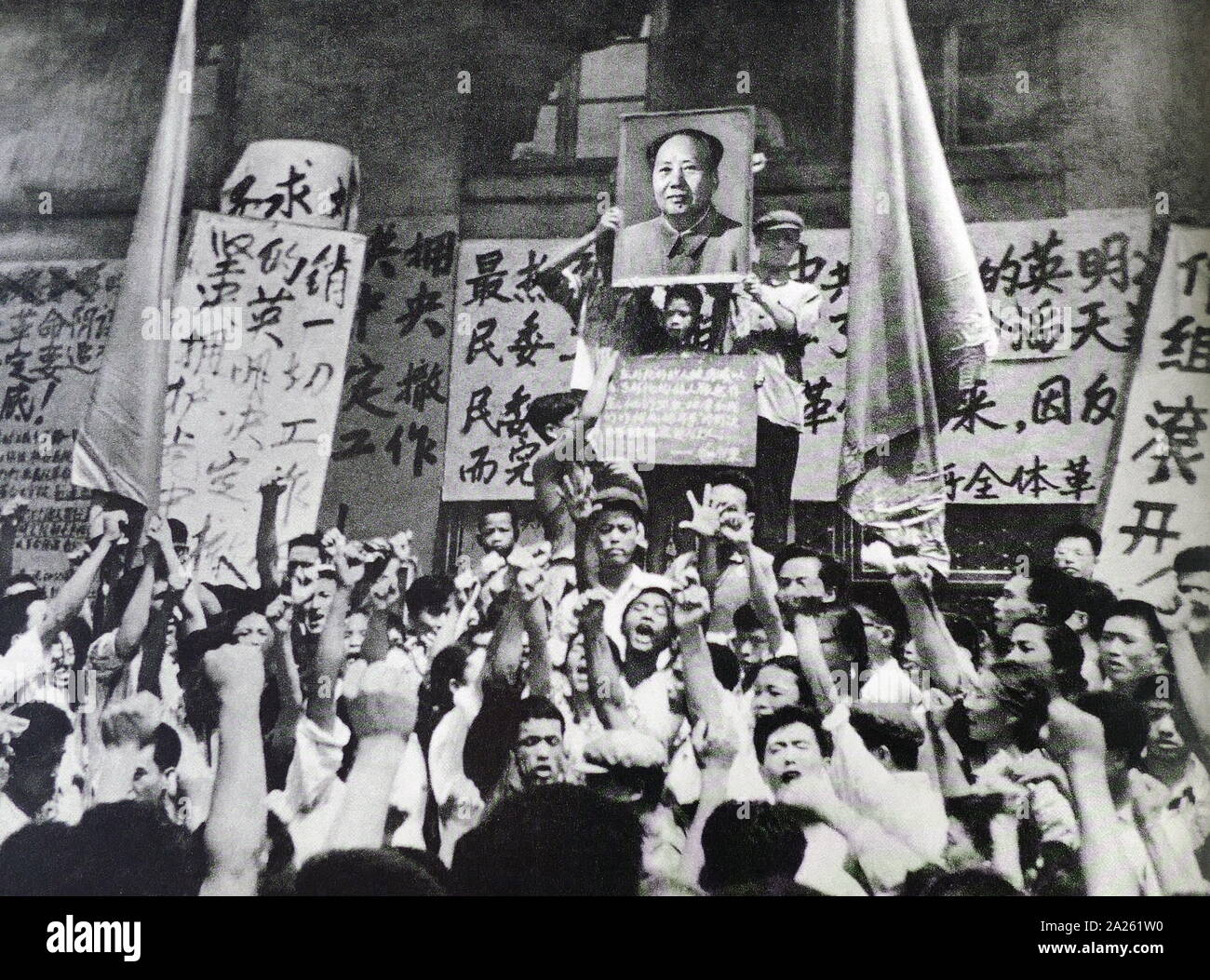 Red Guards China's shout long-live Chairman Mao ! during the Cultural Revolution. China 1967 Stock Photohttps://www.alamy.com/image-license-details/?v=1https://www.alamy.com/red-guards-chinas-shout-long-live-chairman-mao-!-during-the-cultural-revolution-china-1967-image328359500.html
Red Guards China's shout long-live Chairman Mao ! during the Cultural Revolution. China 1967 Stock Photohttps://www.alamy.com/image-license-details/?v=1https://www.alamy.com/red-guards-chinas-shout-long-live-chairman-mao-!-during-the-cultural-revolution-china-1967-image328359500.htmlRM2A261W0–Red Guards China's shout long-live Chairman Mao ! during the Cultural Revolution. China 1967
 This cover of the China Pictorial 6th issue in 1967 features an oil painting of Chinese leader Chairman Mao Zedong. Stock Photohttps://www.alamy.com/image-license-details/?v=1https://www.alamy.com/this-cover-of-the-china-pictorial-6th-issue-in-1967-features-an-oil-painting-of-chinese-leader-chairman-mao-zedong-image263354859.html
This cover of the China Pictorial 6th issue in 1967 features an oil painting of Chinese leader Chairman Mao Zedong. Stock Photohttps://www.alamy.com/image-license-details/?v=1https://www.alamy.com/this-cover-of-the-china-pictorial-6th-issue-in-1967-features-an-oil-painting-of-chinese-leader-chairman-mao-zedong-image263354859.htmlRMW8CRPK–This cover of the China Pictorial 6th issue in 1967 features an oil painting of Chinese leader Chairman Mao Zedong.
 Red Guards China's shout long-live Chairman Mao ! during the Cultural Revolution. China 1967 Stock Photohttps://www.alamy.com/image-license-details/?v=1https://www.alamy.com/red-guards-chinas-shout-long-live-chairman-mao-!-during-the-cultural-revolution-china-1967-image328359584.html
Red Guards China's shout long-live Chairman Mao ! during the Cultural Revolution. China 1967 Stock Photohttps://www.alamy.com/image-license-details/?v=1https://www.alamy.com/red-guards-chinas-shout-long-live-chairman-mao-!-during-the-cultural-revolution-china-1967-image328359584.htmlRM2A26200–Red Guards China's shout long-live Chairman Mao ! during the Cultural Revolution. China 1967
 A 1960s Chinese Red Guard holds up Selected Works of Mao Zedong, with the words 'revolution is no crime, to rebel is justified' written on the back, 1967. Stock Photohttps://www.alamy.com/image-license-details/?v=1https://www.alamy.com/a-1960s-chinese-red-guard-holds-up-selected-works-of-mao-zedong-with-the-words-revolution-is-no-crime-to-rebel-is-justified-written-on-the-back-1967-image634317718.html
A 1960s Chinese Red Guard holds up Selected Works of Mao Zedong, with the words 'revolution is no crime, to rebel is justified' written on the back, 1967. Stock Photohttps://www.alamy.com/image-license-details/?v=1https://www.alamy.com/a-1960s-chinese-red-guard-holds-up-selected-works-of-mao-zedong-with-the-words-revolution-is-no-crime-to-rebel-is-justified-written-on-the-back-1967-image634317718.htmlRM2YRYJM6–A 1960s Chinese Red Guard holds up Selected Works of Mao Zedong, with the words 'revolution is no crime, to rebel is justified' written on the back, 1967.
 This cover of the China Pictorial 5th issue in 1967 features Chinese leader Chairman Mao Zedong aboard a train. Stock Photohttps://www.alamy.com/image-license-details/?v=1https://www.alamy.com/this-cover-of-the-china-pictorial-5th-issue-in-1967-features-chinese-leader-chairman-mao-zedong-aboard-a-train-image263354831.html
This cover of the China Pictorial 5th issue in 1967 features Chinese leader Chairman Mao Zedong aboard a train. Stock Photohttps://www.alamy.com/image-license-details/?v=1https://www.alamy.com/this-cover-of-the-china-pictorial-5th-issue-in-1967-features-chinese-leader-chairman-mao-zedong-aboard-a-train-image263354831.htmlRMW8CRNK–This cover of the China Pictorial 5th issue in 1967 features Chinese leader Chairman Mao Zedong aboard a train.
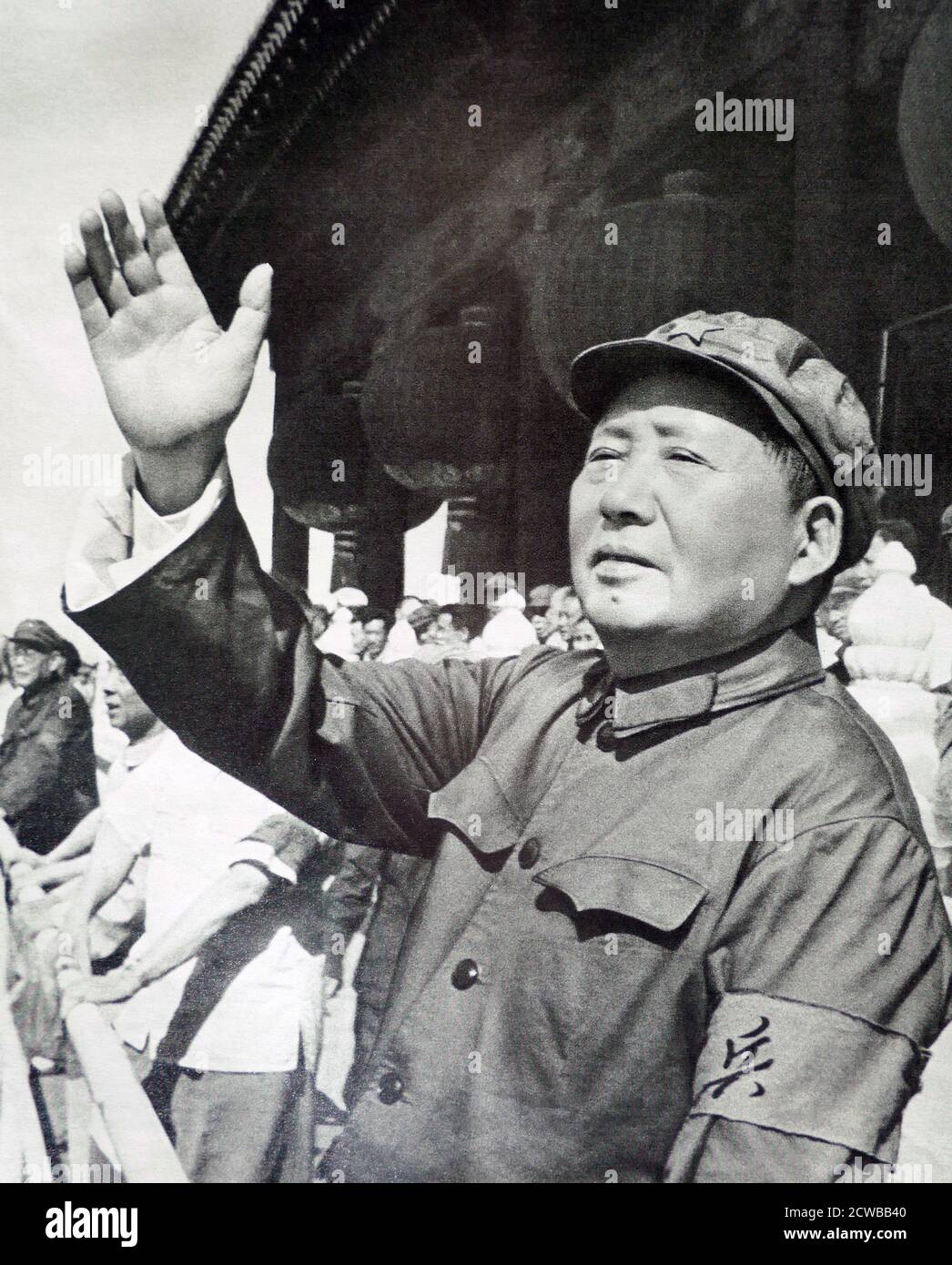 Chairman Mao in Beijing, in 1967. Mao Zedong (1893 - September 9, 1976), was a Chinese communist revolutionary who became the founding father of the People's Republic of China (PRC), which he ruled as the Chairman of the Communist Party of China from its establishment in 1949 until his death Stock Photohttps://www.alamy.com/image-license-details/?v=1https://www.alamy.com/chairman-mao-in-beijing-in-1967-mao-zedong-1893-september-9-1976-was-a-chinese-communist-revolutionary-who-became-the-founding-father-of-the-peoples-republic-of-china-prc-which-he-ruled-as-the-chairman-of-the-communist-party-of-china-from-its-establishment-in-1949-until-his-death-image377034336.html
Chairman Mao in Beijing, in 1967. Mao Zedong (1893 - September 9, 1976), was a Chinese communist revolutionary who became the founding father of the People's Republic of China (PRC), which he ruled as the Chairman of the Communist Party of China from its establishment in 1949 until his death Stock Photohttps://www.alamy.com/image-license-details/?v=1https://www.alamy.com/chairman-mao-in-beijing-in-1967-mao-zedong-1893-september-9-1976-was-a-chinese-communist-revolutionary-who-became-the-founding-father-of-the-peoples-republic-of-china-prc-which-he-ruled-as-the-chairman-of-the-communist-party-of-china-from-its-establishment-in-1949-until-his-death-image377034336.htmlRM2CWBB40–Chairman Mao in Beijing, in 1967. Mao Zedong (1893 - September 9, 1976), was a Chinese communist revolutionary who became the founding father of the People's Republic of China (PRC), which he ruled as the Chairman of the Communist Party of China from its establishment in 1949 until his death
 Mao Zedong (Chinese leader), 1967. Mao Zedong (1893 - September 9, 1976), was a Chinese communist revolutionary who became the founding father of the People's Republic of China (PRC), which he ruled as the Chairman of the Communist Party of China from its establishment in 1949 until his death Stock Photohttps://www.alamy.com/image-license-details/?v=1https://www.alamy.com/mao-zedong-chinese-leader-1967-mao-zedong-1893-september-9-1976-was-a-chinese-communist-revolutionary-who-became-the-founding-father-of-the-peoples-republic-of-china-prc-which-he-ruled-as-the-chairman-of-the-communist-party-of-china-from-its-establishment-in-1949-until-his-death-image186420032.html
Mao Zedong (Chinese leader), 1967. Mao Zedong (1893 - September 9, 1976), was a Chinese communist revolutionary who became the founding father of the People's Republic of China (PRC), which he ruled as the Chairman of the Communist Party of China from its establishment in 1949 until his death Stock Photohttps://www.alamy.com/image-license-details/?v=1https://www.alamy.com/mao-zedong-chinese-leader-1967-mao-zedong-1893-september-9-1976-was-a-chinese-communist-revolutionary-who-became-the-founding-father-of-the-peoples-republic-of-china-prc-which-he-ruled-as-the-chairman-of-the-communist-party-of-china-from-its-establishment-in-1949-until-his-death-image186420032.htmlRMMR84J8–Mao Zedong (Chinese leader), 1967. Mao Zedong (1893 - September 9, 1976), was a Chinese communist revolutionary who became the founding father of the People's Republic of China (PRC), which he ruled as the Chairman of the Communist Party of China from its establishment in 1949 until his death
 Chairman Mao in Beijing, in 1967. Mao Zedong (1893 - September 9, 1976), was a Chinese communist revolutionary who became the founding father of the People's Republic of China (PRC), which he ruled as the Chairman of the Communist Party of China from its establishment in 1949 until his death Stock Photohttps://www.alamy.com/image-license-details/?v=1https://www.alamy.com/chairman-mao-in-beijing-in-1967-mao-zedong-1893-september-9-1976-was-a-chinese-communist-revolutionary-who-became-the-founding-father-of-the-peoples-republic-of-china-prc-which-he-ruled-as-the-chairman-of-the-communist-party-of-china-from-its-establishment-in-1949-until-his-death-image328359674.html
Chairman Mao in Beijing, in 1967. Mao Zedong (1893 - September 9, 1976), was a Chinese communist revolutionary who became the founding father of the People's Republic of China (PRC), which he ruled as the Chairman of the Communist Party of China from its establishment in 1949 until his death Stock Photohttps://www.alamy.com/image-license-details/?v=1https://www.alamy.com/chairman-mao-in-beijing-in-1967-mao-zedong-1893-september-9-1976-was-a-chinese-communist-revolutionary-who-became-the-founding-father-of-the-peoples-republic-of-china-prc-which-he-ruled-as-the-chairman-of-the-communist-party-of-china-from-its-establishment-in-1949-until-his-death-image328359674.htmlRM2A26236–Chairman Mao in Beijing, in 1967. Mao Zedong (1893 - September 9, 1976), was a Chinese communist revolutionary who became the founding father of the People's Republic of China (PRC), which he ruled as the Chairman of the Communist Party of China from its establishment in 1949 until his death
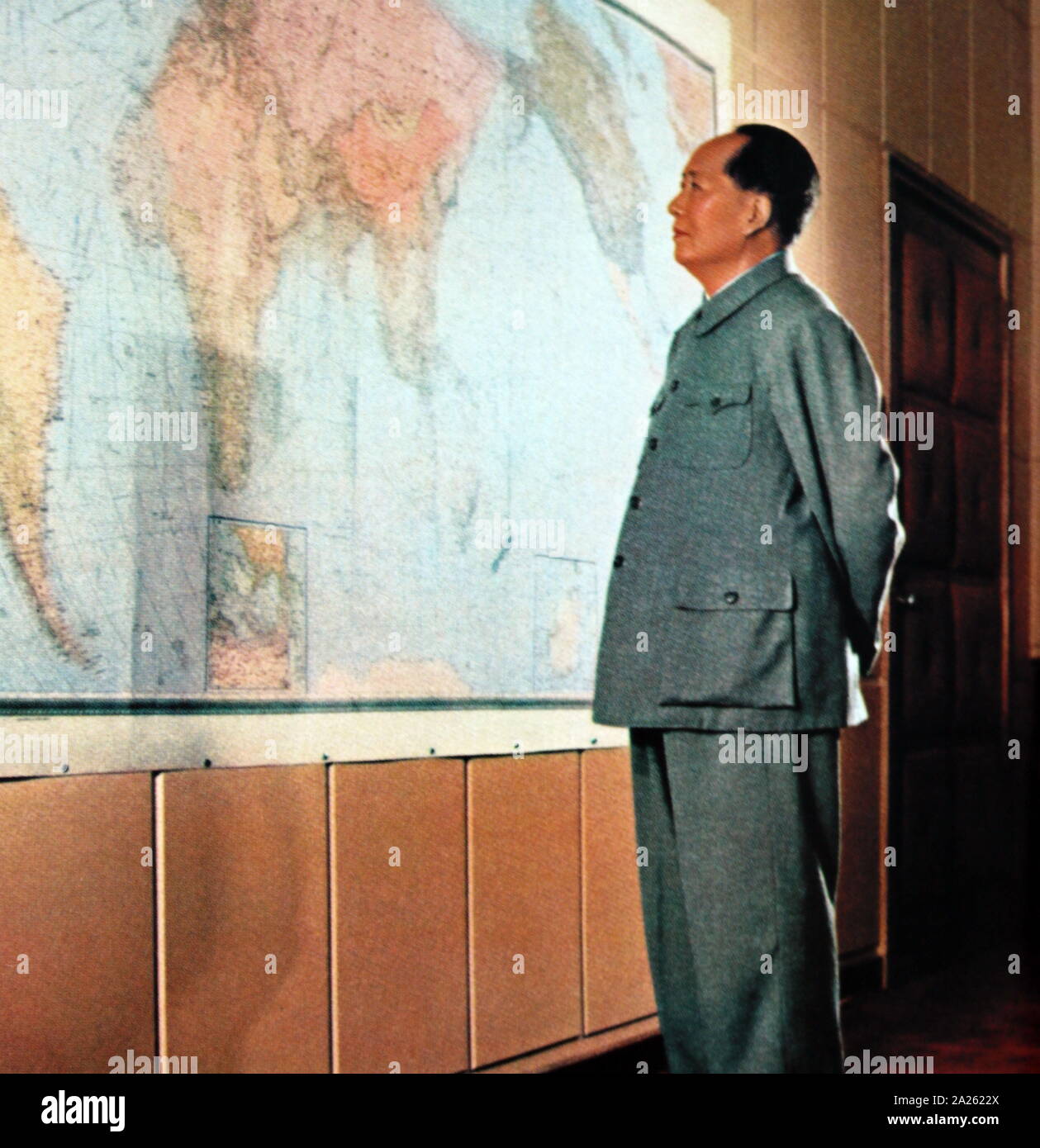 Chairman Mao in Beijing, in 1967. Mao Zedong (1893 - September 9, 1976), was a Chinese communist revolutionary who became the founding father of the People's Republic of China (PRC), which he ruled as the Chairman of the Communist Party of China from its establishment in 1949 until his death Stock Photohttps://www.alamy.com/image-license-details/?v=1https://www.alamy.com/chairman-mao-in-beijing-in-1967-mao-zedong-1893-september-9-1976-was-a-chinese-communist-revolutionary-who-became-the-founding-father-of-the-peoples-republic-of-china-prc-which-he-ruled-as-the-chairman-of-the-communist-party-of-china-from-its-establishment-in-1949-until-his-death-image328359666.html
Chairman Mao in Beijing, in 1967. Mao Zedong (1893 - September 9, 1976), was a Chinese communist revolutionary who became the founding father of the People's Republic of China (PRC), which he ruled as the Chairman of the Communist Party of China from its establishment in 1949 until his death Stock Photohttps://www.alamy.com/image-license-details/?v=1https://www.alamy.com/chairman-mao-in-beijing-in-1967-mao-zedong-1893-september-9-1976-was-a-chinese-communist-revolutionary-who-became-the-founding-father-of-the-peoples-republic-of-china-prc-which-he-ruled-as-the-chairman-of-the-communist-party-of-china-from-its-establishment-in-1949-until-his-death-image328359666.htmlRM2A2622X–Chairman Mao in Beijing, in 1967. Mao Zedong (1893 - September 9, 1976), was a Chinese communist revolutionary who became the founding father of the People's Republic of China (PRC), which he ruled as the Chairman of the Communist Party of China from its establishment in 1949 until his death
 This cover of the China Pictorial 3rd issue in 1967 features Chinese leader Chairman Mao Zedong standing on the Tiananmen Rostrum in Beijing. Stock Photohttps://www.alamy.com/image-license-details/?v=1https://www.alamy.com/this-cover-of-the-china-pictorial-3rd-issue-in-1967-features-chinese-leader-chairman-mao-zedong-standing-on-the-tiananmen-rostrum-in-beijing-image263354840.html
This cover of the China Pictorial 3rd issue in 1967 features Chinese leader Chairman Mao Zedong standing on the Tiananmen Rostrum in Beijing. Stock Photohttps://www.alamy.com/image-license-details/?v=1https://www.alamy.com/this-cover-of-the-china-pictorial-3rd-issue-in-1967-features-chinese-leader-chairman-mao-zedong-standing-on-the-tiananmen-rostrum-in-beijing-image263354840.htmlRMW8CRP0–This cover of the China Pictorial 3rd issue in 1967 features Chinese leader Chairman Mao Zedong standing on the Tiananmen Rostrum in Beijing.
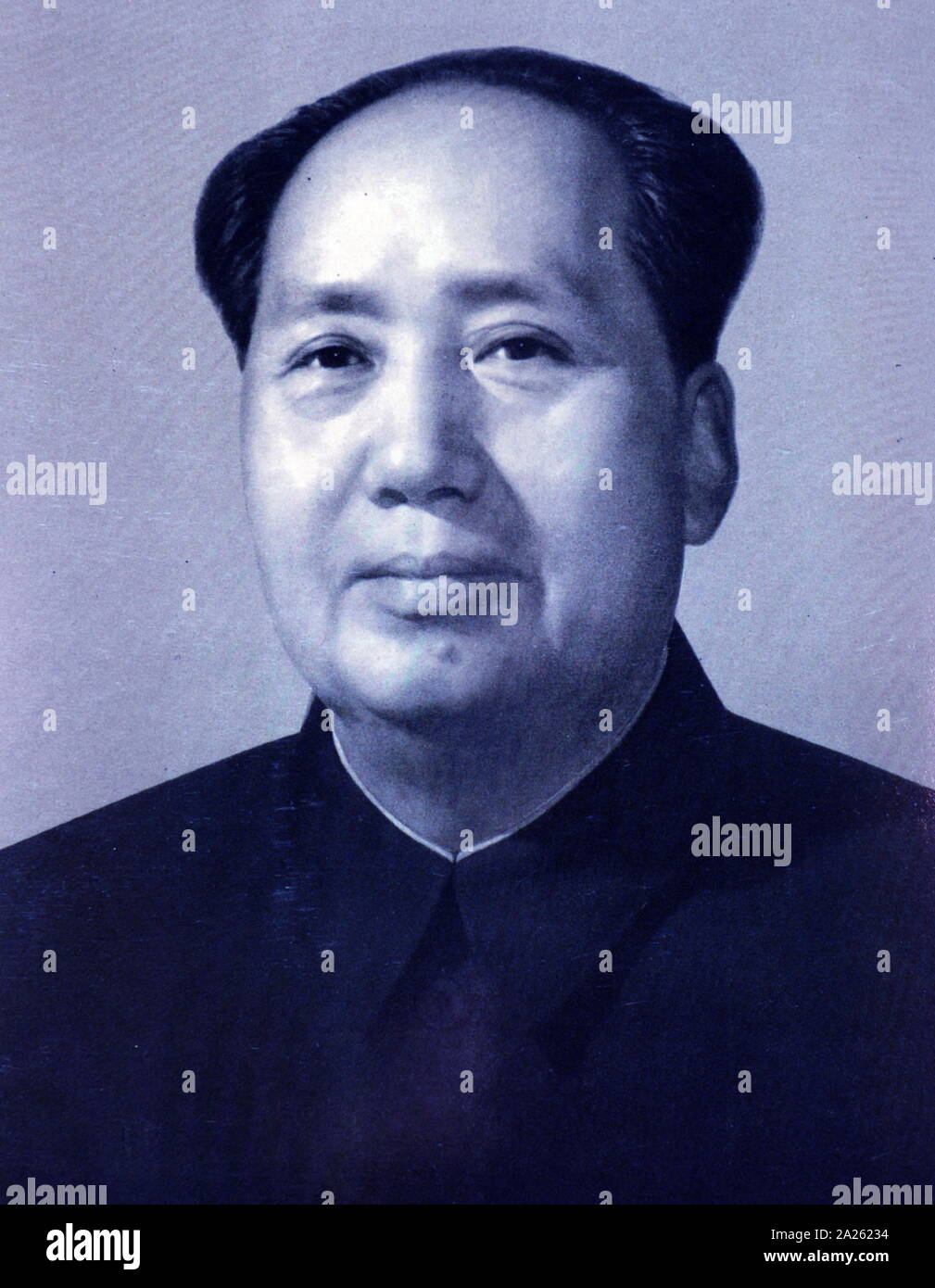 Chairman Mao in Beijing, in 1967. Mao Zedong (1893 - September 9, 1976), was a Chinese communist revolutionary who became the founding father of the People's Republic of China (PRC), which he ruled as the Chairman of the Communist Party of China from its establishment in 1949 until his death Stock Photohttps://www.alamy.com/image-license-details/?v=1https://www.alamy.com/chairman-mao-in-beijing-in-1967-mao-zedong-1893-september-9-1976-was-a-chinese-communist-revolutionary-who-became-the-founding-father-of-the-peoples-republic-of-china-prc-which-he-ruled-as-the-chairman-of-the-communist-party-of-china-from-its-establishment-in-1949-until-his-death-image328359672.html
Chairman Mao in Beijing, in 1967. Mao Zedong (1893 - September 9, 1976), was a Chinese communist revolutionary who became the founding father of the People's Republic of China (PRC), which he ruled as the Chairman of the Communist Party of China from its establishment in 1949 until his death Stock Photohttps://www.alamy.com/image-license-details/?v=1https://www.alamy.com/chairman-mao-in-beijing-in-1967-mao-zedong-1893-september-9-1976-was-a-chinese-communist-revolutionary-who-became-the-founding-father-of-the-peoples-republic-of-china-prc-which-he-ruled-as-the-chairman-of-the-communist-party-of-china-from-its-establishment-in-1949-until-his-death-image328359672.htmlRM2A26234–Chairman Mao in Beijing, in 1967. Mao Zedong (1893 - September 9, 1976), was a Chinese communist revolutionary who became the founding father of the People's Republic of China (PRC), which he ruled as the Chairman of the Communist Party of China from its establishment in 1949 until his death
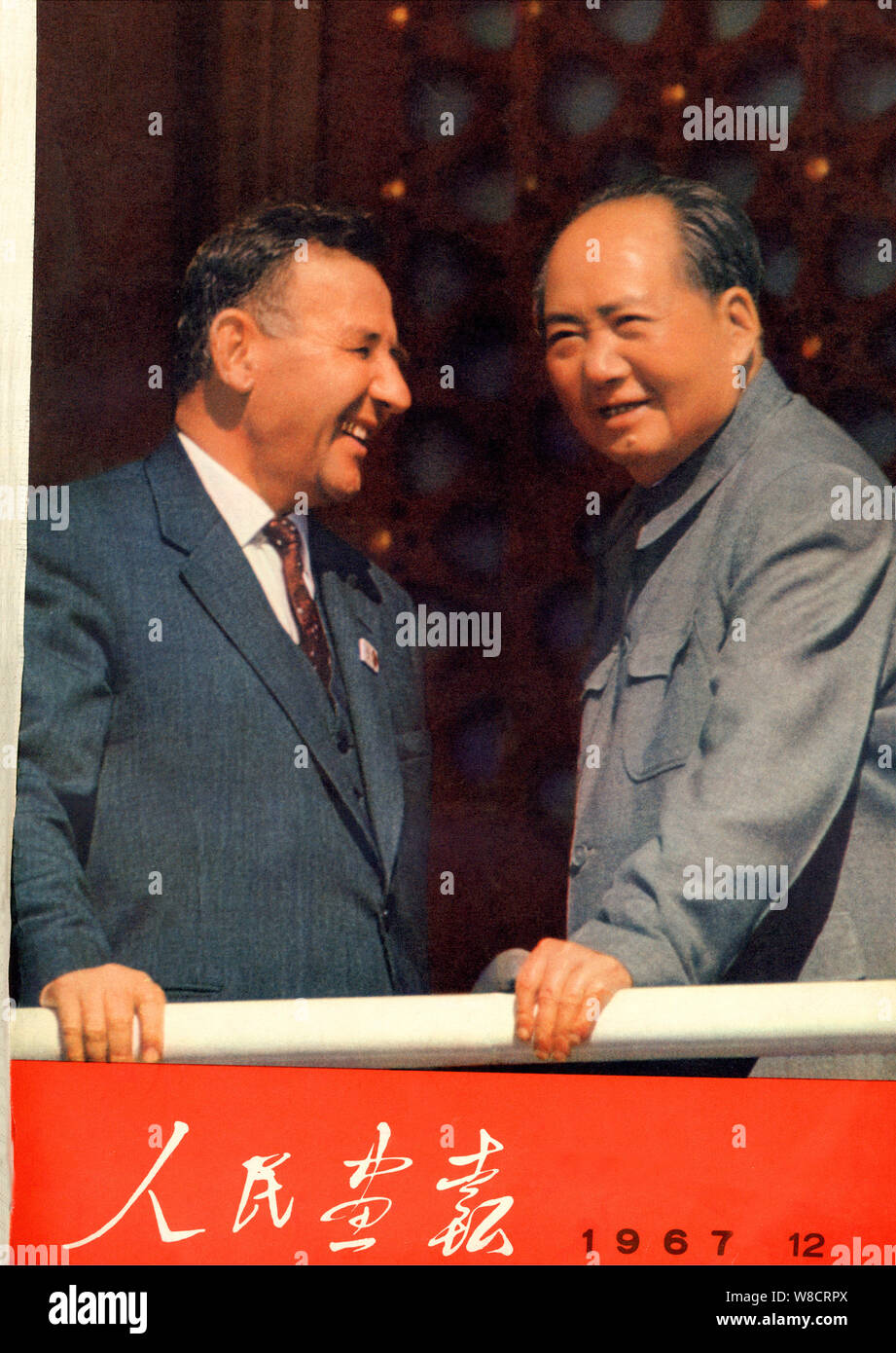 This cover of the China Pictorial 12th issue in 1967 features Chinese leader Chairman Mao Zedong, right, and Mehmet Ismail Shehu, then member of the C Stock Photohttps://www.alamy.com/image-license-details/?v=1https://www.alamy.com/this-cover-of-the-china-pictorial-12th-issue-in-1967-features-chinese-leader-chairman-mao-zedong-right-and-mehmet-ismail-shehu-then-member-of-the-c-image263354866.html
This cover of the China Pictorial 12th issue in 1967 features Chinese leader Chairman Mao Zedong, right, and Mehmet Ismail Shehu, then member of the C Stock Photohttps://www.alamy.com/image-license-details/?v=1https://www.alamy.com/this-cover-of-the-china-pictorial-12th-issue-in-1967-features-chinese-leader-chairman-mao-zedong-right-and-mehmet-ismail-shehu-then-member-of-the-c-image263354866.htmlRMW8CRPX–This cover of the China Pictorial 12th issue in 1967 features Chinese leader Chairman Mao Zedong, right, and Mehmet Ismail Shehu, then member of the C
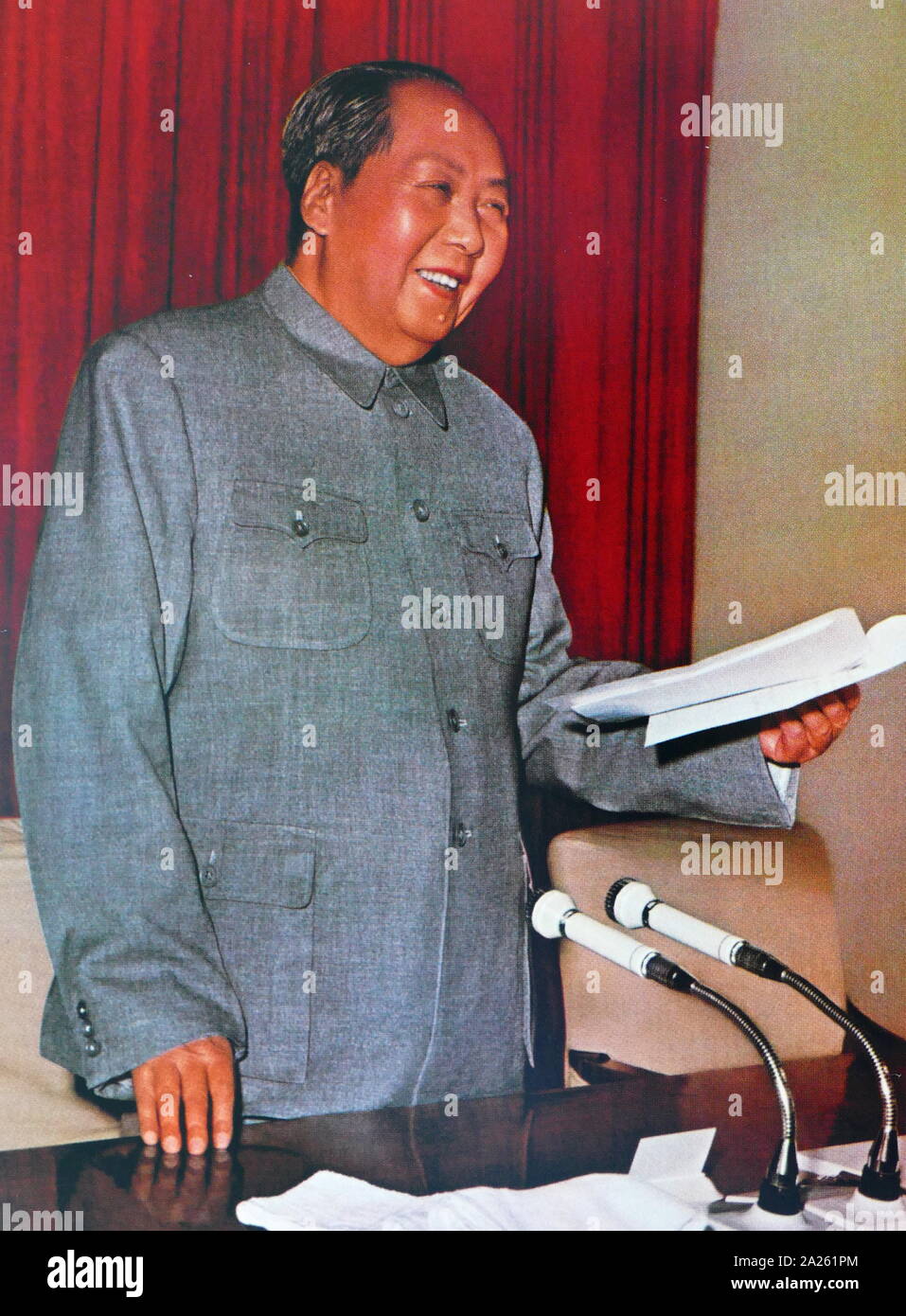 Chairman Mao in Beijing. (1967). Mao Zedong (1893 - 1976), also known as Chairman Mao, was a Chinese communist revolutionary who became the founding father of the People's Republic of China (PRC), which he ruled as the Chairman of the Communist Party of China from its establishment in 1949 until his death in 1976. Stock Photohttps://www.alamy.com/image-license-details/?v=1https://www.alamy.com/chairman-mao-in-beijing-1967-mao-zedong-1893-1976-also-known-as-chairman-mao-was-a-chinese-communist-revolutionary-who-became-the-founding-father-of-the-peoples-republic-of-china-prc-which-he-ruled-as-the-chairman-of-the-communist-party-of-china-from-its-establishment-in-1949-until-his-death-in-1976-image328359436.html
Chairman Mao in Beijing. (1967). Mao Zedong (1893 - 1976), also known as Chairman Mao, was a Chinese communist revolutionary who became the founding father of the People's Republic of China (PRC), which he ruled as the Chairman of the Communist Party of China from its establishment in 1949 until his death in 1976. Stock Photohttps://www.alamy.com/image-license-details/?v=1https://www.alamy.com/chairman-mao-in-beijing-1967-mao-zedong-1893-1976-also-known-as-chairman-mao-was-a-chinese-communist-revolutionary-who-became-the-founding-father-of-the-peoples-republic-of-china-prc-which-he-ruled-as-the-chairman-of-the-communist-party-of-china-from-its-establishment-in-1949-until-his-death-in-1976-image328359436.htmlRM2A261PM–Chairman Mao in Beijing. (1967). Mao Zedong (1893 - 1976), also known as Chairman Mao, was a Chinese communist revolutionary who became the founding father of the People's Republic of China (PRC), which he ruled as the Chairman of the Communist Party of China from its establishment in 1949 until his death in 1976.
 This cover of the China Pictorial 10th issue in 1967 features Mao Zedong after arriving in the Northern Shaanxi province following the completion of t Stock Photohttps://www.alamy.com/image-license-details/?v=1https://www.alamy.com/this-cover-of-the-china-pictorial-10th-issue-in-1967-features-mao-zedong-after-arriving-in-the-northern-shaanxi-province-following-the-completion-of-t-image263354870.html
This cover of the China Pictorial 10th issue in 1967 features Mao Zedong after arriving in the Northern Shaanxi province following the completion of t Stock Photohttps://www.alamy.com/image-license-details/?v=1https://www.alamy.com/this-cover-of-the-china-pictorial-10th-issue-in-1967-features-mao-zedong-after-arriving-in-the-northern-shaanxi-province-following-the-completion-of-t-image263354870.htmlRMW8CRR2–This cover of the China Pictorial 10th issue in 1967 features Mao Zedong after arriving in the Northern Shaanxi province following the completion of t
 Chairman Mao in Beijing. (1967). Mao Zedong (1893 - 1976), also known as Chairman Mao, was a Chinese communist revolutionary who became the founding father of the People's Republic of China (PRC), which he ruled as the Chairman of the Communist Party of China from its establishment in 1949 until his death in 1976. Stock Photohttps://www.alamy.com/image-license-details/?v=1https://www.alamy.com/chairman-mao-in-beijing-1967-mao-zedong-1893-1976-also-known-as-chairman-mao-was-a-chinese-communist-revolutionary-who-became-the-founding-father-of-the-peoples-republic-of-china-prc-which-he-ruled-as-the-chairman-of-the-communist-party-of-china-from-its-establishment-in-1949-until-his-death-in-1976-image328359489.html
Chairman Mao in Beijing. (1967). Mao Zedong (1893 - 1976), also known as Chairman Mao, was a Chinese communist revolutionary who became the founding father of the People's Republic of China (PRC), which he ruled as the Chairman of the Communist Party of China from its establishment in 1949 until his death in 1976. Stock Photohttps://www.alamy.com/image-license-details/?v=1https://www.alamy.com/chairman-mao-in-beijing-1967-mao-zedong-1893-1976-also-known-as-chairman-mao-was-a-chinese-communist-revolutionary-who-became-the-founding-father-of-the-peoples-republic-of-china-prc-which-he-ruled-as-the-chairman-of-the-communist-party-of-china-from-its-establishment-in-1949-until-his-death-in-1976-image328359489.htmlRM2A261TH–Chairman Mao in Beijing. (1967). Mao Zedong (1893 - 1976), also known as Chairman Mao, was a Chinese communist revolutionary who became the founding father of the People's Republic of China (PRC), which he ruled as the Chairman of the Communist Party of China from its establishment in 1949 until his death in 1976.
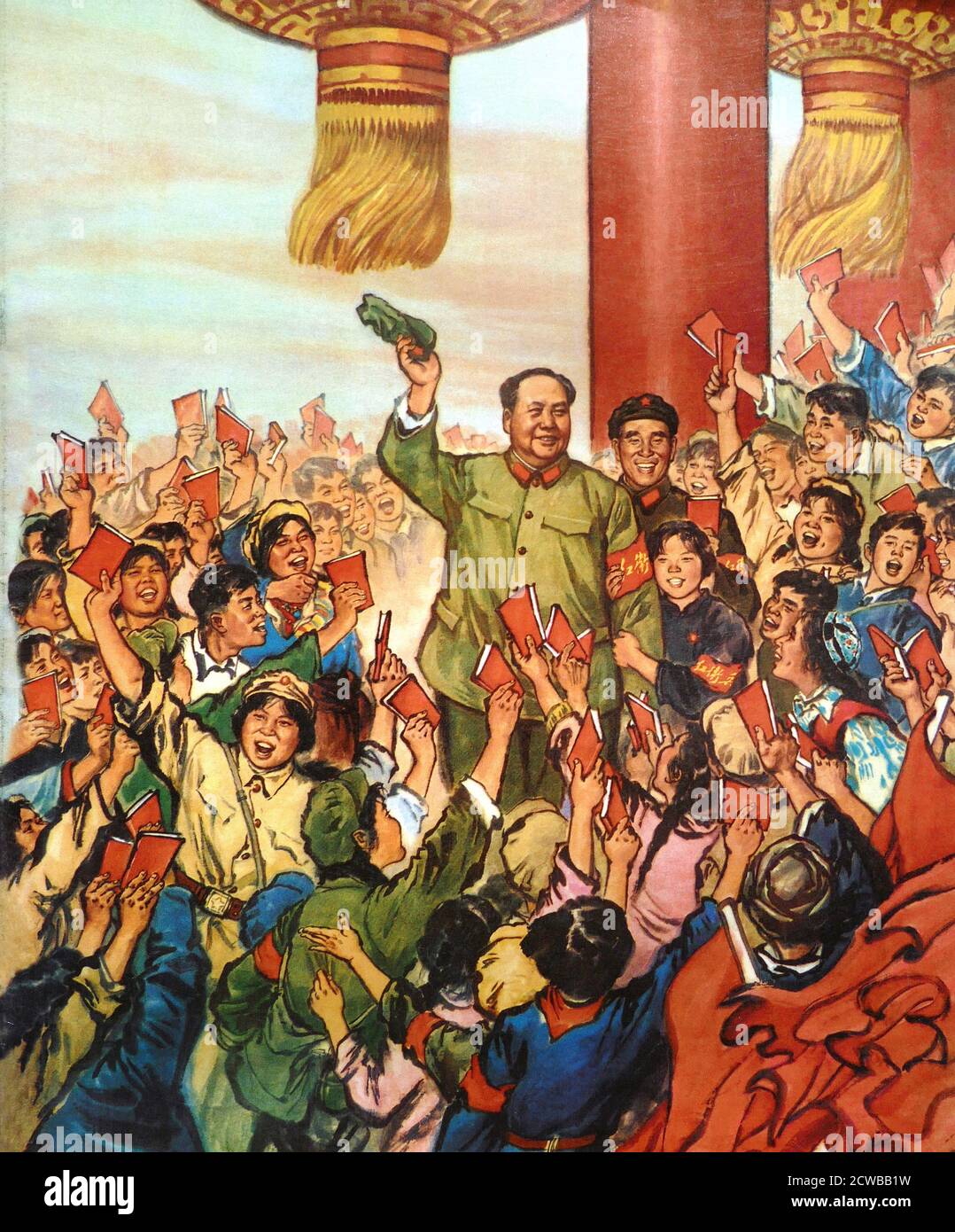 A propaganda image of Mao Zedong with Red Guards, seen holding 'The Thoughts of Chairman Mao'. Beijing 1967. The Red Guards were a mass student-led paramilitary social movement mobilized and guided by Mao Zedong in 1966 and 1967, during the first phase of the Chinese Cultural Revolution, which he had instituted. Stock Photohttps://www.alamy.com/image-license-details/?v=1https://www.alamy.com/a-propaganda-image-of-mao-zedong-with-red-guards-seen-holding-the-thoughts-of-chairman-mao-beijing-1967-the-red-guards-were-a-mass-student-led-paramilitary-social-movement-mobilized-and-guided-by-mao-zedong-in-1966-and-1967-during-the-first-phase-of-the-chinese-cultural-revolution-which-he-had-instituted-image377034277.html
A propaganda image of Mao Zedong with Red Guards, seen holding 'The Thoughts of Chairman Mao'. Beijing 1967. The Red Guards were a mass student-led paramilitary social movement mobilized and guided by Mao Zedong in 1966 and 1967, during the first phase of the Chinese Cultural Revolution, which he had instituted. Stock Photohttps://www.alamy.com/image-license-details/?v=1https://www.alamy.com/a-propaganda-image-of-mao-zedong-with-red-guards-seen-holding-the-thoughts-of-chairman-mao-beijing-1967-the-red-guards-were-a-mass-student-led-paramilitary-social-movement-mobilized-and-guided-by-mao-zedong-in-1966-and-1967-during-the-first-phase-of-the-chinese-cultural-revolution-which-he-had-instituted-image377034277.htmlRM2CWBB1W–A propaganda image of Mao Zedong with Red Guards, seen holding 'The Thoughts of Chairman Mao'. Beijing 1967. The Red Guards were a mass student-led paramilitary social movement mobilized and guided by Mao Zedong in 1966 and 1967, during the first phase of the Chinese Cultural Revolution, which he had instituted.
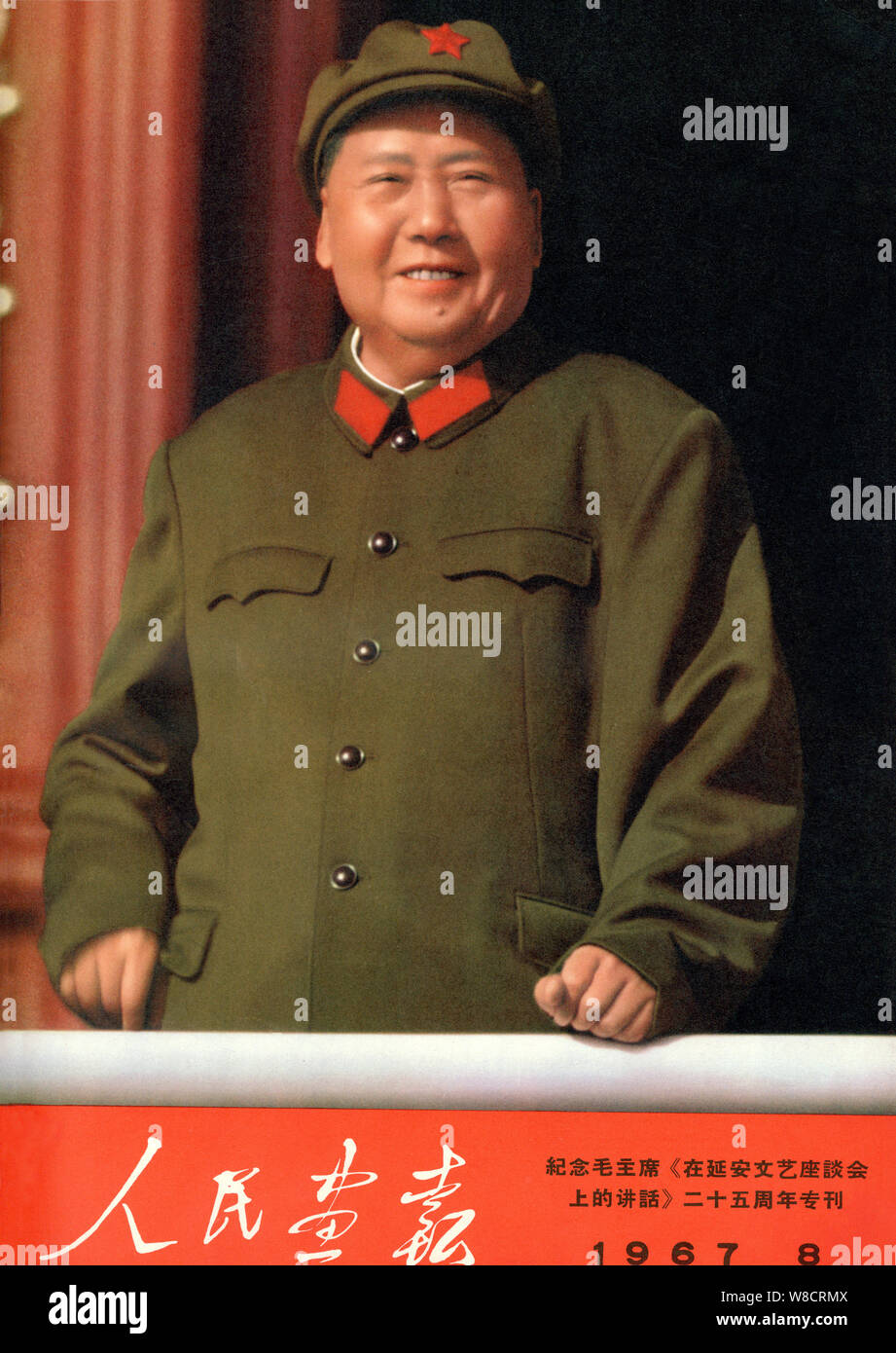 This cover of the China Pictorial 8th issue in 1967 features Chinese leader Chairman Mao Zedong standing on the Tiananmen Rostrum in Beijing. Stock Photohttps://www.alamy.com/image-license-details/?v=1https://www.alamy.com/this-cover-of-the-china-pictorial-8th-issue-in-1967-features-chinese-leader-chairman-mao-zedong-standing-on-the-tiananmen-rostrum-in-beijing-image263354810.html
This cover of the China Pictorial 8th issue in 1967 features Chinese leader Chairman Mao Zedong standing on the Tiananmen Rostrum in Beijing. Stock Photohttps://www.alamy.com/image-license-details/?v=1https://www.alamy.com/this-cover-of-the-china-pictorial-8th-issue-in-1967-features-chinese-leader-chairman-mao-zedong-standing-on-the-tiananmen-rostrum-in-beijing-image263354810.htmlRMW8CRMX–This cover of the China Pictorial 8th issue in 1967 features Chinese leader Chairman Mao Zedong standing on the Tiananmen Rostrum in Beijing.
 Mao Zedong in March of 1967 Stock Photohttps://www.alamy.com/image-license-details/?v=1https://www.alamy.com/mao-zedong-in-march-of-1967-image481968484.html
Mao Zedong in March of 1967 Stock Photohttps://www.alamy.com/image-license-details/?v=1https://www.alamy.com/mao-zedong-in-march-of-1967-image481968484.htmlRM2K03FM4–Mao Zedong in March of 1967
 Chinese peasants celebrate with portraits of Chairman Mao. 1967 Stock Photohttps://www.alamy.com/image-license-details/?v=1https://www.alamy.com/chinese-peasants-celebrate-with-portraits-of-chairman-mao-1967-image328359521.html
Chinese peasants celebrate with portraits of Chairman Mao. 1967 Stock Photohttps://www.alamy.com/image-license-details/?v=1https://www.alamy.com/chinese-peasants-celebrate-with-portraits-of-chairman-mao-1967-image328359521.htmlRM2A261WN–Chinese peasants celebrate with portraits of Chairman Mao. 1967
 This cover of the China Pictorial 1st issue in 1967 features Chinese leader Chairman Mao Zedong reviewing a military parade on the Tiananmen Rostrum i Stock Photohttps://www.alamy.com/image-license-details/?v=1https://www.alamy.com/this-cover-of-the-china-pictorial-1st-issue-in-1967-features-chinese-leader-chairman-mao-zedong-reviewing-a-military-parade-on-the-tiananmen-rostrum-i-image263354899.html
This cover of the China Pictorial 1st issue in 1967 features Chinese leader Chairman Mao Zedong reviewing a military parade on the Tiananmen Rostrum i Stock Photohttps://www.alamy.com/image-license-details/?v=1https://www.alamy.com/this-cover-of-the-china-pictorial-1st-issue-in-1967-features-chinese-leader-chairman-mao-zedong-reviewing-a-military-parade-on-the-tiananmen-rostrum-i-image263354899.htmlRMW8CRT3–This cover of the China Pictorial 1st issue in 1967 features Chinese leader Chairman Mao Zedong reviewing a military parade on the Tiananmen Rostrum i
 Chinese navy cadets, during the Cultural Revolution. China 1967 Stock Photohttps://www.alamy.com/image-license-details/?v=1https://www.alamy.com/chinese-navy-cadets-during-the-cultural-revolution-china-1967-image328359560.html
Chinese navy cadets, during the Cultural Revolution. China 1967 Stock Photohttps://www.alamy.com/image-license-details/?v=1https://www.alamy.com/chinese-navy-cadets-during-the-cultural-revolution-china-1967-image328359560.htmlRM2A261Y4–Chinese navy cadets, during the Cultural Revolution. China 1967
 Chinese navy mechanic during the Cultural Revolution. China 1967 Stock Photohttps://www.alamy.com/image-license-details/?v=1https://www.alamy.com/chinese-navy-mechanic-during-the-cultural-revolution-china-1967-image328359564.html
Chinese navy mechanic during the Cultural Revolution. China 1967 Stock Photohttps://www.alamy.com/image-license-details/?v=1https://www.alamy.com/chinese-navy-mechanic-during-the-cultural-revolution-china-1967-image328359564.htmlRM2A261Y8–Chinese navy mechanic during the Cultural Revolution. China 1967
 class of the Department of Mathematics of Wuhan University, during the Cultural Revolution. China 1967 Stock Photohttps://www.alamy.com/image-license-details/?v=1https://www.alamy.com/class-of-the-department-of-mathematics-of-wuhan-university-during-the-cultural-revolution-china-1967-image328359586.html
class of the Department of Mathematics of Wuhan University, during the Cultural Revolution. China 1967 Stock Photohttps://www.alamy.com/image-license-details/?v=1https://www.alamy.com/class-of-the-department-of-mathematics-of-wuhan-university-during-the-cultural-revolution-china-1967-image328359586.htmlRM2A26202–class of the Department of Mathematics of Wuhan University, during the Cultural Revolution. China 1967
 During the height of the cultural Revolution in China, crowds gather to read announcements pasted on a wall. 1967 Stock Photohttps://www.alamy.com/image-license-details/?v=1https://www.alamy.com/during-the-height-of-the-cultural-revolution-in-china-crowds-gather-to-read-announcements-pasted-on-a-wall-1967-image328359467.html
During the height of the cultural Revolution in China, crowds gather to read announcements pasted on a wall. 1967 Stock Photohttps://www.alamy.com/image-license-details/?v=1https://www.alamy.com/during-the-height-of-the-cultural-revolution-in-china-crowds-gather-to-read-announcements-pasted-on-a-wall-1967-image328359467.htmlRM2A261RR–During the height of the cultural Revolution in China, crowds gather to read announcements pasted on a wall. 1967
 Lin Biao with Mao Zedong (Chinese leader), 1967. Lin Biao (1907 - 1971). Lin became instrumental in creating the foundations for Mao Zedong's cult of personality, and was rewarded in the Cultural Revolution by being named Mao's designated successor. Lin died on September 13, 1971. Stock Photohttps://www.alamy.com/image-license-details/?v=1https://www.alamy.com/lin-biao-with-mao-zedong-chinese-leader-1967-lin-biao-1907-1971-lin-became-instrumental-in-creating-the-foundations-for-mao-zedongs-cult-of-personality-and-was-rewarded-in-the-cultural-revolution-by-being-named-maos-designated-successor-lin-died-on-september-13-1971-image328359628.html
Lin Biao with Mao Zedong (Chinese leader), 1967. Lin Biao (1907 - 1971). Lin became instrumental in creating the foundations for Mao Zedong's cult of personality, and was rewarded in the Cultural Revolution by being named Mao's designated successor. Lin died on September 13, 1971. Stock Photohttps://www.alamy.com/image-license-details/?v=1https://www.alamy.com/lin-biao-with-mao-zedong-chinese-leader-1967-lin-biao-1907-1971-lin-became-instrumental-in-creating-the-foundations-for-mao-zedongs-cult-of-personality-and-was-rewarded-in-the-cultural-revolution-by-being-named-maos-designated-successor-lin-died-on-september-13-1971-image328359628.htmlRM2A2621G–Lin Biao with Mao Zedong (Chinese leader), 1967. Lin Biao (1907 - 1971). Lin became instrumental in creating the foundations for Mao Zedong's cult of personality, and was rewarded in the Cultural Revolution by being named Mao's designated successor. Lin died on September 13, 1971.
 Lin Biao with Mao Zedong (Chinese leader), 1967. Lin Biao (1907 - 1971). Lin became instrumental in creating the foundations for Mao Zedong's cult of personality, and was rewarded in the Cultural Revolution by being named Mao's designated successor. Lin died on September 13, 1971. Stock Photohttps://www.alamy.com/image-license-details/?v=1https://www.alamy.com/lin-biao-with-mao-zedong-chinese-leader-1967-lin-biao-1907-1971-lin-became-instrumental-in-creating-the-foundations-for-mao-zedongs-cult-of-personality-and-was-rewarded-in-the-cultural-revolution-by-being-named-maos-designated-successor-lin-died-on-september-13-1971-image328359656.html
Lin Biao with Mao Zedong (Chinese leader), 1967. Lin Biao (1907 - 1971). Lin became instrumental in creating the foundations for Mao Zedong's cult of personality, and was rewarded in the Cultural Revolution by being named Mao's designated successor. Lin died on September 13, 1971. Stock Photohttps://www.alamy.com/image-license-details/?v=1https://www.alamy.com/lin-biao-with-mao-zedong-chinese-leader-1967-lin-biao-1907-1971-lin-became-instrumental-in-creating-the-foundations-for-mao-zedongs-cult-of-personality-and-was-rewarded-in-the-cultural-revolution-by-being-named-maos-designated-successor-lin-died-on-september-13-1971-image328359656.htmlRM2A2622G–Lin Biao with Mao Zedong (Chinese leader), 1967. Lin Biao (1907 - 1971). Lin became instrumental in creating the foundations for Mao Zedong's cult of personality, and was rewarded in the Cultural Revolution by being named Mao's designated successor. Lin died on September 13, 1971.
 Chairman Mao in Beijing, in 1967. Mao Zedong (1893 – September 9, 1976), was a Chinese communist revolutionary who became the founding father of the People's Republic of China (PRC), which he ruled as the Chairman of the Communist Party of China from its establishment in 1949 until his death Stock Photohttps://www.alamy.com/image-license-details/?v=1https://www.alamy.com/chairman-mao-in-beijing-in-1967-mao-zedong-1893-september-9-1976-was-a-chinese-communist-revolutionary-who-became-the-founding-father-of-the-peoples-republic-of-china-prc-which-he-ruled-as-the-chairman-of-the-communist-party-of-china-from-its-establishment-in-1949-until-his-death-image328368484.html
Chairman Mao in Beijing, in 1967. Mao Zedong (1893 – September 9, 1976), was a Chinese communist revolutionary who became the founding father of the People's Republic of China (PRC), which he ruled as the Chairman of the Communist Party of China from its establishment in 1949 until his death Stock Photohttps://www.alamy.com/image-license-details/?v=1https://www.alamy.com/chairman-mao-in-beijing-in-1967-mao-zedong-1893-september-9-1976-was-a-chinese-communist-revolutionary-who-became-the-founding-father-of-the-peoples-republic-of-china-prc-which-he-ruled-as-the-chairman-of-the-communist-party-of-china-from-its-establishment-in-1949-until-his-death-image328368484.htmlRM2A26D9T–Chairman Mao in Beijing, in 1967. Mao Zedong (1893 – September 9, 1976), was a Chinese communist revolutionary who became the founding father of the People's Republic of China (PRC), which he ruled as the Chairman of the Communist Party of China from its establishment in 1949 until his death
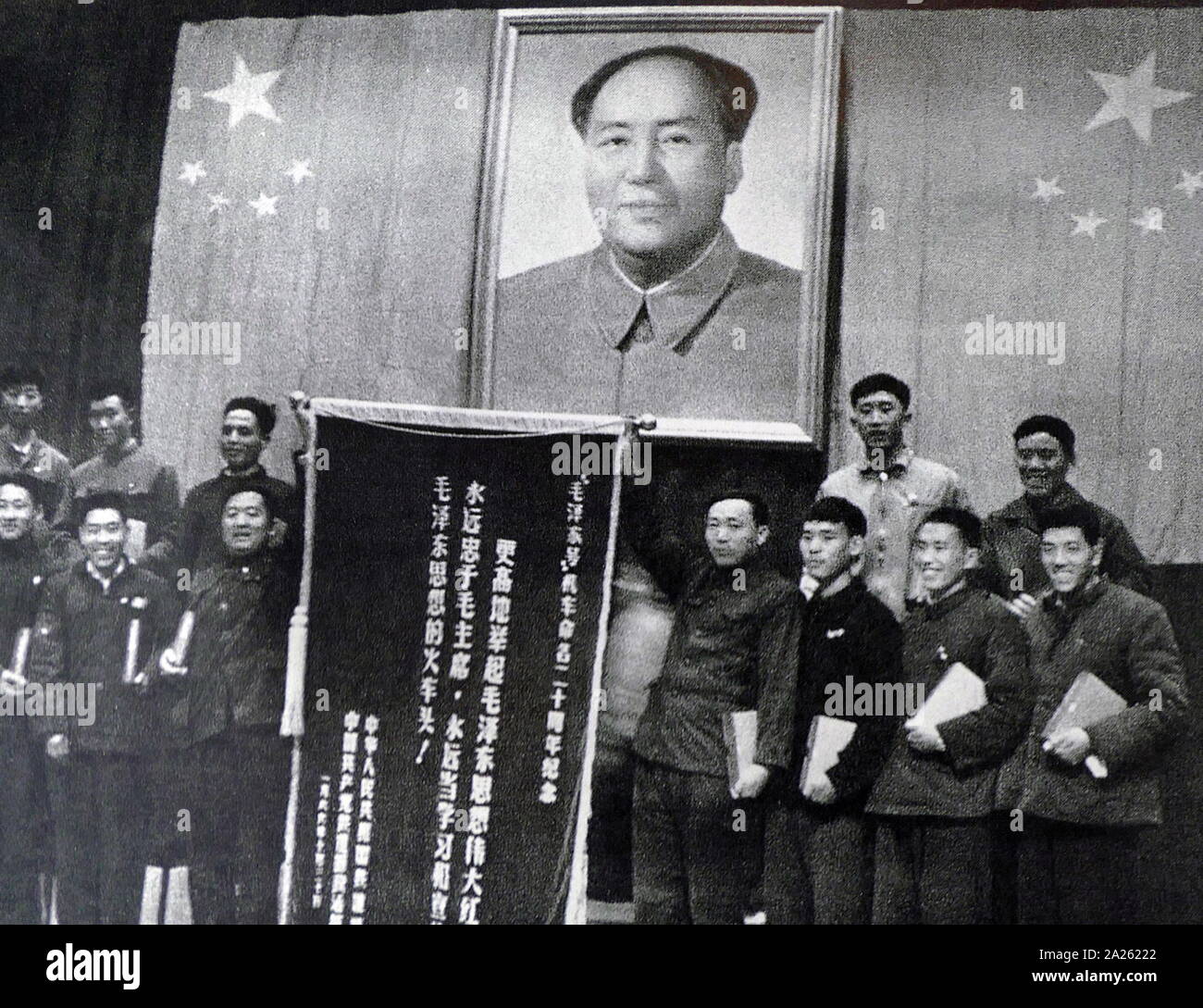 Red Guards with a portrait of Mao Zedong, during the Cultural Revolution. China 1967 Stock Photohttps://www.alamy.com/image-license-details/?v=1https://www.alamy.com/red-guards-with-a-portrait-of-mao-zedong-during-the-cultural-revolution-china-1967-image328359642.html
Red Guards with a portrait of Mao Zedong, during the Cultural Revolution. China 1967 Stock Photohttps://www.alamy.com/image-license-details/?v=1https://www.alamy.com/red-guards-with-a-portrait-of-mao-zedong-during-the-cultural-revolution-china-1967-image328359642.htmlRM2A26222–Red Guards with a portrait of Mao Zedong, during the Cultural Revolution. China 1967
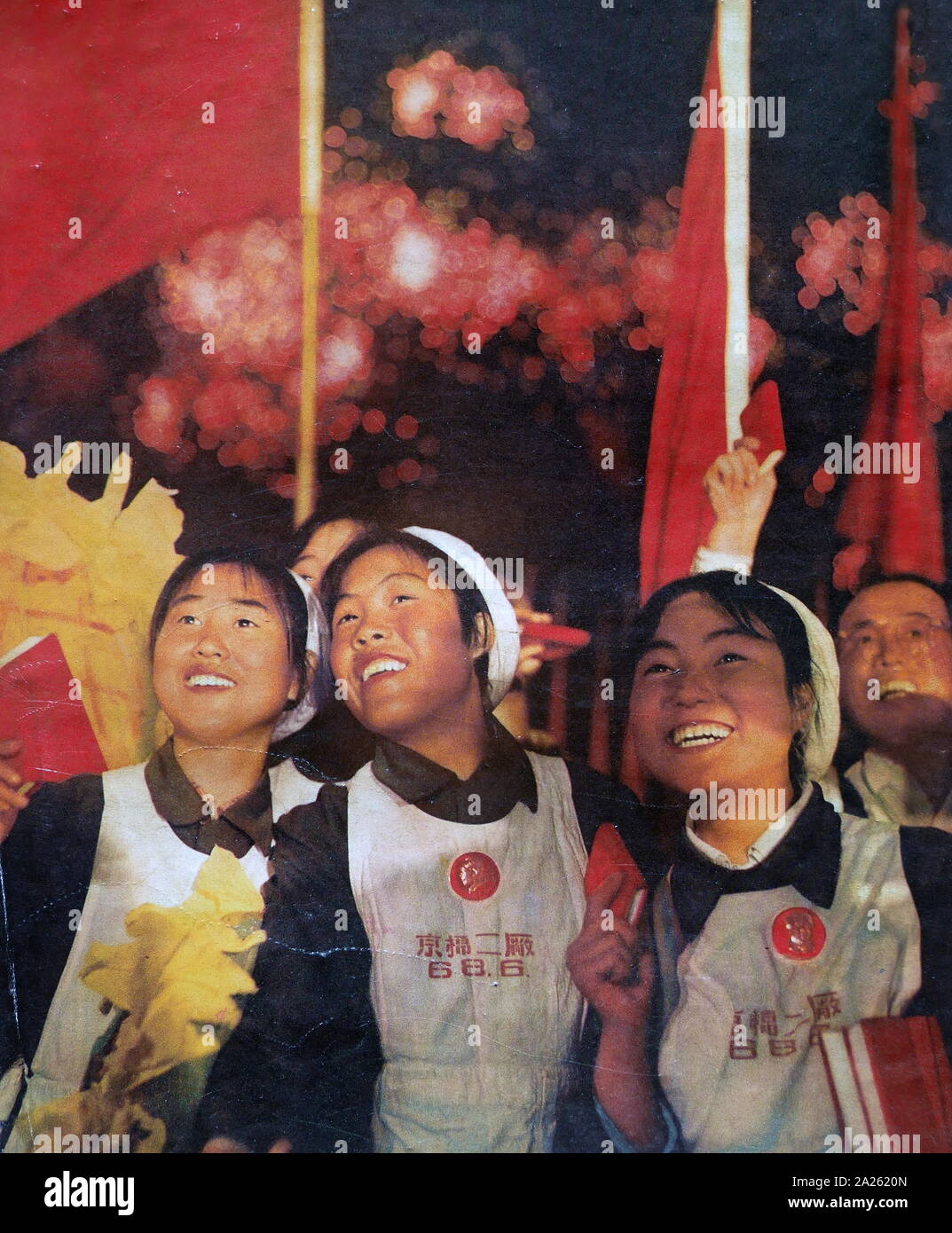 Red Guards in Tiananmen Square Beijing holding copies of the 'thoughts of chairman Mao', during the Cultural Revolution. China 1967 Stock Photohttps://www.alamy.com/image-license-details/?v=1https://www.alamy.com/red-guards-in-tiananmen-square-beijing-holding-copies-of-the-thoughts-of-chairman-mao-during-the-cultural-revolution-china-1967-image328359605.html
Red Guards in Tiananmen Square Beijing holding copies of the 'thoughts of chairman Mao', during the Cultural Revolution. China 1967 Stock Photohttps://www.alamy.com/image-license-details/?v=1https://www.alamy.com/red-guards-in-tiananmen-square-beijing-holding-copies-of-the-thoughts-of-chairman-mao-during-the-cultural-revolution-china-1967-image328359605.htmlRM2A2620N–Red Guards in Tiananmen Square Beijing holding copies of the 'thoughts of chairman Mao', during the Cultural Revolution. China 1967
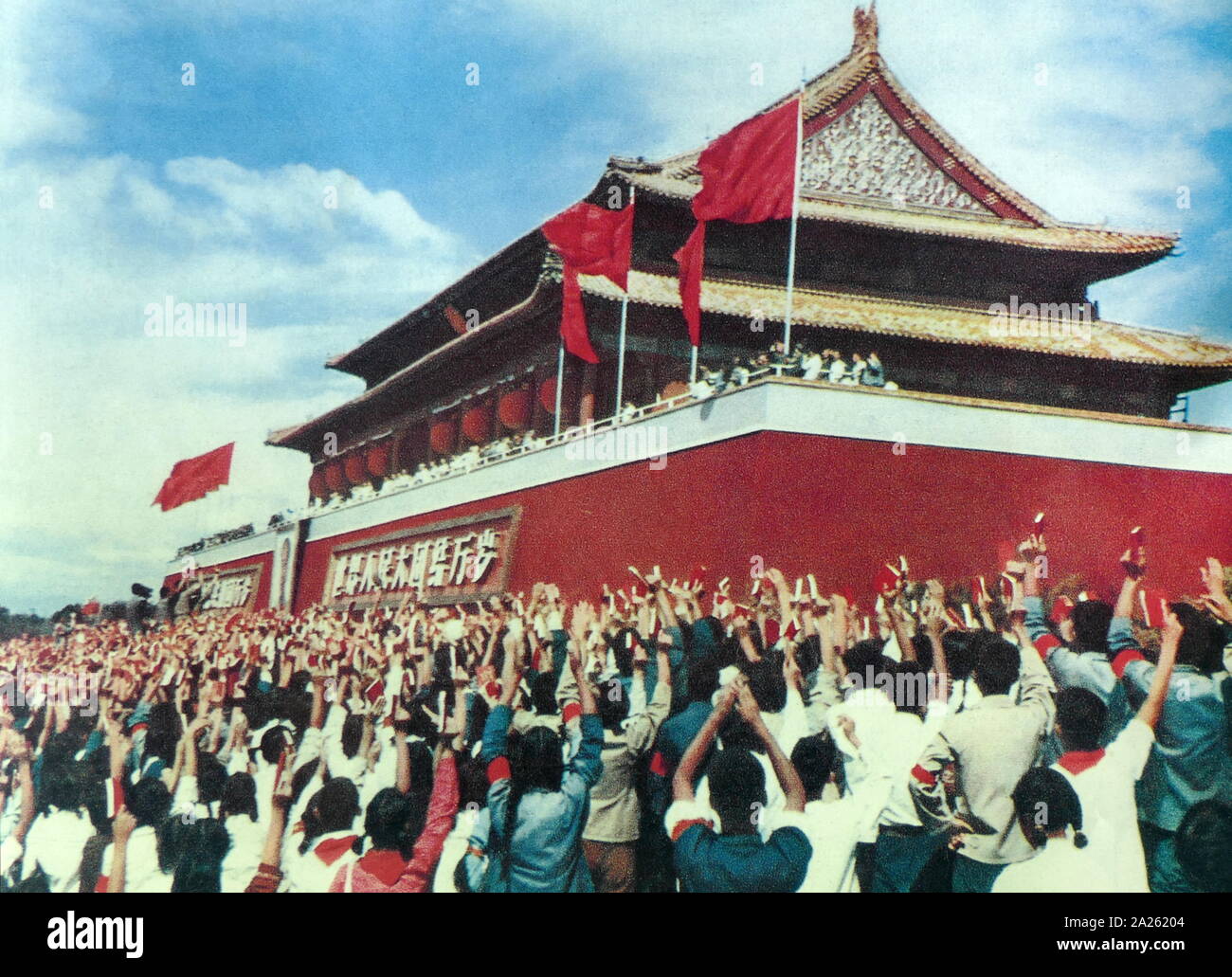 Red Guards in Tiananmen Square Beijing holding copies of the 'thoughts of chairman Mao', during the Cultural Revolution. China 1967 Stock Photohttps://www.alamy.com/image-license-details/?v=1https://www.alamy.com/red-guards-in-tiananmen-square-beijing-holding-copies-of-the-thoughts-of-chairman-mao-during-the-cultural-revolution-china-1967-image328359588.html
Red Guards in Tiananmen Square Beijing holding copies of the 'thoughts of chairman Mao', during the Cultural Revolution. China 1967 Stock Photohttps://www.alamy.com/image-license-details/?v=1https://www.alamy.com/red-guards-in-tiananmen-square-beijing-holding-copies-of-the-thoughts-of-chairman-mao-during-the-cultural-revolution-china-1967-image328359588.htmlRM2A26204–Red Guards in Tiananmen Square Beijing holding copies of the 'thoughts of chairman Mao', during the Cultural Revolution. China 1967
 Red Guards in Tiananmen Square Beijing holding copies of the 'thoughts of chairman Mao', during the Cultural Revolution. China 1967 Stock Photohttps://www.alamy.com/image-license-details/?v=1https://www.alamy.com/red-guards-in-tiananmen-square-beijing-holding-copies-of-the-thoughts-of-chairman-mao-during-the-cultural-revolution-china-1967-image328359602.html
Red Guards in Tiananmen Square Beijing holding copies of the 'thoughts of chairman Mao', during the Cultural Revolution. China 1967 Stock Photohttps://www.alamy.com/image-license-details/?v=1https://www.alamy.com/red-guards-in-tiananmen-square-beijing-holding-copies-of-the-thoughts-of-chairman-mao-during-the-cultural-revolution-china-1967-image328359602.htmlRM2A2620J–Red Guards in Tiananmen Square Beijing holding copies of the 'thoughts of chairman Mao', during the Cultural Revolution. China 1967
 Red Guards in Tiananmen Square Beijing holding copies of the 'thoughts of chairman Mao', during the Cultural Revolution. China 1967 Stock Photohttps://www.alamy.com/image-license-details/?v=1https://www.alamy.com/red-guards-in-tiananmen-square-beijing-holding-copies-of-the-thoughts-of-chairman-mao-during-the-cultural-revolution-china-1967-image328359620.html
Red Guards in Tiananmen Square Beijing holding copies of the 'thoughts of chairman Mao', during the Cultural Revolution. China 1967 Stock Photohttps://www.alamy.com/image-license-details/?v=1https://www.alamy.com/red-guards-in-tiananmen-square-beijing-holding-copies-of-the-thoughts-of-chairman-mao-during-the-cultural-revolution-china-1967-image328359620.htmlRM2A26218–Red Guards in Tiananmen Square Beijing holding copies of the 'thoughts of chairman Mao', during the Cultural Revolution. China 1967
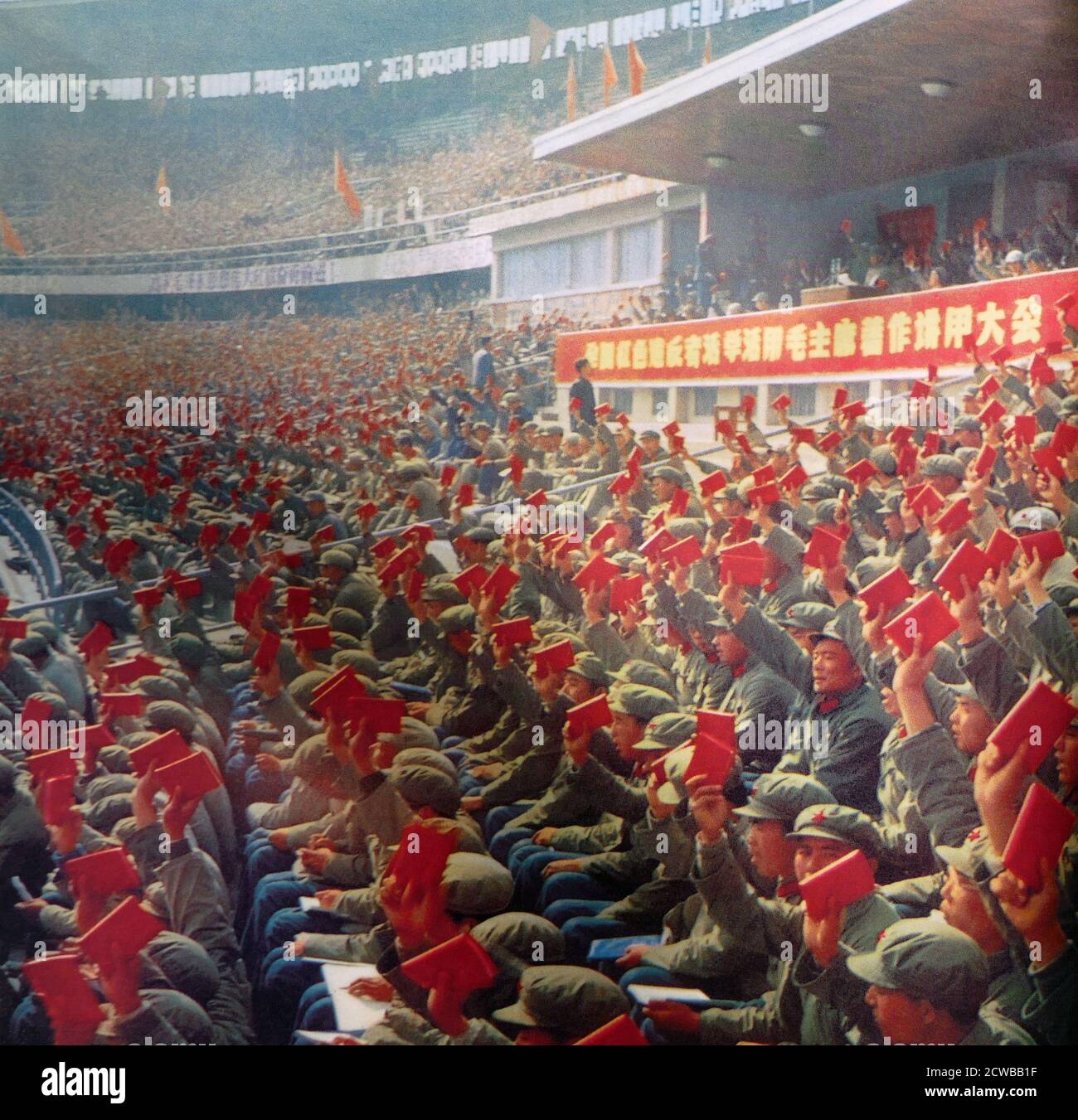 Chairman Mao's 'Little Red Book of quotations' held by a crowd of Red Guards, Beijing 1966. The Red Guards were a mass student-led paramilitary social movement mobilized and guided by Mao Zedong in 1966 and 1967, during the first phase of the Chinese Cultural Revolution Stock Photohttps://www.alamy.com/image-license-details/?v=1https://www.alamy.com/chairman-maos-little-red-book-of-quotations-held-by-a-crowd-of-red-guards-beijing-1966-the-red-guards-were-a-mass-student-led-paramilitary-social-movement-mobilized-and-guided-by-mao-zedong-in-1966-and-1967-during-the-first-phase-of-the-chinese-cultural-revolution-image377034267.html
Chairman Mao's 'Little Red Book of quotations' held by a crowd of Red Guards, Beijing 1966. The Red Guards were a mass student-led paramilitary social movement mobilized and guided by Mao Zedong in 1966 and 1967, during the first phase of the Chinese Cultural Revolution Stock Photohttps://www.alamy.com/image-license-details/?v=1https://www.alamy.com/chairman-maos-little-red-book-of-quotations-held-by-a-crowd-of-red-guards-beijing-1966-the-red-guards-were-a-mass-student-led-paramilitary-social-movement-mobilized-and-guided-by-mao-zedong-in-1966-and-1967-during-the-first-phase-of-the-chinese-cultural-revolution-image377034267.htmlRM2CWBB1F–Chairman Mao's 'Little Red Book of quotations' held by a crowd of Red Guards, Beijing 1966. The Red Guards were a mass student-led paramilitary social movement mobilized and guided by Mao Zedong in 1966 and 1967, during the first phase of the Chinese Cultural Revolution
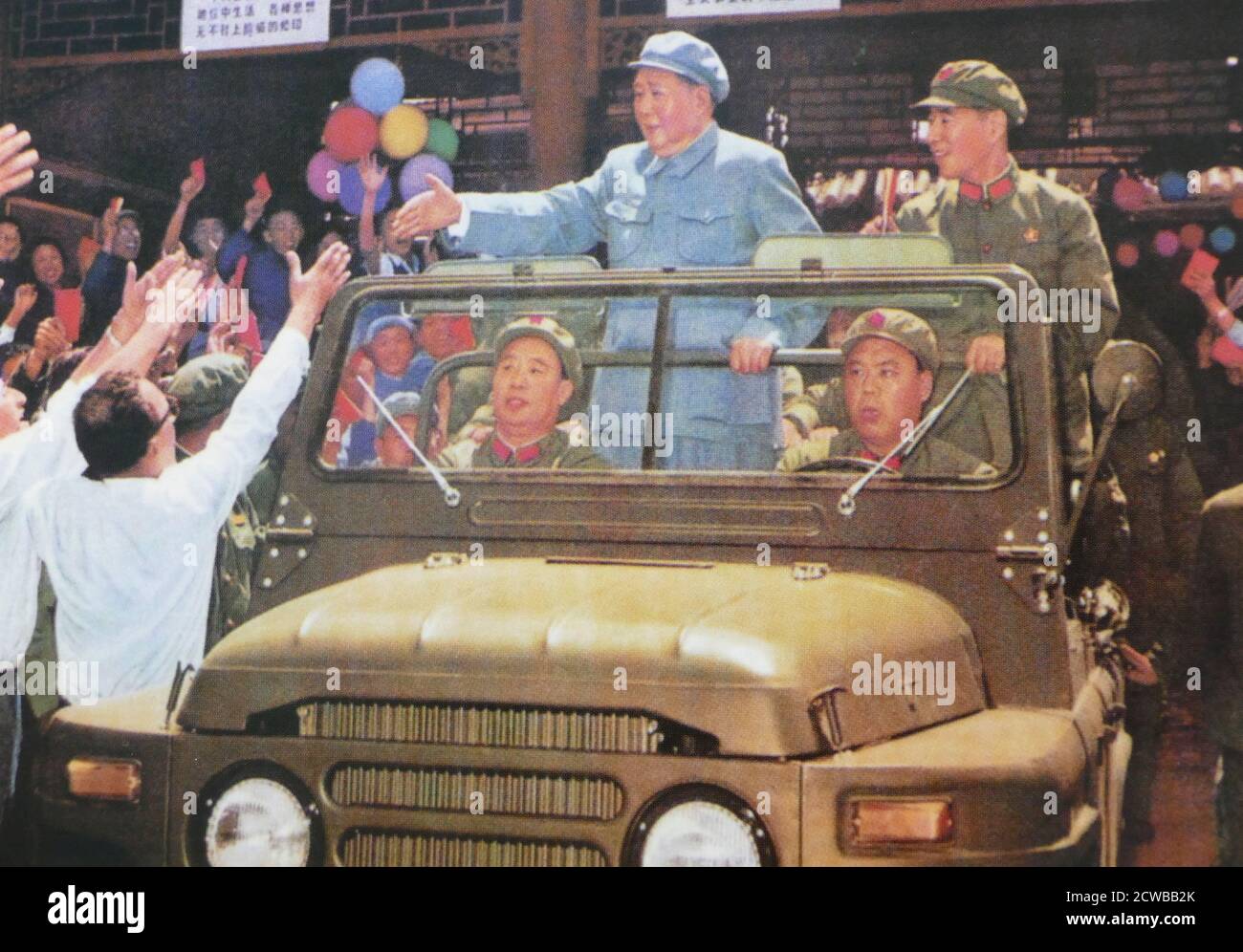 On May 1, 1967, Chairman Mao and Vice Chairman Lin Biao, celebrate the May 1st International Labour Day, with the capital's military and civilians in Beijing. Lin Biao (1907 - 1971). Lin became instrumental in creating the foundations for Mao Zedong's cult of personality, and was rewarded in the Cultural Revolution by being named Mao's designated successor. Lin died on September 13, 1971. The exact events of this 'Lin Biao incident' have been a source of speculation ever since. The Chinese government's official explanation is that Lin and his family attempted to flee following a botched coup a Stock Photohttps://www.alamy.com/image-license-details/?v=1https://www.alamy.com/on-may-1-1967-chairman-mao-and-vice-chairman-lin-biao-celebrate-the-may-1st-international-labour-day-with-the-capitals-military-and-civilians-in-beijing-lin-biao-1907-1971-lin-became-instrumental-in-creating-the-foundations-for-mao-zedongs-cult-of-personality-and-was-rewarded-in-the-cultural-revolution-by-being-named-maos-designated-successor-lin-died-on-september-13-1971-the-exact-events-of-this-lin-biao-incident-have-been-a-source-of-speculation-ever-since-the-chinese-governments-official-explanation-is-that-lin-and-his-family-attempted-to-flee-following-a-botched-coup-a-image377034299.html
On May 1, 1967, Chairman Mao and Vice Chairman Lin Biao, celebrate the May 1st International Labour Day, with the capital's military and civilians in Beijing. Lin Biao (1907 - 1971). Lin became instrumental in creating the foundations for Mao Zedong's cult of personality, and was rewarded in the Cultural Revolution by being named Mao's designated successor. Lin died on September 13, 1971. The exact events of this 'Lin Biao incident' have been a source of speculation ever since. The Chinese government's official explanation is that Lin and his family attempted to flee following a botched coup a Stock Photohttps://www.alamy.com/image-license-details/?v=1https://www.alamy.com/on-may-1-1967-chairman-mao-and-vice-chairman-lin-biao-celebrate-the-may-1st-international-labour-day-with-the-capitals-military-and-civilians-in-beijing-lin-biao-1907-1971-lin-became-instrumental-in-creating-the-foundations-for-mao-zedongs-cult-of-personality-and-was-rewarded-in-the-cultural-revolution-by-being-named-maos-designated-successor-lin-died-on-september-13-1971-the-exact-events-of-this-lin-biao-incident-have-been-a-source-of-speculation-ever-since-the-chinese-governments-official-explanation-is-that-lin-and-his-family-attempted-to-flee-following-a-botched-coup-a-image377034299.htmlRM2CWBB2K–On May 1, 1967, Chairman Mao and Vice Chairman Lin Biao, celebrate the May 1st International Labour Day, with the capital's military and civilians in Beijing. Lin Biao (1907 - 1971). Lin became instrumental in creating the foundations for Mao Zedong's cult of personality, and was rewarded in the Cultural Revolution by being named Mao's designated successor. Lin died on September 13, 1971. The exact events of this 'Lin Biao incident' have been a source of speculation ever since. The Chinese government's official explanation is that Lin and his family attempted to flee following a botched coup a
 Mao Zedong posters in a motorcade of Red Guards. teenagers from various ethnic groups such as Uyghur, Kazakh, and Uzbek in Xinjiang Stock Photohttps://www.alamy.com/image-license-details/?v=1https://www.alamy.com/mao-zedong-posters-in-a-motorcade-of-red-guards-teenagers-from-various-ethnic-groups-such-as-uyghur-kazakh-and-uzbek-in-xinjiang-image186420037.html
Mao Zedong posters in a motorcade of Red Guards. teenagers from various ethnic groups such as Uyghur, Kazakh, and Uzbek in Xinjiang Stock Photohttps://www.alamy.com/image-license-details/?v=1https://www.alamy.com/mao-zedong-posters-in-a-motorcade-of-red-guards-teenagers-from-various-ethnic-groups-such-as-uyghur-kazakh-and-uzbek-in-xinjiang-image186420037.htmlRMMR84JD–Mao Zedong posters in a motorcade of Red Guards. teenagers from various ethnic groups such as Uyghur, Kazakh, and Uzbek in Xinjiang
 during the Cultural Revolution, in China, red guards dismantle old store name on Nanjing Road 3 in Shanghai and replaced it with a new one. 1967 Stock Photohttps://www.alamy.com/image-license-details/?v=1https://www.alamy.com/during-the-cultural-revolution-in-china-red-guards-dismantle-old-store-name-on-nanjing-road-3-in-shanghai-and-replaced-it-with-a-new-one-1967-image328359501.html
during the Cultural Revolution, in China, red guards dismantle old store name on Nanjing Road 3 in Shanghai and replaced it with a new one. 1967 Stock Photohttps://www.alamy.com/image-license-details/?v=1https://www.alamy.com/during-the-cultural-revolution-in-china-red-guards-dismantle-old-store-name-on-nanjing-road-3-in-shanghai-and-replaced-it-with-a-new-one-1967-image328359501.htmlRM2A261W1–during the Cultural Revolution, in China, red guards dismantle old store name on Nanjing Road 3 in Shanghai and replaced it with a new one. 1967
 Red Guards greet Chairman Mao (centre) with Lin Biao, Zhou en Lai and Mao's wife, Jiang Qing (Right), during the cultural revolution 1967 Stock Photohttps://www.alamy.com/image-license-details/?v=1https://www.alamy.com/red-guards-greet-chairman-mao-centre-with-lin-biao-zhou-en-lai-and-maos-wife-jiang-qing-right-during-the-cultural-revolution-1967-image328359546.html
Red Guards greet Chairman Mao (centre) with Lin Biao, Zhou en Lai and Mao's wife, Jiang Qing (Right), during the cultural revolution 1967 Stock Photohttps://www.alamy.com/image-license-details/?v=1https://www.alamy.com/red-guards-greet-chairman-mao-centre-with-lin-biao-zhou-en-lai-and-maos-wife-jiang-qing-right-during-the-cultural-revolution-1967-image328359546.htmlRM2A261XJ–Red Guards greet Chairman Mao (centre) with Lin Biao, Zhou en Lai and Mao's wife, Jiang Qing (Right), during the cultural revolution 1967
 Chairman Mao in Guangzhou. (1961). Mao Zedong (1893 - September 9, 1976), was a Chinese communist revolutionary who became the founding father of the People's Republic of China (PRC), which he ruled as the Chairman of the Communist Party of China from its establishment in 1949 until his death Stock Photohttps://www.alamy.com/image-license-details/?v=1https://www.alamy.com/chairman-mao-in-guangzhou-1961-mao-zedong-1893-september-9-1976-was-a-chinese-communist-revolutionary-who-became-the-founding-father-of-the-peoples-republic-of-china-prc-which-he-ruled-as-the-chairman-of-the-communist-party-of-china-from-its-establishment-in-1949-until-his-death-image328359704.html
Chairman Mao in Guangzhou. (1961). Mao Zedong (1893 - September 9, 1976), was a Chinese communist revolutionary who became the founding father of the People's Republic of China (PRC), which he ruled as the Chairman of the Communist Party of China from its establishment in 1949 until his death Stock Photohttps://www.alamy.com/image-license-details/?v=1https://www.alamy.com/chairman-mao-in-guangzhou-1961-mao-zedong-1893-september-9-1976-was-a-chinese-communist-revolutionary-who-became-the-founding-father-of-the-peoples-republic-of-china-prc-which-he-ruled-as-the-chairman-of-the-communist-party-of-china-from-its-establishment-in-1949-until-his-death-image328359704.htmlRM2A26248–Chairman Mao in Guangzhou. (1961). Mao Zedong (1893 - September 9, 1976), was a Chinese communist revolutionary who became the founding father of the People's Republic of China (PRC), which he ruled as the Chairman of the Communist Party of China from its establishment in 1949 until his death
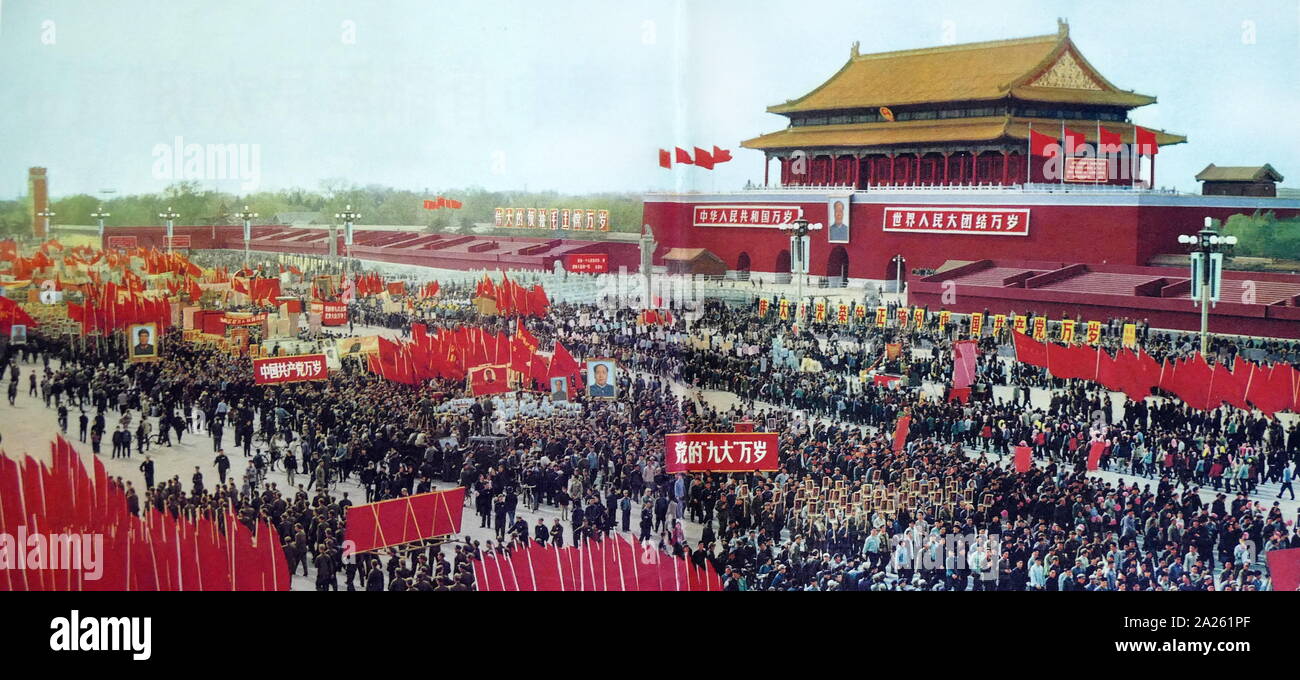 Propaganda photograph showing parade by Red Guards in Beijing 1967. Chairman Mao personally received more than 11 million Red Guards from all over the country. The Red Guards became the vanguard of the Cultural Revolution Stock Photohttps://www.alamy.com/image-license-details/?v=1https://www.alamy.com/propaganda-photograph-showing-parade-by-red-guards-in-beijing-1967-chairman-mao-personally-received-more-than-11-million-red-guards-from-all-over-the-country-the-red-guards-became-the-vanguard-of-the-cultural-revolution-image328359431.html
Propaganda photograph showing parade by Red Guards in Beijing 1967. Chairman Mao personally received more than 11 million Red Guards from all over the country. The Red Guards became the vanguard of the Cultural Revolution Stock Photohttps://www.alamy.com/image-license-details/?v=1https://www.alamy.com/propaganda-photograph-showing-parade-by-red-guards-in-beijing-1967-chairman-mao-personally-received-more-than-11-million-red-guards-from-all-over-the-country-the-red-guards-became-the-vanguard-of-the-cultural-revolution-image328359431.htmlRM2A261PF–Propaganda photograph showing parade by Red Guards in Beijing 1967. Chairman Mao personally received more than 11 million Red Guards from all over the country. The Red Guards became the vanguard of the Cultural Revolution
 delegates to the Chinese Peoples Congress, hold copies of the 'Little Red Book'. 1967 Stock Photohttps://www.alamy.com/image-license-details/?v=1https://www.alamy.com/delegates-to-the-chinese-peoples-congress-hold-copies-of-the-little-red-book-1967-image328359614.html
delegates to the Chinese Peoples Congress, hold copies of the 'Little Red Book'. 1967 Stock Photohttps://www.alamy.com/image-license-details/?v=1https://www.alamy.com/delegates-to-the-chinese-peoples-congress-hold-copies-of-the-little-red-book-1967-image328359614.htmlRM2A26212–delegates to the Chinese Peoples Congress, hold copies of the 'Little Red Book'. 1967
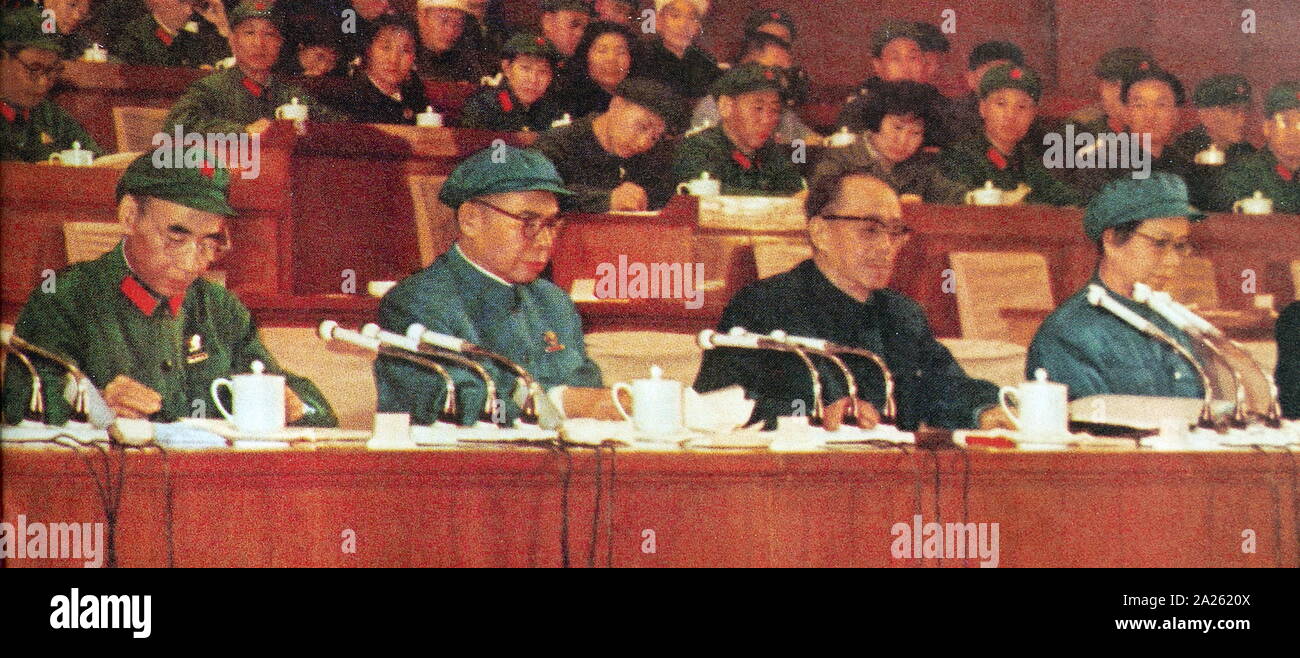 From left to right: Lin Biao, Jiang Qing, Chen Boda, Kang Sheng, during the cultural revolution 1967 Stock Photohttps://www.alamy.com/image-license-details/?v=1https://www.alamy.com/from-left-to-right-lin-biao-jiang-qing-chen-boda-kang-sheng-during-the-cultural-revolution-1967-image328359610.html
From left to right: Lin Biao, Jiang Qing, Chen Boda, Kang Sheng, during the cultural revolution 1967 Stock Photohttps://www.alamy.com/image-license-details/?v=1https://www.alamy.com/from-left-to-right-lin-biao-jiang-qing-chen-boda-kang-sheng-during-the-cultural-revolution-1967-image328359610.htmlRM2A2620X–From left to right: Lin Biao, Jiang Qing, Chen Boda, Kang Sheng, during the cultural revolution 1967
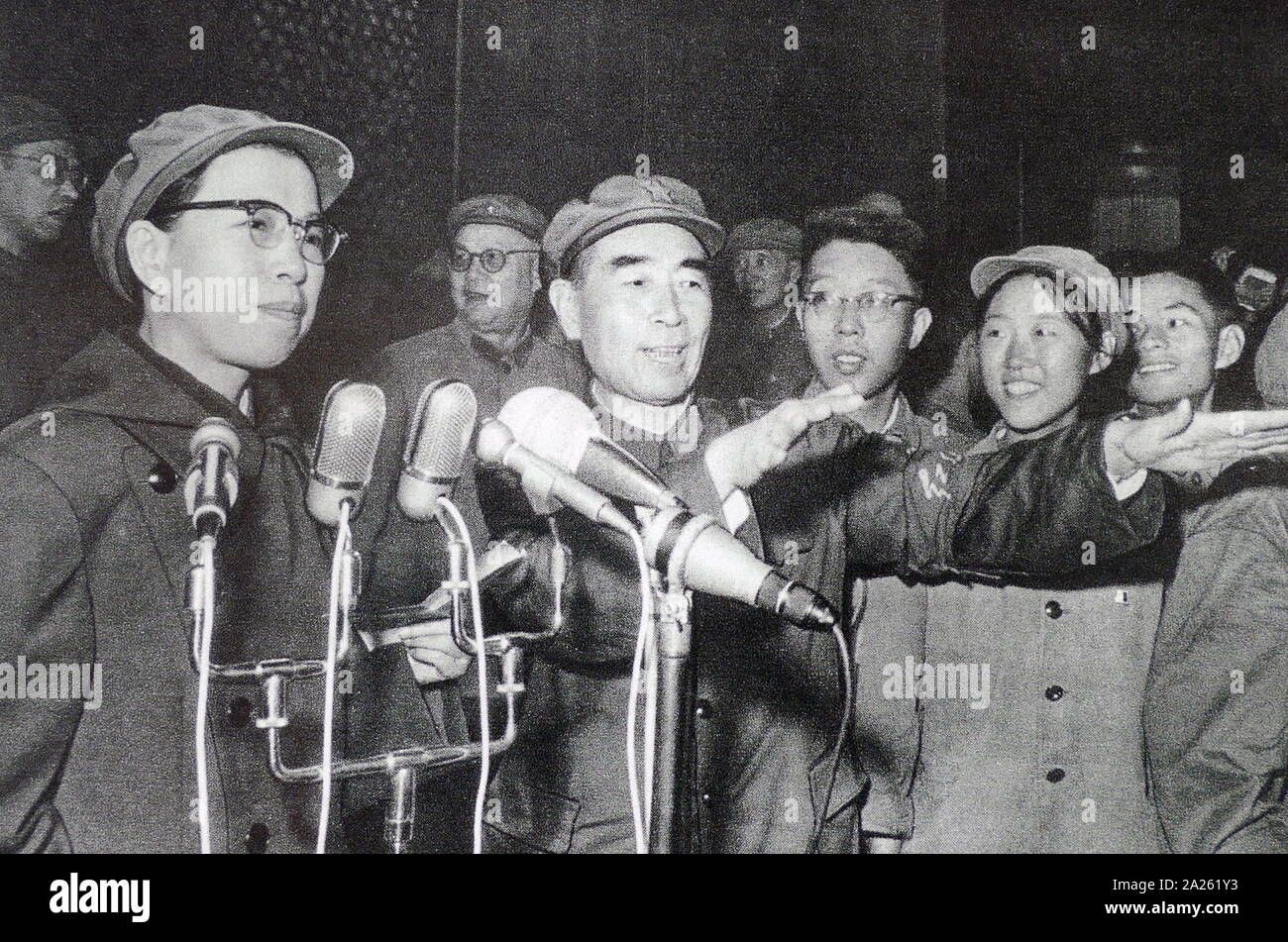 Chinese premier, Zhou en Lai and Mao's wife, Jiang Qing (left), during the cultural revolution 1967 Stock Photohttps://www.alamy.com/image-license-details/?v=1https://www.alamy.com/chinese-premier-zhou-en-lai-and-maos-wife-jiang-qing-left-during-the-cultural-revolution-1967-image328359559.html
Chinese premier, Zhou en Lai and Mao's wife, Jiang Qing (left), during the cultural revolution 1967 Stock Photohttps://www.alamy.com/image-license-details/?v=1https://www.alamy.com/chinese-premier-zhou-en-lai-and-maos-wife-jiang-qing-left-during-the-cultural-revolution-1967-image328359559.htmlRM2A261Y3–Chinese premier, Zhou en Lai and Mao's wife, Jiang Qing (left), during the cultural revolution 1967
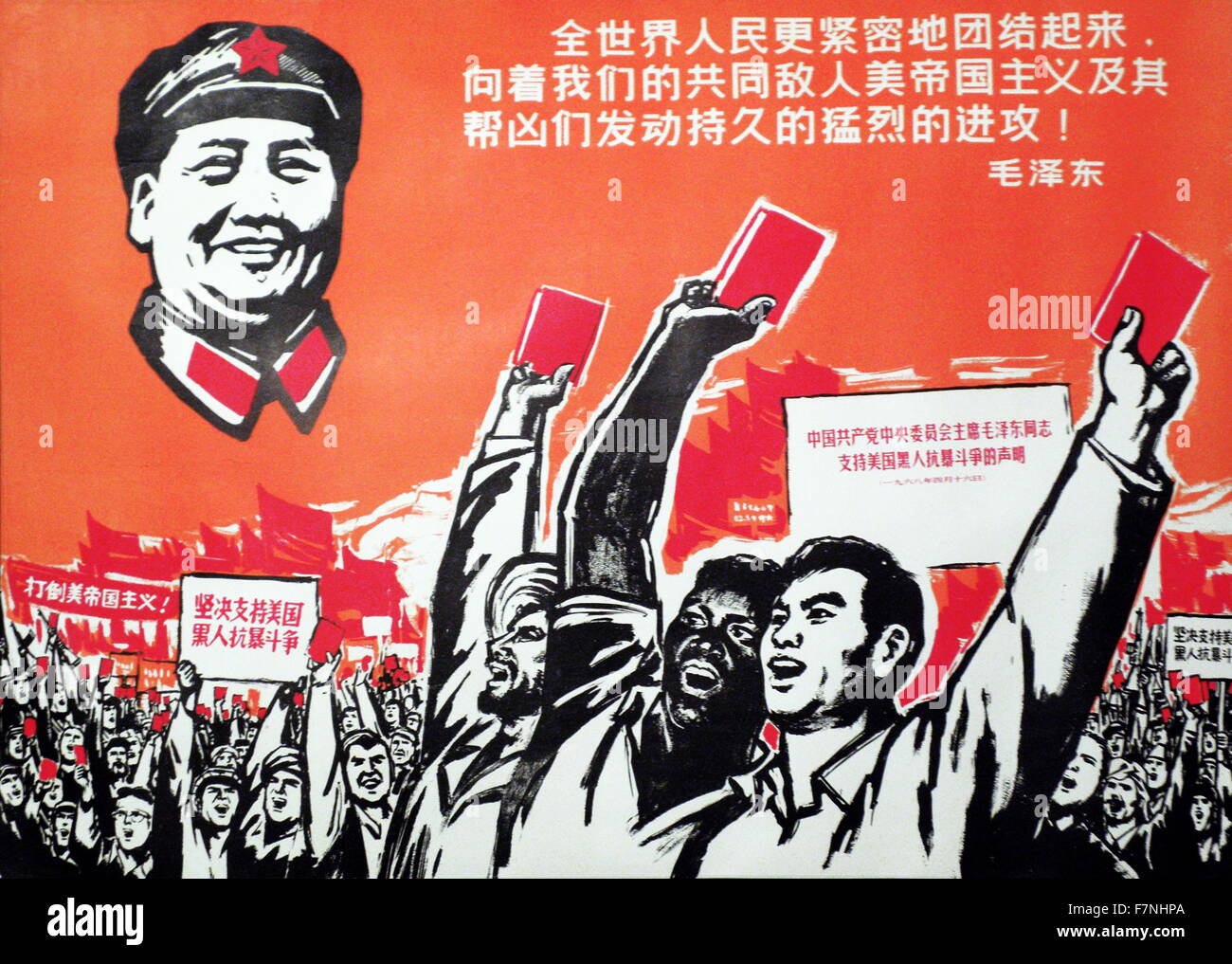 Chinese propaganda poster from the Korean, Chinese War. The Chinese caption reads: 'World people unite closely to attack continuously our common enemy US Imperialism and their followers'. Everyone is depicted to be holding Mao's Red Book. Dated 1967 Stock Photohttps://www.alamy.com/image-license-details/?v=1https://www.alamy.com/stock-photo-chinese-propaganda-poster-from-the-korean-chinese-war-the-chinese-90829378.html
Chinese propaganda poster from the Korean, Chinese War. The Chinese caption reads: 'World people unite closely to attack continuously our common enemy US Imperialism and their followers'. Everyone is depicted to be holding Mao's Red Book. Dated 1967 Stock Photohttps://www.alamy.com/image-license-details/?v=1https://www.alamy.com/stock-photo-chinese-propaganda-poster-from-the-korean-chinese-war-the-chinese-90829378.htmlRMF7NHPA–Chinese propaganda poster from the Korean, Chinese War. The Chinese caption reads: 'World people unite closely to attack continuously our common enemy US Imperialism and their followers'. Everyone is depicted to be holding Mao's Red Book. Dated 1967